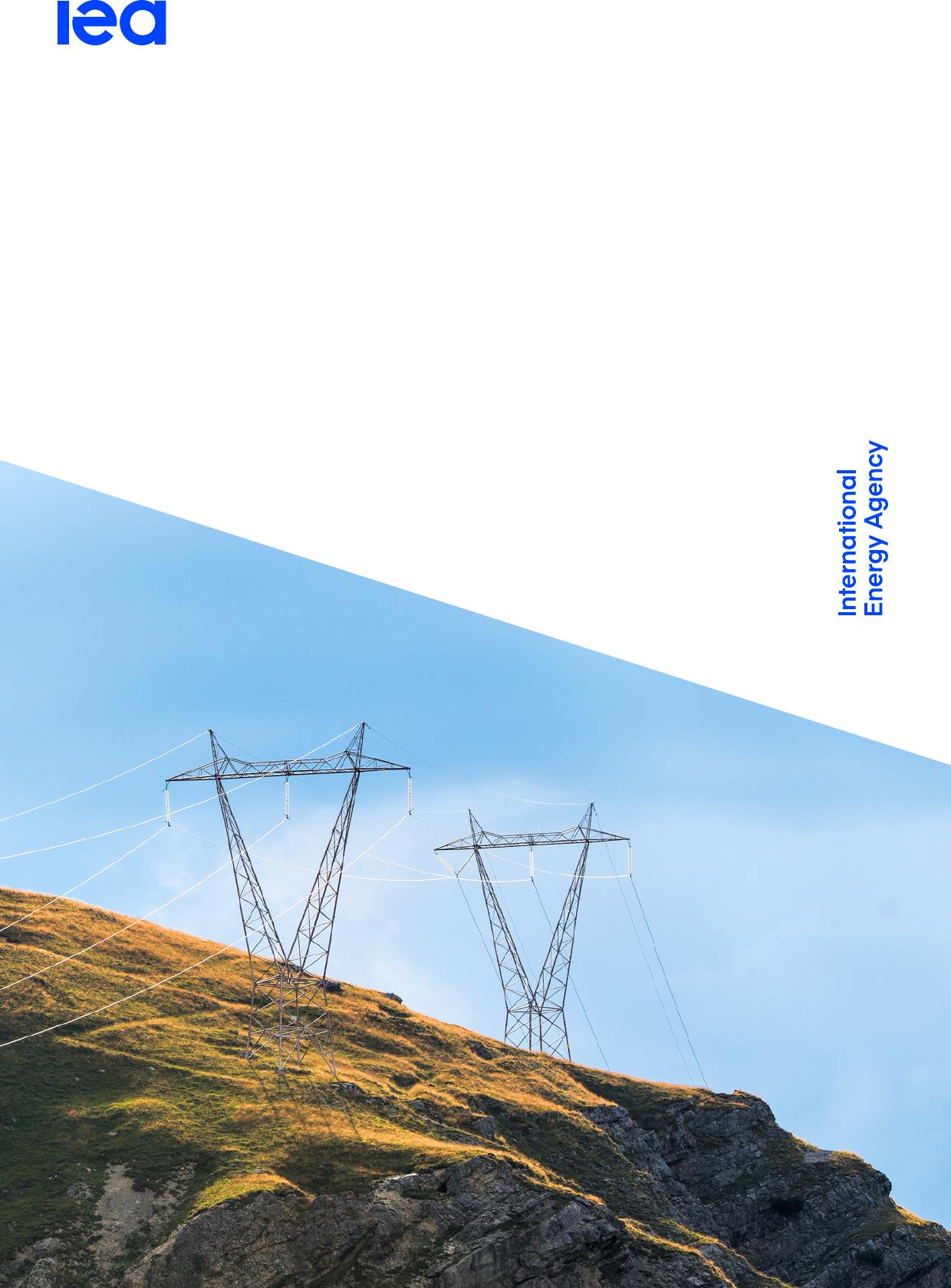ElectricityGridsandSecureEnergyTransitionsEnhancingthefoundationsofresilient,sustainableandaffordablepowersystemsINTERNATIONALENERGYAGENCYTheIEAexaminestheIEAmemberIEAassociationfullspectrumcountries:countries:ofenergyissuesincludingoil,gasandAustraliaArgentinacoalsupplyandAustriaBrazildemand,renewableBelgiumChinaenergytechnologies,CanadaEgyptelectricitymarkets,CzechRepublicIndiaenergyefficiency,DenmarkIndonesiaaccesstoenergy,EstoniaKenyademandsideFinlandMoroccomanagementandFranceSenegalmuchmore.ThroughGermanySingaporeitswork,theIEAGreeceSouthAfricaadvocatespoliciesthatHungaryThailandwillenhancetheIrelandUkrainereliability,affordabilityItalyandsustainabilityofJapanenergyinitsKorea31membercountries,Lithuania13associationLuxembourgcountriesandbeyond.MexicoNetherlandsThispublicationandanyNewZealandmapincludedhereinareNorwaywithoutprejudicetothePolandstatusoforsovereigntyoverPortugalanyterritory,totheSlovakRepublicdelimitationofinternationalSpainfrontiersandboundariesandSwedentothenameofanyterritory,Switzerlandcityorarea.RepublicofTürkiyeUnitedKingdomUnitedStatesTheEuropeanCommissionalsoparticipatesintheworkoftheIEASource:IEA.InternationalEnergyAgencyWebsite:www.iea.orgElectricityGridsandSecureEnergyTransitionsAbstractAbstractGridshavebeenthebackboneofelectricitysystemsformorethanacentury,underpinningeconomicactivitybybringingpowertohomes,industryandservices.Ascleanenergytransitionsadvance,theroleofelectricitywillbemoreprominent,makinggridsevenmoreimportantforsocietyandeconomies.Electrificationandrenewablesdeploymentarebothpickinguppace,butwithoutadequategridstoconnectthenewelectricitysupplywiththedemand,thereisariskthatcleanenergytransitionswillstall.Thisreportoffersaglobalstocktakeoftheworld’selectricitygridsastheystandtoday,takingadetailedlookatgridinfrastructure,connectionqueues,thecostofoutages,gridcongestion,generationcurtailment,andtimelinesforgriddevelopment.Wefindthattherearealreadysignstodaythatgridsarebecomingabottlenecktocleanenergytransitionsandanalysetheriskswefaceifgriddevelopmentandreformdonotadvancefastenough.Wefindthatdelayedactionmeansprolongingrelianceonfossilfuels,resultinginanincreaseinemissionsandcoststosociety.Anunprecedentedlevelofattentionfrompolicymakersandbusinessleadersisneededtoensuregridssupportcleanenergytransitionsandmaintainelectricitysecurity.Thereportconcludeswithkeyrecommendationsforpolicymakers,highlightingthenecessaryactionsinareasincludinginvestment,regulationandplanning.PAGE1IEA.CCBY4.0.ElectricityGridsandSecureEnergyTransitionsAcknowledgementsAcknowledgements,contributorsandcreditsThisstudywaspreparedbytheRenewableIntegrationandSecureElectricityIEA.CCBY4.0.(RISE)UnitintheDirectorateofEnergyMarketsandSecurity(EMS)inco‐operationwithotherdirectoratesandofficesoftheInternationalEnergyAgency(IEA).ThestudywasdesignedanddirectedbyPabloHevia-Koch,ActingheadofRISE.MainauthorsarePabloHevia-Koch,BrentWanner,HeadofPowerSectorUnit,andRenaKuwahata,EnergyAnalystPowerSystemTransformation.TheelectricitygridmodellingteamforthisreportwasledbyBrentWannerandadditionalanalysiswasledbyRenaKuwahata.ZoeHungerfordwasalsopartofthecoreteamandcontributedacrossthereport.KeycontributionswerefromErenÇam(outages),JavierJorqueraCopier(congestionmanagementandoutages),TrevorCriswell(connectionqueues),MichaelDrtil(transmissionandpermitting),StavroulaEvangelopoulou(supplychain),EricFabozzi(modelling),EnriqueGutierrez(regulation),BrunoIdini(employment),LauraMariMartinez(curtailment),AlessioPastore(regulationanddistribution),andAlanaRawlinsBilbao(investment).Othercontributionsfromacrosstheagencywerefrom:HeymiBahar(connectionqueuesandcurtailment),MinnaGenser(cybersecurity),JuliaGuyon(electricitydemandandelectricvehicles),KatsukiIshimaki(cybersecurity),JohnMoloney(outages),YuNagatomi(planningandinvestmentpolicies),CamillePaillard(publicacceptanceandpermitting),UweRemme(supplychains)andDanielWetzel(employment).MatthieuCoget,JinpyungKim,HyejeongLee,JaeSunLee,JeremyTessier,LukasTrippe,andZhiyuYangprovidedessentialsupport.JustinFrench-Brookscarriededitorialresponsibility.OtherkeycontributorsfromacrosstheIEAwere:RitaMadeira,JinsunLim,AsthaGupta,BrendanReidenbach,andVidaRozite.ValuablecommentsandfeedbackwereprovidedbyotherseniormanagementandnumerousothercolleagueswithintheIEA.Inparticular,KeisukeSadamori,LauraCozziandTimGould.ThanksgototheIEA’sCommunicationsandDigitalOfficefortheirhelpinproducingthereportandwebsitematerials,particularlytoJethroMullen,andPAGE2ElectricityGridsandSecureEnergyTransitionsAcknowledgementsOliverJoy.PoeliBojorquez,AstridDumond,GraceGordon,IsabelleNonain-Semelin,LucileWallandClaraVallois,providedessentialsupporttotheproductionprocess.IEA’sOfficeoftheLegalCounsel,OfficeofManagementandAdministrationandEnergyDataCentreprovidedassistancethroughoutthepreparationofthereport.Valuableinputtotheanalysiswasprovidedby:DavidWilkinson(independentconsultant).Theworkcouldnothavebeenachievedwithoutthesupportandco‐operationprovidedbymanygovernmentbodies,organisationsandcompaniesworldwide,notably:EnelGrids;HitachiEnergy;Iberdrola;ACER;Cigre;EDF;ENTSO-E;EUDSOEntity;EuropeanCommission;GEVernova;KEEI;MinistériodeMinaseEnergiaBrazil;MinistryofEconomy,TradeandIndustry,Japan;MinistryofEnergyofKenya;OCCTO;StateGridEnergyResearchInstitute;USDepartmentofEnergy.ThanksalsogototheIEAElectricitySecurityAdvisoryBoard.PeerreviewersManyseniorgovernmentofficialsandinternationalexpertsprovidedinputandreviewedpreliminarydraftsofthereport.Theircommentsandsuggestionswereofgreatvalue.Theyinclude:DavidFelipeAcostaCorreaAsociacióndeDistribuidorasdeEnergíaeléctricaLatinoamericanas(ADELAT)KeigoAkimotoTheResearchInstituteofInnovativeMirlanAldayarovTechnologyfortheEarthMuradAlomariCatarinaAugustoTheWorldBankPankajBatraNationalElectricPowerCompanyAhmedBarakatHarmeetBawaSolarPowerEuropeEdithBayerPierreBornardIntegratedResearchandActionforSamirChandraSaxenaDevelopmentEgyptERAHitachiEnergyOregonDepartmentofEnergyBSDEAssociatesGridControllerofIndiaPAGE3IEA.CCBY4.0.ElectricityGridsandSecureEnergyTransitionsAcknowledgementsXavierChenBeijingEnergyClubNaomiChevillardSolarEuropeAndreiCovatariuUnitedNationsDigitalisationTaskForceJuanDavidMolinaCastroColombiaIntelligenteCarloDegliEspostiTERADECMarcellodelBrennaPrysmianGroupFernandoDominguezEUDSOEntityZhongmingDuElectricPowerPlanning&EngineeringInstituteMarekDukPolskieSieciElektroenergetyczne(PSE)FredericDunonEliaPabloGonzálezGascónyMarínIberdrolaEdwinHaesenENTSO-EMelisIsikliEurelectricGeraldKaendlerAmprionJamesKappelMinistryofEnergyandNaturalResourcesofCanadaSarahKeay-BrightNationalGridESOVasilikiKlonariWindEuropeJanKostevcAgencyfortheCooperationofEnergyRegulators(ACER)AshokKumarRajputCentralElectricityAuthorityPatriciaLabraRedEléctricadeEspañaFranciscoLaverónIberdrolaMarinaLombardiEnelGridsStephenLorimerCentreforNetZeroQiuyangMaStateGridResearchInstituteMatthewMagillNationalGridESOYasuoMatsuuraKansaiTransmissionandDistributionChristophMaurerConsentecVictoriaMollardAustralianEnergyMarketCommissionPAGE4IEA.CCBY4.0.ElectricityGridsandSecureEnergyTransitionsAcknowledgementsAlbertMoserRWTHAachenMirelaMustaficManabuNabeshimaSvenskaKraftnetSRNarasimhanTheElectricityandGasMarketBruceNordmanSurveillanceCommissionKanameOgawaGridControllerofIndiaMikaOhbayashiHiroshiOkamotoLawrenceBerkeleyNationalLaboratoryJuanCarlosOlmedoBarbaraO'NeillMinistryofEconomy,TradeandIndustryEliPackJapanRobertPanKristenPaneraliJapanRenewableEnergyInstituteZsuzsannaPatoMichellePatronTEPCOPowerGridAlanPearsZubinPostwallaCoordinadorEléctricoNacionalJuliaReinaudMagnusRöstlundNationalRenewableEnergyLaboratoryLouiseRullaudGerhardSalgeAustralianEnergyMarketOperatorIgnacioSantelicesRaphaelSauterBCHydroMarcusStewartWorldEconomicForumReenaSuriMarcioSzechtmanRegulatoryAssistanceProjectThaisTexeiraAlbertoTorilMicrosoftRMITUniversityGEVernovaGridSolutionsBreakthroughEnergyNKTGroupEurelectricHitachiEnergyAdelatEuropeanCommissionDepartmentforBusiness,EnergyandIndustrialStrategyIndiaSmartGridForumCIGREEmpresadePesquisaEnergéticaBreakthroughEnergyPAGE5IEA.CCBY4.0.ElectricityGridsandSecureEnergyTransitionsAcknowledgementsNikosTsafosOfficeofthePrimeMinister,HellenicRepublicAndreasUlbrigRWTHAachenNukiUtamaASEANCentreforEnergyJanVanRoostCoresoPeterVermaatEUDSOEntityStéphaneVerretHydroQuebecAismaVītiņaØrstedVivianaVittoEnelGridsKarinWadsackGlobalPowerSystemTransformationVolkerWendtEuropacableMatthewWittensteinUnitedNationsEconomicandSocialCommissionforAsiaandthePacificHyeok-JunYoon(ESCAP)AudreyZibelmanKoreaPowerExchangeChristianZinglersenZibelmanEnergyAdvisorsAgencyfortheCooperationofEnergyRegulators(ACER)PAGE6IEA.CCBY4.0.ElectricityGridsandSecureEnergyTransitionsExecutivesummaryExecutivesummaryModern,smartandexpandedgridsareessentialforsuccessfulenergytransitionsThebackboneoftoday’selectricitysystems,gridsaresettobecomeincreasinglyimportantascleanenergytransitionsprogress,buttheycurrentlyreceivetoolittleattention.Gridshavebeendeliveringpowertohouseholds,businessesandindustryforover100years.Cleanenergytransitionsarenowdrivingthetransformationofourenergysystemsandexpandingtheroleofelectricityacrosseconomies.Asaresult,countries’transitionstonetzeroemissionsneedtobeunderpinnedbybigger,strongerandsmartergrids.Toachievecountries’nationalenergyandclimategoals,theworld’selectricityuseneedstogrow20%fasterinthenextdecadethanitdidinthepreviousone.Electricitydemandneedstogrowevenmorerapidlyinaglobalpathwaytonetzeroemissionsby2050,whichisconsistentwithlimitingtheriseinglobaltemperaturesto1.5°C.Expandedgridsarecriticaltoenablesuchlevelsofgrowthastheworlddeploysmoreelectricvehicles,installsmoreelectricheatingandcoolingsystems,andscalesuphydrogenproductionusingelectrolysis.Reachingnationalgoalsalsomeansaddingorrefurbishingatotalofover80millionkilometresofgridsby2040,theequivalentoftheentireexistingglobalgrid.Gridsareessentialtodecarboniseelectricitysupplyandeffectivelyintegraterenewables.Inascenarioinwhichcountries’nationalenergyandclimategoalsaremetontimeandinfull,windandsolarPVaccountforover80%ofthetotalincreaseinglobalpowercapacityinthenexttwodecades,comparedwithlessthan40%overthepasttwodecades.IntheInternationalEnergyAgency’s(IEA)NetZeroEmissionsby2050Scenario,windandsolaraccountforalmost90%oftheincrease.Theaccelerationofrenewableenergydeploymentcallsformodernisingdistributiongridsandestablishingnewtransmissioncorridorstoconnectrenewableresources–suchassolarPVprojectsinthedesertandoffshorewindturbinesoutatsea–thatarefarfromdemandcentreslikecitiesandindustrialareas.Modernanddigitalgridsarevitaltosafeguardelectricitysecurityduringcleanenergytransitions.AsthesharesofvariablerenewablessuchassolarPVandwindincrease,powersystemsneedtobecomemoreflexibletoaccommodatethechangesinoutput.Inascenarioconsistentwithmeetingnationalclimategoals,theneedforsystemflexibilitydoublesbetween2022and2030.Gridsneedtobothoperateinnewwaysandleveragethebenefitsofdistributedresources,PAGE7IEA.CCBY4.0.ElectricityGridsandSecureEnergyTransitionsExecutivesummarysuchasrooftopsolar,andallsourcesofflexibility.Thisincludesdeployinggrid-enhancingtechnologiesandunlockingthepotentialofdemandresponseandenergystoragethroughdigitalisation.GridsriskbecomingtheweaklinkofcleanenergytransitionsAtleast3000gigawatts(GW)ofrenewablepowerprojects,ofwhich1500GWareinadvancedstages,arewaitingingridconnectionqueues–equivalenttofivetimestheamountofsolarPVandwindcapacityaddedin2022.Thisshowsgridsarebecomingabottleneckfortransitionstonetzeroemissions.Thenumberofprojectsawaitingconnectionworldwideislikelytobeevenhigher,asdataonsuchqueuesisaccessibleforcountriesaccountingforhalfofglobalwindandsolarPVcapacity.Whileinvestmentinrenewableshasbeenincreasingrapidly–nearlydoublingsince2010–globalinvestmentingridshasbarelychanged,remainingstaticataroundUSD300billionperyear.Delaysingridinvestmentandreformwouldsubstantiallyincreaseglobalcarbondioxide(CO2)emissions,slowingenergytransitionsandputtingthe1.5°Cgoaloutofreach.Forthisreport,wedevelopedtheGridDelayCasetoexploretheimpactsofmorelimitedinvestment,modernisation,digitalisationandoperationalchangesthanareenvisionedintheIEA’sclimate-focusedscenarios.TheGridDelayCaseshowstransitionsstalling,withsloweruptakeofrenewablesandhigherfossilfueluse.CumulativeCO2emissionsfromthepowersectorto2050wouldbe58gigatonneshigherintheGridDelayCasethaninascenarioalignedwithnationalclimatetargets.ThisisequivalenttothetotalglobalpowersectorCO2emissionsfromthepastfouryears.Itwouldalsomeanthatthegloballong-termtemperaturerisewouldgowellabove1.5°C,witha40%chanceofitexceeding2°C.Atatimeoffragilenaturalgasmarketsandconcernsaboutgassupplysecurity,failingtobuildoutgridsincreasescountries’relianceongas.IntheGridDelayCase,globalgasimportsareover80billioncubicmetres(bcm)ayearhigherafter2030thaninascenarioalignedwithnationalclimatetargets–andcoalimportsnearly50milliontonneshigher.Delayedgriddevelopmentalsoincreasestheriskthateconomicallydamagingoutageswouldmultiply.Today,suchoutagesalreadycostaroundUSD100billionayear,or0.1%ofglobalGDP.ActiontodaycansecuregridsforthefutureRegulationneedstobereviewedandupdatedtosupportnotonlydeployingnewgridsbutalsoimprovingtheuseofassets.Gridregulationneedstoincentivisegridstokeeppacewiththerapidchangesinelectricitydemandandsupply.Thisrequiresaddressingadministrativebarriers,rewardinghighPAGE8IEA.CCBY4.0.ElectricityGridsandSecureEnergyTransitionsExecutivesummaryperformanceandreliability,andspurringinnovation.Regulatoryriskassessmentsalsoneedtoimprovetoenableacceleratedbuildoutandefficientuseofinfrastructure.Planningfortransmissionanddistributiongridsneedstobefurtheralignedandintegratedwithbroadlong-termplanningprocessesbygovernments.Newgridinfrastructureoftentakesfiveto15yearstoplan,permitandcomplete,comparedwithonetofiveyearsfornewrenewablesprojectsandlessthantwoyearsfornewEVcharginginfrastructure.Gridplansneedtointegrateinputsfromlong-termenergytransitionplansacrosssectors,anticipatingandenablingthegrowthofdistributedresources,connectingresource-richregionsincludingoffshorewind,andreflectinglinkswithothersectorsincludingtransport,buildingsandindustry,andfuelssuchashydrogen.Robuststakeholderandpublicengagementiskeytoinformscenariodevelopment.Thepublicneedstobeawareandinformedaboutthelinkbetweengridsandsuccessfulenergytransitions.Tomeetnationalclimatetargets,gridinvestmentneedstonearlydoubleby2030tooverUSD600billionperyearafteroveradecadeofstagnationatthegloballevel,withemphasisondigitalisingandmodernisingdistributiongrids.Concerningly,emerginganddevelopingeconomies,excludingChina,haveseenadeclineingridinvestmentinrecentyears,despiterobustelectricitydemandgrowthandenergyaccessneeds.Advancedeconomieshaveseensteadygrowthingridinvestment,butthepaceneedstostepuptoenablerapidcleanenergytransitions.Investmentcontinuestoriseinallregionsbeyond2030.Buildingoutgridsrequiressecuresupplychainsandaskilledworkforce.Governmentscansupporttheexpansionofsupplychainsbycreatingfirmandtransparentprojectpipelinesandbystandardisingprocurementandtechnicalinstallations.Theyalsoneedtobuildinfutureflexibilitybyensuringinteroperabilityofallthedifferentelementsofthesystem.Thereisalsoasignificantneedforskilledprofessionalsacrosstheentiresupplychain,aswellasatoperatorsandregulatoryinstitutions.Itwillbeessentialtobuildoutapipelineoftalent,ensuredigitalskillsareintegratedintopowerindustrycurriculaandmanagetheimpactsoftheenergytransitionandincreasedautomationonworkersthroughreskillingandon-the-jobtraining.Themostimportantbarrierstogriddevelopmentdifferbyregion.Thefinancialhealthofutilitiesisacentralchallengeinsomecountries,includingIndia,IndonesiaandKorea,whileaccesstofinanceandhighcostofcapitalarekeybarriersinmanyemergingmarketanddevelopingeconomies,particularlyinSub-SaharanAfrica.Financialbarrierscanbeaddressedbyimprovingthewaygridcompaniesareremunerated,drivingtargetedgridfundingandincreasingcosttransparency.Forotherjurisdictions,suchasEurope,theUnitedStates,ChileandJapan,thestrongestbarriersrelatetopublicacceptanceofnewprojectsandtheneedforregulatoryreform.Here,policymakerscanspeedupprogressongridsbyenhancingplanning,ensuringregulatoryriskassessmentsallowforanticipatoryinvestmentsandstreamliningadministrativeprocesses.PAGE9IEA.CCBY4.0.ElectricityGridsandSecureEnergyTransitionsIntroductionIntroductionCleanenergytransitionsaregainingmomentumglobally.Thenumberofcountry-IEA.CCBY4.0.levelnetzerotargetshasexplodedinthelastfiveyears,withmorethan90announcedtodate.Manyofthesearenowreflectedinpolicydocumentsandinsomecasesenactedintolaw.Theglobalenergycrisisissettoacceleratecleanenergytransitionsdespitetheturmoilithascreatedinthesector,asgovernmentsrespondwithstrongerpoliciestoimproveenergysecurityusingcleansources.Thepowersectorisattheforefrontofthesetransitions,bothinpolicyambitionandprogress.Renewablesdeploymentsetnewrecordsin2022andissettodosoagainin2023.Electrificationispickinguppace,withheatpumpinstallationsgrowingrapidlyandelectriccarmarketsincreasingexponentially.Gridsareessentialtomodernlife,butenergytransitionsareatriskwithoutvitalupgradesAllofthesedevelopmentsareenabledbypowergrids,whichsitattheheartofelectricitysectorsecurity,affordabilityanddecarbonisation.Yet,gridshavesofarnotcapturedthelevelofpublicattentionthattheywarrant–andneed.Gridsareaboveallessentialforbringingpowertoindustry,citizensandservices.Todothisinthecontextofsecureandaffordabletransitionstheymusthostandconnectnewpowergenerationsourcesandefficientandflexibledevices,aswellasadapttochangingpatternsofpopulation.Lackofgriddevelopment–expansionandstrengthening,digitalisation,modernisationandmoreeffectiveutilisation–presentsriskstoelectricitysecuritywhilebothlimitingthepaceandincreasingthecostofcleantransitions.Thisisnotonlyaproblemforthefuture,butoneweareseeingalready,wherelongleadtimesforgridprojectsdelaynecessaryupgradesandgridconnectionactsasabottleneckforrenewablesdeploymentinmanyplaces.Gridsarealsoakeyproviderofflexibilityforthepowersystem,facilitatingtheintegrationofvariablerenewableenergyanddistributedenergyresources,aswellasbeingkeytotheregionalintegrationofpowersystems.Today’spolicycontextandgridexpansionplansshowthatgridswillneedtocontinuegrowingandbeingstrengthenedtomeetgrowingdemand,withelectrificationintensifyingGDP-drivengrowthinemergingeconomiesanddrivingnewgrowthinadvancedeconomies.Atthesametime,cleanenergytransitionscoupledwithnewtechnologywilltransformthegridswehavenow.Microgridsandstoragewillcomplement,butnotreplace,griddevelopment.Digitalisationandmoredistributedresourcescreateanopportunityforsmarterandmoreresilientgrids,whilerequiringthemtooperatemoreflexiblyandbeprotectedfromcybersecuritythreats.TechnologicalchangecallsforupdatestoinstitutionsandPAGE10ElectricityGridsandSecureEnergyTransitionsIntroductionregulationtoensurethatremunerationstructuresrewardtheinvestmentsthatwilldeliverefficient,moderngrids.Newtechnologiesandpractices,suchasincreasedbatterystorageandthedevelopmentofmicrogrids,canactasalternativestotraditionalinfrastructurebuildoutinsomecases,butweneednewpolesandwirestoo.Policymakersneedtoensurethatplanningandinvestmentbringthebestsolutionsforwardindiversesituations,accountingforcomplexcriteriathatbalancecost,acceptabilityandsustainability.ItistimeforpolicymakerstocreatetheframeworksforgridtransformationWiththisspecialreport,weaimtoputanurgentlyneededspotlightonpowergrids.Whilegridsinmanylocalandtechnicalsituationsrequirespecificsolutions,wecannonethelessidentifykeythemesthatholdtrueacrossmanycontexts.Theroleofgridsinenergytransitionsisjustasfoundationalasthatofsolarpanels,windturbinesandelectricvehicles.Policymakersneedtocreatetheframeworksthatwillenablegridstobetransformed,modernisedandexpanded.Theprivatesectorwillneedtoinnovateandinvest.Thewiderpublicshouldbemadeawareoftheneedforthiscriticalinfrastructureandbeenabledtohelpfindthebalancebetweencostandimpactonsocietyandtheenvironment.Thereportstartswithastocktakeofgridsastheystand,tounderstandtheircurrentstatusandpaceofchangeinrecentyears.Wethenlookatwhereweneedtogotoachievetheclimatetargetsfor2050andwhatwouldhappenifgriddevelopmentfallsshort.Finallywedistilasetofrecommendationsforpolicymakerstoidentifyactionstheycantaketoensuregridsenable,ratherthanimpede,energytransitionsacrossdifferentpowerindustryandeconomiccontexts.OuranalysisisbasedontheAnnouncedPledgesScenario(APS)fromtheWorldEnergyOutlook2022modelling,andaspecialGridDelayCase.TheAPSshowsthepathwaycorrespondingwithannouncedambitionsandtargets,includingallnationalannouncementsasofSeptember2022.Thisscenarioprovidesabenchmarkforthegriddevelopmentthatwouldbeneededtomeettoday’sclimatepledgesontime.TheGridDelayCaseisavariationoftheAPSthatwasdevelopedforthisreporttoexplorethepotentialimpactsoffailingtodelivergridinfrastructureinatimelymanner.Inthiscase,slowerdevelopmentofgridinfrastructuredelaysthedeploymentofsolarPVandwindpowerinallregions,keepingglobalsolarPVcapacityadditions10%belowtheAPSlevelin2030andalmost20%belowitin2050.Windcapacityadditionsareheldmorethan15%belowtheAPSinboth2030and2050.Thisresultsinhigheroutputsfromothertechnologies,includingfossilfuels,andhigheremissionsasaconsequence.Comparingthesescenariosallowsustohighlighttheneedtoaccelerategriddevelopmentnowandthepotentialrisksifgridsdonotkeeppacewithenergytransitions.PAGE11IEA.CCBY4.0.ElectricityGridsandSecureEnergyTransitionsIntroductionThereportisstructuredinfourchaptersasfollows:InChapter1(Stateofplay)wegiveanoverviewofgridstoday,includingabriefintroductiontogridinfrastructureanditscurrentstatus,anddescribingrecentratesofgriddeployment,supplychainsandtheimplicationsofdigitalisation.Wethenlookatthelinksbetweengriddevelopmentandcleanenergytransitions,showinghowelectrificationwillplaceadditionaldemandsonthegridwhileatthesametimehigherdependenceonelectricityraisestheimportanceofreliable,securesupply.Weprovideanalysisofcurrentconnectionqueues,gridcongestionandlosses,andgridpermittingandconstructiontimes,illustratinghowgridsarealreadybecomingabarriertoelectricitysectortransformation.Finallywelookatcurrentremunerationstructuresforgridsandreformsthatcansupportefficientgridinvestment,includingthemodernisationanddeploymentofnewtechnologies.InChapter2(Regulationandpolicy)wedescribecurrenttrendsinpowergridplanningandthenecessaryevolution,currentlyunderwayinmanyplaces,toadaptplanningtotheneedsofenergytransitions.Weidentifypromisingpolicy-driveninitiativestargetingacceleratedgriddevelopment,whichcanactasusefulexamplesforpolicymakers,includingthosethatareboostinginvestment,loweringregulatorybarriersandfosteringsocietalsupport.InChapter3(Identifyingthegap)welookatthekeydriversforgriddevelopmentinenergytransitions,includingelectrification,integratingdistributedenergyresources,resiliencetoclimateriskandtheneedtokeepimprovingelectricityaccess.Weanalysetheimplicationsofthesedriversintermsoftheneedtoincreaseinvestmentandthedeploymentofinfrastructureinthecomingyears.WethenpresenttheGridDelayCaseandquantifythepotentialimpactsofreducedgriddevelopmentonrenewablesdeploymentandtheabilitytomeetdecarbonisationtargets.InChapter4(Policyrecommendations)wepresentpolicyapproachestosupporttimelygriddeploymentacrosssixkeyareas–planning,investment,gridenhancement,supplychains,datastreamlining,transparencyanddigitalisation,anddevelopingcapableinstitutionsandskilledworkforces.Whileeachcountrycontextisspecific,weidentifyrecommendationsthataddresscommonchallengesacrossmanycountriesandhighlightaspectsofparticularrelevancetoemergingoradvancedeconomies.PAGE12IEA.CCBY4.0.ElectricityGridsandSecureEnergyTransitionsChapter1:StateofplayChapter1:StateofplayPowergridsaremajorpiecesofinfrastructurewithmanycomponentsandahighdegreeoftechnicalcomplexity.Understandingthecurrentstateofgriddevelopmentisnotasimpletask,particularlyduetodataavailabilitychallengesrelatingbothtothebasicinfrastructureandthetechnologiesusedinitsoperationandmanagement.Nonetheless,toidentifywheregridsneedtogointhecomingyearsandthecurrentprioritiesforaction,weneedanunderstandingofthecurrentstateofplay.Inthischapterweattemptthefirstglobalstocktakeofpowergrids.Itincludescomprehensivedatacollectiononthequantityandageofexistinginfrastructure,andthetechnologiesused.Wealsoquantifyrecentinvestmenttrends,analysethestatusofsupplychainsandgiveanoverviewofprogressininterconnectionandtheroleofdigitalisation.Tobetterunderstandshiftsalreadytakingplaceinpowergrids,wealsolookattheimpactsofelectrificationanddecarbonisationatthegridlevel,andtheroleofgridsinelectricitysecurity.Wethenanalysedeploymenttimesforgridstobetterunderstandthespeedatwhichnewinfrastructurecancurrentlybedeployedindifferentregions.Finally,welookatjobsrelatedtothegridssectorandhowtheyareevolving.Thetotallengthofelectricitygridinfrastructurehasgrownsteadilyoverthelast50years,concentratedindistributionnetworks.Therapidgrowthofvariablerenewablesanddistributedresourcesiscreatingnewchallengesforgridsandrequiringthemtobemoreflexible.Inadvancedeconomiesweseeincreasinginvestment,butalsoverylongleadtimesfortransmissiongridprojects,signallingchallengestotherealisationofplanneddevelopment.Inemergingmarketanddevelopingeconomies(EMDEs),significantstrideshavebeenmadeinincreasingelectricityaccess,butinvestmenthasbeenfallingoffinrecentyearswhiledemandcontinuestogrow,drivenbyeconomicandpopulationgrowth.Supplychainsforgridsarealreadyshowingsometightness,whichcouldposeriskstogriddevelopmentinthecomingyears.Weseegridsplayingacentralroleinelectricitysecurity,andatthesametimeincreasingsignsofgridcongestionandbottlenecksinconnectingrenewableprojectsinmanyplaces.Inshort,wefindevidenceofmultiplechallengesthatwillneedtobeaddressedtodeliverthegridsofthefuture.PAGE13IEA.CCBY4.0.ElectricityGridsandSecureEnergyTransitionsChapter1:StateofplayOverviewofelectricitygridstodayGridlengthhasalmostdoubledoverthepast30years,drivenbyexpansionofdistributionnetworksOverthepastfivedecadestheelectricitygridhasexperiencedcontinuousgrowth,atarateofabout1millionkmperyear.Themajorityofthisexpansionhasoccurredindistributiongrids,whichaccountforabout93%ofthetotallength.Theyareessentialastheyformthelastmiletothemajorityofcustomers,andtheyneedtoexpandtobringelectricityaccesstomorepeopleandtomeetdemandgrowth.Transmissionlinesconstitutetheremaining7%ofthegrid'stotallength.Globalhistoricalgridlength,1971-202190Millionkm80IEA.CCBY4.0.706050403020100198119912001201120211971EMDEsAdvancedeconomiesDistributionTransmissionDistributionTransmissionIEA.Allrightsreserved.Note:Lineroutelengthofgrids.Sources:IEAanalysisbasedonGlobalTransmissionandNRGExpert.In2021,therewerealmost80millionkmofoverheadpowerlinesandundergroundcablesworldwide,ofvaryingvoltagelevels,whichequatetoroughlyahundredtripstothemoonandback.Gridsaredifferentiatedaccordingtotheirvoltagelevels.Low-voltagelinessupplyelectricitytoresidentialandcommercialusers,whilemedium-voltagelinesservevillagesandsmallandmedium-sizedindustrialsites;bothlevelsconnectdistributedelectricitygeneration.Collectively,theselinesformthedistributiongrid.PAGE14ElectricityGridsandSecureEnergyTransitionsChapter1:StateofplayThehigh-voltagegridconnectsutility-sizegeneration,distributiongridsandlargeindustrialconsumers,and,alongwithextra-high-voltageandultra-high-voltage(UHV)linesthattransportelectricityoverlongerdistances,theyformthetransmissiongrid.Mostelectricitygridscarryalternatingcurrent(AC),historicallygeneratedbyrotatinggeneratorsinthermalandhydroelectricpowerplants.RenewableenergysourcessuchassolarPVandwindsystems,aswellasbatteriesandfuelcells,connecttothepowergridthroughpowerelectronicconverters.OneofthemainreasonsfortheproliferationofACingridsystemsistheeaseofchangingvoltagelevelusingpowertransformers.Thisenablesthetransformationofelectricitytohighervoltagesforefficientlong-distancetransmission,minimisinglosses,anditstransformationtolowervoltagesforregionalorlocaldistributiongridscateringtoindustrial,commercialandresidentialneeds.However,numeroussituationsarisewhereDC(directcurrent)provestobemoresensibleandholdsspecificadvantages.Forinstance,DCcanbepreferableinscenariosinvolvingsubseacablesconnectingmultiplewindfarmsormarkets,cross-borderinterconnectorsandlong-distancepowertransmissionfromlargehydropowerfacilitiestolargedemandcentres,allowingminimallosses,supportinggridstabilityandofferingblack-startcapabilities.KeytechnologycomponentsofelectricitygridsIEA.CCBY4.0.IEA.CCBY4.0.Notes:FACTS=flexiblealternatingcurrenttransmissionsystem;HVAC=high-voltagealternatingcurrent;HVDC=high-voltagedirectcurrent.Sincetheearly2000selectricitygridsworldwidehaveexperiencedsignificantdevelopmentandtransformation.BesidescopingwiththeincreasingdemandforPAGE15ElectricityGridsandSecureEnergyTransitionsChapter1:Stateofplayelectricity,thedriversforchangeincluderenewableenergyintegration,implementationofdigitalandsmartgridtechnologies,gridmodernisation,enhancedgridresilienceandsecurity,theelectrificationoftransport,thedecentralisationofgeneration,theincreaseindistributedenergyresourcesandtheintegrationofenergystorage.DistributiongridsMostgridexpansionhasbeenseenatthedistributionlevelinEMDEs.Thesegridshavegrownbyover40%inthepastdecadeandhavealmostdoubledoverthelast25years,playingacentralroleingrantingelectricityaccesstomanypeopleforthefirsttime.Oneofthemainadvancesinelectricityaccessisthewidespreadacknowledgementofthreereliableapproachestoconnectinghouseholdsandindustrytoadependableelectricitysupply:gridextension,mini-grids,andstandalonesystems.Thesethreemethodshavefoundtheirwayintothenationalpoliciesandstrategiesofnumerouscountries.Amongthem,gridextension,wherefeasible,istypicallythemostcost-effectiveoptionforachievingelectricityaccessforhouseholds.SignificanteffortshavebeenmadeatthedistributionleveltoconnectnewcustomersinEMDEs,resultinginanincreaseintheshareoftheirpopulationwithelectricityaccessofaround12percentagepointsinthepastdecade.TheexpansionofthedistributiongridinEMDEshasresultedinimpressiveexamplesofraisingelectricityaccess.Forexample,nearly100%ofthepopulationsofIndiaandIndonesiahaveelectricityaccess,eventhoughtheaccessratewaslessthan45%and55%,respectively,only20yearsago.InIndia,theSaubhagyaprogrammeplayedacrucialroleinconnectingmillionsofhouseholdstothegrid,effectivelyreducingthecountry'soverallelectricitydeficitandenhancingthequalityoflifefornumerouscitizens.Similarly,thePeople’sRepublicofChina(hereafter“China”)pursuedseveralelectrificationprogrammesincludingStateGridCorporation’s2006programme,providingelectricityto1.9millionhouseholdsand7.5millionpeopleby2015,andChinaSouthernPowerGrid’sprogrammereaching2.3millionpeopleby2012.Bytheendof2015,nearlytheentireChinesepopulationof1.4billionpeoplehadaccesstoelectricity.Intotal,approximately15millionkmofdistributionlineshavebeenconstructedinthepastdecade,withEMDEsaccountingforalmost12.5millionkm.Indiaalonecontributedmorethan3.5millionkm,whileChinaaddednearly2.2millionkm,representingapproximately30%ofthesecountries’distributiongrids.Braziladded1.7millionkm,anincreaseof53%boostedbythe"LuzParaTodos"(LightforAll)programme,whichplayedavitalroleinextendingelectricitytoruralhouseholds,schoolsandhealthcarecentres.PAGE16IEA.CCBY4.0.ElectricityGridsandSecureEnergyTransitionsChapter1:StateofplaySinceelectricityaccessisalreadycloseto100%inadvancedeconomies,theyexperiencedamodestriseofmorethan9%overthepasttenyears.TheUnitedStatesaddedaround925000kmofnewdistributionlines,whilethecountriesoftheEuropeanUnionaddedaround715000km.Japan'sgridonlyexperienceda3%increase,equivalenttolessthan40000km.TransmissiongridsInthepasttenyears,EMDEshaveconstructedaround1.17millionkmofnewtransmissionlines.Theprimaryreasonfortheexpansionoftransmissiongridsintheseregionsisthegrowingdemandforelectricity,whichisfurtheracceleratedbyexpandingaccesstoelectricity.Severalcountrieshaveestablishedambitioustargetsforrenewableenergyintegration,leadingtorenewablepowergenerationinlocationsdistantfrommajorloadcentres.Thevariabilityofthisgeneration,coupledwiththeneedforenergysecurity,haspromptedtheconstructionofadditionaltransmissionlinestobolsterthegridandinmanycasestheestablishmentofinterconnectionswithneighbouringcountries.Electricitytransmissionanddistributionlengthsbyageandcountry/region,2021TransmissionDistributionJapan12051015EuropeanUnionMillionkmUnitedStatesOlderthanadecadeOtheradvancedeconomiesSoutheastAsiaAfricaIndiaChinaOtherEMDEs0MillionkmAddedinthelastdecadeIEA.Allrightsreserved.Sources:IEAanalysisbasedonGlobalTransmission.Chinaaloneaccountsforoverone-thirdoftheworld’stransmissiongridexpansioninthepastdecade,havingconstructedoverhalfamillionkmoftransmissionlinesconnecting,amongotherplaces,theeasternloadcentrestotherenewableenergy-richnorthernandwesternprovincesviaUHVlines.NoteworthyprojectsinChinaincludethe±800kVWudongde-KunliulongUHVMultiterminalFlexibleDCDemonstrationProjectandtheZhundong-Wannan±1100kVUHVDCTransmissionProject.InadditiontoChina,IndiaandBrazilhavealsomadesignificantprogressinexpandingtheirgrids.Indiahasaddednearly180000kmPAGE17IEA.CCBY4.0.ElectricityGridsandSecureEnergyTransitionsChapter1:Stateofplayoftransmissionlinesoverthepastdecade,anincreaseofaround60%.Similarly,Brazilhasexpandeditstransmissionsystembyover92000kmduringthesameperiod,growingbymorethan50%.Incontrast,advancedeconomieshavewitnessedcomparativelymodestgrowthof9%intheirtransmissiongrids.ThisisrelatedtohigherpopulationdensitiesincountrieslikeJapanandKorea,butalsoinpartduetorural-urbanmigration(leadingtohigherurbandensities,andthustohigherurbanneedforgridsandlessneedtoexpandgridsintoruralareas).TheEuropeanUnionexperiencedanincreaseof12%initstransmissiongrid,whiletheUnitedStatessawan3%expansion.Certaincountries,suchasJapan,evenobservedaslightdecreaseinthetotallengthoftheirtransmissionlines.Thismighthappenwhenoldparallellinesarereplacedbyasinglelinewithhighercapacity.Inadvancedeconomiesasignificantamountofupratingoccurs,whichinvolvesthereplacementofexistinglineswithstrongerorhigher-voltagelines.Thisstrategyisadoptedtomitigatethechallengesassociatedwithlengthypermittingprocesses.DirectcurrenttransmissionHigh-voltagedirectcurrent(HVDC)point-to-pointtransmission,whichinvolvesfewerpowerlossesaswellasothertechnicaladvantages,isbecomingmorecommon,mainlyforlongdistancesbutalsoovermediumandshortdistances.Thetechnologywasfirstcommerciallyusedinthe1950semployingmercury-arcvalves,butafterthe1970stheintroductionofhigh-powersemiconductorsledtotheuseofthyristorsinHVDCconverterstations,whichmakessmallerHVDCsystemsmoreeconomical.Thelatestgenerationusinginsulatedgatebipolartransistorsformingvoltagesourceconverters(VSC)offersseveralfurtherbenefitsoverlinecommutatedconverters(LCC),suchasindependentandflexiblecontrolofactiveandreactivepowerwithinthesystem.TheyalsoofferflexibleACvoltagecontrol,systemstabilisationcapabilitiesduringgridfaults,theabilitytoconnectasynchronousgridsandtheabilitytoblack-startgrids,allowingtherestorationofapartofthegridwithoutrelyingontheexternaltransmissiongridintheeventofatotalorpartialshutdown.MostHVDClinkstodayoperateatvoltagesrangingfrom300kVto800kV,althoughthereareprojects,suchasoneinChina,operatingat1100kVwithatransmissioncapacityofupto12GW.HVDCsystemsarenotonlyefficientforonshorepowertransmission,butalsoenabletheconnectionofoffshorewindfarms,particularlyinremotelocationswhereunderwaterACcablingisnoteconomicallyortechnicallyfeasible.Atpresent,HVDCtransmissionlossesacross1000kmarearound3%comparedwithtypicallymorethan7%usingAClines.ThegloballengthofHVDClineshasalmosttripledsince2010,surpassing100000kmbytheendof2021,withatotaltransmissioncapacityexceedingPAGE18IEA.CCBY4.0.ElectricityGridsandSecureEnergyTransitionsChapter1:Stateofplay350GW.However,thisrepresentsonly2%ofthetotaltransmissionlength.ThegrowthinHVDClinesisprimarilydrivenbylong-distanceoverheadlinesinChinaandBrazil,aswellasundergroundandsubmarinecablesinEurope.Chinaaccountedforalmost50%oftotalHVDClinelengthin2021,whileEuropehadaround10%.GlobalHVDCtransmissionlinelengthsbycountry/region120000400kmGWOtherChina100000India3008000060000200Brazil4000020000Europe100AfricaNorthAmerica197019801990200020102020Capacity(rightaxis)IEA.CCBY4.0.Notes:Dataareforyearend.“Capacity”referstoglobalHVDCtransmissioncapacity,butexcludesthecapacityofHVDCback-to-backsystems,whichareusedtolinktwoACgrids.Sources:IEAanalysisbasedonRTEInternational(2022).In1992thefirstmultiterminalHVDCsystembeganoperationinCanada,featuringthreestations.Thesesystemsenablethesimultaneoustransferofpowerbetweenthreeormoreterminals,offeringincreasedflexibilityinintegratingvariouspowersources,includingrenewableenergygeneration.Theyfacilitateefficientpowertransferbetweenregionswithdiversegenerationanddemandpatterns,fosteringseamlessenergyexchangeacrossdifferentareas.GridinvestmentgrowthinthepastdecadehasoccurredmainlyinadvancedeconomiesandChinaGlobalspendingonpowergridinfrastructurehasremainedrelativelystableformorethanadecade,hoveringataroundUSD300billionperyear.ThemajorityoftheseinvestmentsareconcentratedinadvancedeconomiesandChina,underpinnedbytheneedtosupportgreaterelectrificationeffortsandaddressgridbalancingrequirementsinpowersystemsthatarebecomingincreasinglyreliantonrenewableenergysources.Mostgrowthingridspendingisoccurringinadvancedeconomiesandisfocusedongridupgradeandreplacementratherthanexpansion.PAGE19IEA.CCBY4.0.ElectricityGridsandSecureEnergyTransitionsChapter1:StateofplayDespitetheloweraverageduringthe2020-2022period,Chinahaswitnessedgrowthingridinvestmentsince2021,coincidingwiththeunveilingofits14thFive-YearPlan.Notably,in2022theStateGridCorporationofChinabudgetedarecordUSD75billionfor2023.IthasaparticularfocusonUHVprojects,especiallyintransmission,withoverUSD22billionworthofinitiativesinthesecondhalfof2022andthestartof2023.Inadvancedeconomies,gridinvestmenthasgrownataround5%onaverageoverthepastfiveyears.Themainfocusisonenhancingthereliabilityofitsgridsandupgradingoutdatedgridinfrastructure,leadingtosubstantialcapitalspendinginthisarea.In2022theUnitedStatesinvestedapproximatelyUSD90billion,signifyinga7%increasecomparedwith2021.Europe’sspendinggrewatasimilarrate,reachingUSD65billion.Annualaveragecapitalspendingonelectricitygridsbyregion,2014-2022180BillionUSD(2022)2014-161602017-19IEA.CCBY4.0.2020-22140120100806040200ChinaOtherEMDEsAdvancedeconomiesIEA.CCBY4.0.Source:IEA(2023),WorldEnergyInvestment.ThepaceofinvestmentinEMDEsexcludingChinahasslowedinthelastfiveyears,decliningonaverageby7%peryear.Themaindriversforinvestmenthavebeenelectricityaccessanddemandgrowth,andtheinvestmentslowdownisparticularlyconcerninginlightofcontinueddemandgrowthandtheneedtocontinueimprovingreliabilityinmanyregions.Nonetheless,countrieslikeIndiaandregionssuchasSoutheastAsiahavemadeimpressivestridesinconnectingpeopletothegrid.AsignificantproportionofgridinvestmentsinEMDEsheavilyrelyongovernmentfunding,oftenthroughstate-ownedenterprises(SOEs),whichdominatetheutilitysector.Therearesomeexceptions,suchasBrazil,wherethereisamuchhigherinvolvementoftheprivatesectorduetopublic-privatepartnershipprogrammesandconcessionpolicies.InAfrica,despiteeffortstoenhanceelectricityaccess,factorssuchasinsufficientfinancialresources,regulatorybarriersand,insomecountries,politicalinstabilityhavehinderedinvestmentinelectricitygrids.PAGE20ElectricityGridsandSecureEnergyTransitionsChapter1:StateofplayElectricitygridsupplychainsThesupplychainforgridinfrastructureisshowingtightnessGlobalsupplychainsofallkindshavefacedvariousbarriersandbottlenecksinrecentyears.TheCovid-19pandemicandtheRussianFederation’s(hereafter“Russia”)invasionofUkrainecriticallydisruptedglobalenergyandtechnologysupplychains.Soaringpricesforenergyandmaterials,andshortagesofcriticalminerals,semiconductorsandothercomponents,posepotentialroadblocksfortheenergytransition.Gridtechnologysupplychainswereseverelyaffected.Takingjustoneexample,powertransformersof50MVAsizehadtypicalprocurementtimesof11monthspriortothepandemic,butpurchaserscancurrentlyfaceawaitofover18monthsasmanufacturersarestrugglingtocopewithlabourandmaterialshortages.Constructingatransmissionlineisacomplextask,requiringavarietyofdifferentcomponentsandtechnologies(e.g.cables,lines,transformers,substationsandcontrolsystems).Differentmaterialsareneededtomanufacturethesetechnologiesandcomponents.Copperandaluminiumaretheprincipalmaterialsforthemanufactureofcablesandlines.Becauseofitsgoodelectricalconductivity,copperwasforalongtimethepreferredchoice,althoughitisthreetimesheavierandmuchmoreexpensivethanaluminium.Aluminiumhasapproximately60%oftheconductivityofcopper,whichmeansthatmuchthickerwiresarerequiredforthesamecapacity.Astheconductivity-to-weightratioofaluminiumissuperiortocopper,aluminiumisusuallypreferredforoverheadpowerlinesandisincreasinglyalsousedforundergroundandsubseatransmissioncables,whilecopperismostlyusedforundergroundandsubseacables.Thematerialneedsfortransmissionanddistributionlinesdependontheirvoltagelevel.Transmissioncapacityistheproductofcurrentandvoltage:ifthevoltageisincreasedwiththesamecurrent,transmissioncapacityincreases.Currentdeterminesthethicknessrequirementoftheconductoraswellasthelosses.Thehigherthecurrent,thegreatertheconductor’sthicknessandthehigherthelosses.Voltagedetermineshowmuchinsulationisneeded–eitherairforanoverheadlineorinsulatingmaterialsuchascross-linkedpolyethylene(VPE,XLPE,PE-XorXPE),polyvinylchloride(PVC),cross-linkedethylene-propylenepolymer(EPR)andsiliconerubberinthecaseofacable.Thehigherthevoltage,thehighertheneedforinsulation.Theamountofconductormaterialandelectricitylossescanthereforebereducedbyincreasingthetransmissionvoltage.AnoverheadACtransmissionlinerequiresaround11kilogrammesofaluminiumpermegawattandperkilometre(kg/MW/km),comparedwith65kg/MW/kmforanPAGE21IEA.CCBY4.0.ElectricityGridsandSecureEnergyTransitionsChapter1:Stateofplayoverheaddistributionlineoperatingatamuchlowervoltage.Wood,steelandconcreteareusedforthepylonsinthedistributiongrid,whilesteelisusedfortransmissiontowerstosupporttheoverheadconductors.Undergroundcablesrequire101kg/MW/kmofcopperfortransmissionand438kg/MW/kmfordistribution.AnHVDClinerequiresmuchlessmetalthananACline–around5kg/MW/kmofaluminiumforanoverheadHVDClineand29kg/MW/kmofcopperforanundergroundcable.ReactivepowermakesabigdifferenceinthematerialneedsofAClinescomparedwithHVDClinesofthesamecapacity.AsignificantportionofthepowercapacityofanAClineisusedbyreactivepower(MVAr),whichdoesnotproduceusefulwork.ThisisnotthecaseforanHVDCline,whichisentirelyusedforactivepowertransmission(MW).Inaddition,HVDCsystemsusuallyoperateathighervoltages,whichfurtherreducesthematerialneedsrelativetoACforthesametransmissioncapacity.ThereareseveralmanufacturersofHVACandHVDCcablesandoverheadlines,withfactoriesaroundtheworld.Thefactoriesareoftenlocatedclosetodemandcentrestoreducethecostandtimeassociatedwithtransportingcables.Thetopindustryplayersinthehigh-voltagecableandlinemarketarelocatedinEurope(SüdkabelinGermany,NexansinFrance,NKTinDenmark,PrysmianinItaly,HellenicinGreeceandTele-Fonika/JDRinPoland/UnitedKingdom),theUnitedStates(GeneralCable,BeldenandOkonite),inChina(NBOandZTT),inJapan(SumitomoElectricIndustries),inKorea(LSCable)andintheMiddleEast(DubaiCableCompanyPvtLtd).TherearemanufacturersinAfrica,IndiaandAustraliawithlowermanufacturingcapacity(e.g.CullinAfrica,BhuwalInsulationCableandZnergyCable).Typicalmaterialcompositionofoverheadlinesandcablesandtheirsupportinginfrastructurebyweight,2021OverheadlinesCablesHVACHVDCDistributionHVACHVDCDistribution100%100%Concrete80%80%Wood60%60%Steel40%40%Aluminium20%20%InsulationCopper0%0%IEA.CCBY4.0.Notes:Formostpowercables,theconductorwillbeeitheraluminiumorcopper.Thefigureshowsinformationforcoppercablesduetolackofdataonaluminiumcablematerialintensities.PAGE22IEA.CCBY4.0.ElectricityGridsandSecureEnergyTransitionsChapter1:StateofplayBesidesmanufacturing,theprocessofconstructingnewtransmissionlinescanalsobeaffectedbybottlenecks.Subseacables,forexample,requirecable-layingvessels.The45cable-layingvesselsinoperationworldwidecanlayatotalof4200-7000kmofcableperyear(dependingonthetypeofproject).Dependingonthefuturedeploymentofoffshorewindandsubseainterconnectors,additionalvesselscouldbeneeded,which,iftheirconstructionisnotplannedwellahead,couldcreateashortageanddelayprojects.Powertransformersareafurtherkeycomponentofpowersystems.Almosthalfofthematerial(byweight)requiredfortheirmanufactureissteel,ofwhichmorethan60%isgrain-orientedelectricalsteel(GOES)withspecificmagneticpropertiesandhighpermeability,whiletheremainderisconstructionsteel.GOESisakeymaterialformanufacturingtransformers,powergeneratorsandEVchargingstations.Thetransformersegmentcurrentlyaccountsforthelargestshare.GOESisavailableinvariousqualitylevels,withhighpermeabilityvarietiesallowingthetransformertobesmaller,requiringlessoilforinsulationandreducingelectricallosses.Minimumefficiencystandardsfortransformers,suchastheEnergyEfficiencyProgramforCertainCommercialandIndustrialEquipmentintheUnitedStates,andtheEcodesignDirectiveintheEuropeanUnion,arepushingtheuseofhigher-qualityGOES,althoughEuropeanmanufacturershavewarnedrecentlyofshortages.Typicalmaterialcompositionoftransformersbyweightandvalue,2021TransformersbyweightTransformersbyvalueLargepowerDistributionLargepowerDistributiontransformerstransformerstransformerstransformers100%OtherInsulationmaterials80%TransformeroilAluminium60%CopperConstructionsteel40%ElectricalsteelMaterialcostasashareof20%totaltransformercost0%IEA.CCBY4.0.Sources:IEAanalysisandenvironmentalproductdeclarationreportsfrommanufacturers.ThecostofGOESusedinthetransformercorerepresentsmorethan20%ofthetransformer’stotalcost.ThepriceofGOESisalmost2.5timeshigherthanthatofconstructionsteel,anditdoesnotfollowthesamepricetrends.Othermaterialsneededforthemanufactureoftransformersincludecopper,aluminium,PAGE23IEA.CCBY4.0.ElectricityGridsandSecureEnergyTransitionsChapter1:Stateofplaytransformeroilforinsulation,insulationmaterial,pressboard,paper,plastics,porcelainandrubber.Aluminiumismainlyusedinlow-voltagedistributiontransformers,whilemineraloilisusedinalltypesoftransformerstoinsulateandcoolthetransformerwindings(coppercoils)andcore.Transformermanufacturingvariesaccordingtothesizeofthetransformer.Theproductionofmedium-voltageanddistributiontransformers(buildingofthecore,productionofthewindingsandtheoiltank,assemblyofthecoreandwindingsandfinalassemblyofthetransformerandtesting)isnotoverlytechnologicallydemanding.Theirproductionisspreadoveralargenumberofcompaniesacrosstheworld.Theproductionoflargepowertransformersisconcentratedinafewcompaniessincespecialfacilitiesarerequired(i.e.dryingovensforwindings,highpowertestinglaboratories,etc.).Morethanthe40%oftheglobalmarketisaccountedforbyHitachiEnergy(Switzerland),SiemensEnergy(Germany),MitsubishiElectricandToshiba(Japan),GeneralElectricandWestinghouse(UnitedStates),HyundaiHeavyIndustries(Korea),ChintandChinaXDElectric(China)andComptonGreaves(India).TheavailabilityofGOEShasasignificantimpactontransformerproduction.In2020theglobalmanufacturingcapacityofGOESstoodataround3.8Mtandwasconcentratedinafewcountries:China,Japan,France,Germany,India,Poland,theCzechRepublic,Russia,Brazil,KoreaandtheUnitedStates.Chinaisthelargestmarket,withestimatedannualdomesticconsumptionof1.33Mtin2020,followedbytheEuropeanUnionat0.23MtandtheUnitedStatesat0.15Mt.ThetransformerindustryhasbeenfacingshortagesofGOES,whichledtopriceincreasesof70%in2022comparedwith2020.ThesanctionsonmaterialexportsfromRussia,whichaccountedforalmost10%ofglobalGOESproductioncapacityin2020,isanimportantfactor.Theongoingelectrificationofthetransportsectorisafurthercontributor,sinceGOESisusedinEVchargingstations.Growingdemandfornon-orientedelectricalsteel(NOES)formakingEVmotorsisanothercontributingfactor,asithasledsomesteelproducerstoswitchpartoftheirproductionawayfromGOES.Semiconductorsrepresentafurtherareafacingsupplyshortages.Themarketforsemiconductorshasbeenvolatileforthelasttwoyears,anditisexpectedthatthesupplychainchallengesintheindustrymaycontinueuntilearly2024.High-powersemiconductorsareacentralcomponentofHVDCconvertervalves,usedinHVDCconverterstations.HVDCconverterstationsincludeaseriesofothercomponents,suchasinsulated-gatebipolartransistors,capacitors,switches/breakers,resistors,inductors,powertransformers,DCfilters,controlsystemsandmeasuringinstruments.ManymaterialsarerequiredinthesupplychainsofthecomponentsoftheHVDCstations,includingsilicon,steel,aluminium,copper,nickel,polymerandzinc.TheexpectedincreaseindemandforHVDCequipmentoverthenexttenyearsmightputsupplychainsunderPAGE24IEA.CCBY4.0.ElectricityGridsandSecureEnergyTransitionsChapter1:Stateofplayadditionalpressure,potentiallyamplifiedbyalackofexperiencedpersonnelinmanufacturingandalsoareassuchasengineering,constructionandprojectmanagement.TheleadingproducerofconverterstationsisHitachiEnergy(formerlyABB)inSwitzerland,followedbySiemens(Germany),GeneralElectric(UnitedStates),MitsubishiElectric(Japan),NRElectricandC-EPRIElectricPowerEngineering(China)andBharatHeavyElectricalsLimited(India).Anotherdevelopmentaffectingsupplychainsisthemovetowardsgreatersustainabilityforpowergridcomponents.SeveraljurisdictionsareconsideringphasingouttheuseofcertainmaterialssuchasleadandSF6ingridequipment,whichhavelimitedalternatives.Avoidingsupplybottlenecksforgridcomponentswillrequirethedevelopmentofalternativereplacementtechnologiesandthescale-upoftheirsupplychains.Electricitygridtrends:Ageing,interconnectionanddigitalisationGridsareageing,posingsafetyandreliabilityrisksTheageofelectricitygridsvariesbycountry,influencedbyfactorssuchashistoricaldevelopment,investmentandongoingmodernisationefforts.Thelifespanofgridequipmentalsovariesdependingonspecificcomponents,overloadingandcapacityissues,environmentalfactors,maintenancepracticesandtechnologicaladvancements.Electricitygridsareexpensiveassetsthatareofteninservicemuchlongerthantheequipmenttheyconnect.Typicaldesignlifetimesforhigh-voltageequipment,solarPV,windandEVchargingstationsEVcharger102030405060SolarPVOnshorewindOffshorewindSubstationautomationCircuitbreakerPowertransformerUndergroundcableOverheadline0TypicaldesignlifetimeinyearsIEA.CCBY4.0.PAGE25IEA.CCBY4.0.ElectricityGridsandSecureEnergyTransitionsChapter1:StateofplayTransformers,whichplayacriticalroleinelectricitygrids,typicallyhaveadesignlifetimeof30to40years,thesameascircuitbreakersandotherswitchgearinsubstations.Undergroundandsubseacablesaregenerallydesignedfor40years,newergenerationsevenfor50years,whileoverheadtransmissionlinescanendureforupto60yearsbeforerequiringamajorrevisiontoreplaceageingparts.However,itisworthnotingthatequipmentolderthanthis,particularlyexpensiveassetsaspowertransformers,canstillbefoundwithinelectricitygrids.Withpropermaintenanceandservice,theequipmentlifetimecanbesignificantlyextended,whileinadequateordeferredmaintenancecanleadtoprematurefailure.Ifgridassetsareconsistentlyoperatednearorabovetheirratedcapacity,theycandeterioratefasterandhaveashorterlifespan.Overloadingcancauseexcessivestressontheassets,leadingtoprematurefailure.Gridsexperiencephysicalwearandtearduetoexposuretoweatherconditions,temperaturefluctuationsandmechanicalstress.Thesefactorscandegradethestructuralintegrityandperformanceoftheassets.Theseageingelectricalassetscanpresentsignificantsafetyandreliabilityrisks.Overtime,insulationmaterials–forexampleintransformers–candegrade,resultinginanincreasedlikelihoodofelectricalfaults,shortcircuitsandevenfires.Circuitbreakers,astheyage,maybecomelessreliableintheirabilitytotripduringfaults.Thereliabilityofelectricalassetsdiminishesastheyage,particularlywhentheyoperatebeyondtheirratedlifetime.Thisunreliabilitycanleadnotonlytopoweroutages,butalsopotentialequipmentdamageifsafetytrippingmechanismsfailtofunctioncorrectly.Moreover,ageingelectricalequipmentposessafetyriskstooperatingstaffwhoworknearfailingequipment.Olderequipmentoftenlacksmodernsafetyfeatures,andthisincreasestheriskofaccidentsandhumanerror.Additionally,themaintenanceandrepaircostsforageingassetstendtobehigherastheseassetsrequiremorefrequentmaintenanceandrepairstomaintainproperfunctionality.Whenequipmentages,replacementpartsmaybecomescarceorexpensive,andspecialisedtechnicianswithknowledgeofoutdatedtechnologiesmaybenecessary,resultinginhighercostsandlongermaintenancetimes.Thedigitalelementsofpowergridshaveamuchshorterlifetime,butalsohavemuchfasterinnovationcycles.Thesecontrolandprotectionsystemsareoftendesignedfor15to20yearsbeforereplacement,whichofferssignificantopportunitiestoupdatetodeviceswithnewfunctionsthatincreasetheflexibilityandreliabilityofgridoperation.Moderndevicesofferfeaturessuchasassethealthassessmentandallowdetailedmonitoringofthestresstowhichcriticalassetssuchascircuitbreakersandtransformersareexposedthroughouttheiroperationallifetime.Theseadvancesallowforamorecompletepictureofequipmentconditionandexpectedreliability.Thisenablesnewstrategiesofpreventivemaintenance,extensionofservicelifeandultimatelycostsavings–PAGE26IEA.CCBY4.0.ElectricityGridsandSecureEnergyTransitionsChapter1:Stateofplaybenefitingnotonlysystemoperatorsbutcustomerstoo.However,issuessuchassoftwarelifecyclesandcybersecurityalsoneedtobeaddressedwiththeupdatedequipment.Shareofgridlengthbyagebycountry/region,2021Lessthan10years100%80%TxDx60%40%Between1020%and20yearsTxDxMorethan20yearsTxDx0%AfricaChinaOtherEMDEsJapanEuropeanUnitedOtheradv.SoutheastIndiaUnionStateseconomiesAsiaIEA.Allrightsreserved.Notes:Tx=transmissionlines;Dx=distributionlines,adv.=advanced.Sources:IEAanalysisbasedonGlobalTransmission.Inadvancedeconomies,electricitygridstendtobeolder,withinfrastructurethathassometimesbeenoperationalfor50yearsormore,mainlyduetoearlyelectrification.However,thereisagrowingneedtomodernisethisageinginfrastructuretoenhanceefficiencyandreliability,andaccommodatenewenergyresources.Intotal,onlyaround23%ofthegridinfrastructureinadvancedeconomiesislessthan10yearsold,andmorethan50%ismorethan20yearsold.Incontrast,EMDEshavenewergridsthatweredevelopedmorerecentlytomeettheincreasingdemandforelectricity.About40%oftheirtotalgridinfrastructureislessthan10yearsold,andlessthan38%ismorethan20yearsold.Certaincountries,suchasJapan,theUnitedStatesandthoseinEurope,haveahighproportionoftheirgridsdatingbackover20years.IntheEuropeanUnion,morethan50%ofthegridhasbeeninoperationforover20years,whichisapproximatelyhalfofitsaveragelifespan.Thesecountrieshaveexperiencedmodestgrowthintheirgridlengths,resultinginasubstantialproportionoftheirgridsconsistingofoldassets.Theconnectionofdistantrenewableenergysourcesisthemainreasonfordeploymentofnewertransmissiongrids.TheAfricancontinenthassignificantregionalvariationinthestatusofitselectricityinfrastructure,withsomecountriessuchasGhana,KenyaandRwandamakingnotableprogressingridmodernisationandexpansion,whileotherscontinuetoPAGE27IEA.CCBY4.0.ElectricityGridsandSecureEnergyTransitionsChapter1:Stateofplayfacesignificantchallengesindevelopingandmaintainingtheirgrids.Indiahasamixofolderandnewergridinfrastructure,withurbancentreshavingmoremodernisedgridscomparedtoruralareas.Thecountryhasbeenactivelyworkingonupgradingandexpandingitsgridtoimproveelectricityaccessandfacilitatetheintegrationofrenewableenergysources.Asaresult,around45%ofIndia'slinesandassetsare10yearsoldorless.Chinahasachievedsignificantadvancementsinruralelectrification,extendinggridstoremoteandunderservedareas.ProjectsliketheWest-EastElectricityTransmissionProjecthaveimprovedgridconnectivitybytransferringelectricityfromresource-richwesternprovincestopower-hungryeasternregions.Chinaisalsotheworld'slargestinvestorinrenewableenergyandhassuccessfullyintegratedwindandsolarpowerintoitsgrid.ThedeploymentofUHVtransmissionlinesenablesefficientlong-distanceelectricitytransfer,therebysupportingrenewableenergydevelopment.Chinahasthehighestproportionoftransmissionlinesunder10yearsold,withmorethan710000kmbuiltinthepastdecade.PowersysteminterconnectionisbeingusedtostrengthengridstoacceleraterenewablesintegrationIntheearlystagesofelectrification,powersystemsprimarilyoperatedindependently.However,asthedemandforelectricitygrewandregionalco-operationdeveloped,interconnectionsbetweenneighbouringsystemsbecameincreasinglycommon.Europewitnessedthefirstinternationalinterconnectionsin1906whenSwitzerlandconstructedtransmissionlinkstoconnectwithFranceandItaly.Thismarkedasignificantmilestoneinthedevelopmentofinterconnectedpowersystems,settingthestageforfuturecross-bordercollaborations.Interconnectionsacrosscontinents,betweencountriesandbetweenregionswithinacountryarebecomingmoreprevalent,especiallyincountriesofcontinentaldimensionssuchasBrazilandtheUnitedStates.Interconnectionsinvolvetheconstructionandoperationoftransmissionlines,substationsand,inmostcases,flexibleACtransmissionsystem(FACTS)equipment.Insynchronousgrids,allinterconnectedsystemsmaintainthesamepreciseelectricalfrequency,needingahighleveloftechnicalcompatibilityandoperationalco-ordination.Insituationswherefrequencyasynchronyexistsbetweengrids,HVDCtechnologyisemployedasitcanadapttoanyratedvoltageandfrequency,makingitsuitableforinterconnectionsthroughtransmissionlinesorback-to-backconverterstations.Itisalsousedwhenahighlevelofflexibilityisneededorwhenoffshoreinterconnectionisinvolved.Theadvantagesofinterconnectedgridsincludeimprovedgridstability,increasedenergysecurityandenhancedflexibilityinmanagingpowerdemandandsupplyfluctuations.Additionally,interconnectedgridsenabletheintegrationofrenewableenergysourceslikesolarandwind,allowingregionswithexcesscleanenergytoPAGE28IEA.CCBY4.0.ElectricityGridsandSecureEnergyTransitionsChapter1:Stateofplaytransferittoareaswithhigherdemandorlessgenerationcapacity.AgoodexampleistheinterconnectorbetweenGermanyandNorway,knownastheNorthSeaLink,whichsupportstheintegrationofrenewablegenerationbyenablingtheefficientexchangeofcleanelectricitybetweenthetwocountries.Itfacilitatestheutilisationofsurplusrenewableenergy,suchashydropowerfromNorwayandwindpowerfromGermany,tobalancesupplyanddemand,enhanceenergysecurity,reducecarbonemissionsandassistbothnationsinachievingtheirrenewableenergygoals.Whilerenewablesintegrationandoptimisationareamajorfactor,interconnectingpowersystemscanalsoserveanimportantstoragepurposeandenableelectricitytrading.Fromaneconomicperspective,interconnectionsleadtocostsavings,revenuegenerationandmarketoptimisationthroughpowertradingandintegration.IEAhaspublishedseveralreportsonthistopic,suchasLarge-scaleElectricityInterconnection,IntegratingPowerSystemsacrossBordersandPowerSystemsinTransition.AnemergingapproachtoregionalinterconnectionisusingmeshedHVDCoffshoregridsthatlinkoffshoreassetstodifferentjurisdictions,allowingthegridconnectionofthegeneratoralsotoactasaninterconnector.ThisiscurrentlyaEuropean-drivenconcept,whereprojectslikeoffshorewindfarmsandenergyislandsarebeingconnectedtodifferentcountries.MeshedoffshoregridsareexpectedtoplayacriticalroleinEuropeanenergysystemsinthenext10to20years.ExamplesofinterconnectedgridsIEA.CCBY4.0.ThesynchronousgridofcontinentalEurope,thelargestofitskindglobally,operatesasaunifiedsystemwithafrequencyof50HzsupportedbyflexibleHVDClinks,supplyingelectricitytoover500millioncustomersin27countriesunderaSynchronousAreaFrameworkAgreement,includingmostoftheEuropeanUnion.Theinterconnectedgridensuresefficientandreliablepowertransmissionacrosstheregion.Theinterconnectorsfostercross-borderenergytradeandcollaborationamongparticipatingcountries,resultinginahighdegreeofmarketintegration.Morethan40newinterconnectionsareunderdevelopmentorplannedforcompletionby2030accordingtotheTen-YearDevelopmentPlan2022issuedbyENTSO-E.TheSIEPAC(CentralAmericanElectricalInterconnectionSystem)isaninterconnectionprojectthatlinksthepowergridsofsixCentralAmericannations.Theprojectwasinitiatedin1987andbecameoperationalin2013.ThetransmissionlinesofSIEPACconnectaround50millionconsumers.ThegridPAGE29ElectricityGridsandSecureEnergyTransitionsChapter1:Stateofplayincludesa1790km230kVtransmissionlinewithaninitialcapacityof300MW,expectedtobeexpandedto600MWinthefuture.Africahasatotaloffiveregionalpowerpools.InadditiontotheWestAfricanPowerPool,theyincludetheSouthernAfricanPowerPoolwith12membercountries,theEasternAfricaPowerPoolwith13membercountries,theNorthAfricanPowerPoolwith5countries,andtheCentralAfricanPowerPoolwith10countries.TheWestAfricanPowerPoolisacollaborativeinitiativeamongnationalelectricitycompaniesundertheumbrellaoftheEconomicCommunityofWestAfricanStates(ECOWAS).Foundedin1999,thepowerpool’sprimaryobjectivesaretoestablishareliablepowergridfortheregion,includingtheconstructionofcross-bordertransmissionlines,andtocreateacommonmarketforelectricity.With38memberutilitiesfrom14countriesandoneobservercountry,itaimstointegratenationalpowersystemsintoaunifiedregionalelectricitymarket,fosteringelectricitytradeamongECOWASmemberstates.Asof2020,theWestAfricanPowerPool’sinstalledcapacityreached23.3GW,andtheenergyexchangedbetweenmemberstatesamountedto6.2TWh.DigitalisationisincreasinglybecomingparamountLines,cablesandtransformercapacitywillremainthemainstaysofelectricitygrids,butthesignificanceofinvestingindigitaltechnologiescannotbeoverlooked,showingaprogressiveincreasefromabout12%oftotalgridinvestmentin2016toabout20%in2022.Theneedtomanageagrowingnumberofdistributedenergyresources(e.g.EVs,small-scalerenewableenergyplantsandelectricheatpumps)aswellasnewactiveplayers(e.g.aggregatorsandprosumers)isrequiringsystemoperatorstoimplementnewdigitalsolutionstoenhancetheobservabilityofthegridforreal-timemonitoringandcontrolofenergyflows,especiallyindistributiongrids,whereabout75%ofdigitalinvestmentin2022wasdirected.Mostoperationaldecisionsarebasedonloadflowanalysisusinglocalmonitoringsystems.Thisapproachtosystemoperationsworkswellwhenthepowerflowsfromcentralisedgenerationcapacitytoconsumersarelargelypredictablewithinalocalornationalframework.Withtherisingpenetrationofdistributedgenerationfromrenewablesources,thedirectionofenergyflowswithinthegridisbecominglesspredictable,oftencharacterisedbyareversalofpowerflow,evenfromdistributiontotransmissiongrids,requiringthedeploymentofnewdigitaltechnologies.Theseareassumingapivotalrole,asshownbytheincreasingamountofinvestmentintherecentyears.PAGE30IEA.CCBY4.0.ElectricityGridsandSecureEnergyTransitionsChapter1:StateofplayInvestmentindigitaltechnologies,2015-2022BillionUSD(2022)Analytics70EVpubliccharging60infrastructure50Transformers4030Networkingand20communications10AutomationandmanagementsystemsSmartmeters020162017201820192020202120222015IEA.CCBY4.0.Note:Digitalincludestransmissionanddistributionautomation,networkingandcommunications,analytics(assetperformancemanagement,powerqualityandgridoperations),smartmeters,advanceddistributionmanagementsystems,energymanagementsystems,transmissionlinesensors,vegetationmanagement,dynamiclineratinganddigitalisationofpowertransformersandsubstations.Sources:IEAanalysisbasedondatafromGuidehouse.DistributiongridsThemanifestationofbidirectionalenergyflowsoverlongerdistances,andthegrowingpresenceofvariablegenerationsources,arealteringthepredictabilityofelectricityflowswithinthesystem.Increasingpowerinjectionsfromdistributedgenerationfacilitiescanresultinmoredynamicsystemconditionsandlocallineoverloads,dependingontheequipmentinvolved.Digitaltechnologiesplayacrucialroleinaddressingthesechangesastheyariseintheenergycontext,requiringthefulldeploymentofsmartgridsfeatures,asstressedbythe3DEN:DigitalDemand-DrivenElectricityNetworksInitiativeonelectricitygridmodernisationanddigitalisation.Smartgridsco-ordinatetheneedsandcapabilitiesofallthepowersystemsactors(generators,gridoperators,endusersandothermarketplayers)tooperateallpartsofthesystemasefficientlyaspossible,minimisingcostsandenvironmentalimpactswhilemaximisingsystemreliability,resilience,flexibilityandstability,addressingbothshort-termaswellaslong-termgridchallenges.Withinsmartgrids,thesmartmeterrepresentsthefirstpointfromwhichthevisibilityofloadflowsinthedistributiongridcanbeenhanced,evenatthelow-voltagelevel,whilemakingcustomersmoreawareoftheirownelectricityconsumptionandenablingnewbillingstructures,suchasdynamicandtime-of-usetariffs.Additionally,theyprovideafirstmeasureofgridhealthforgridoperators.PAGE31IEA.CCBY4.0.ElectricityGridsandSecureEnergyTransitionsChapter1:StateofplayDigitalsolutionstotackleshort-andlong-termgridchallengesIEA.CCBY4.0.IEA.CCBY4.0.Note:DG=distributedgeneration.Sources:IEAanalysisbasedon3DEN,UnlockingSmartGridOpportunitiesinEmergingMarketsandDevelopingEconomies(2023),WorldEconomicForum,AcceleratingSmartgridInvestments(2010).Inaddition,advancedmonitoringandcontroldevices,alongwiththeircorrespondingsoftware,havethecapabilitytoimprovereal-timesysteminformationmonitoringandgridmanagement.Remotecontrolofthegridminimisesinterventiontimesandthenumberofoperationsthatneedtobeperformedlocallyonthegrid,makingoperationofthegridpossiblefromasinglecontrolcentreusingdedicatedsupervisorycontrolanddataacquisition(SCADA).Advancedautomationtoolsallowthegridtoactautonomously,quicklyidentifyingandisolatingthefaultyelement.Forexample,self-healingautomationofthemedium-andlow-voltagegrid,alreadyimplementedbyEnelinItalyandDukeEnergyintheUnitedStates,ensurestheautomaticcontainmentofthedurationofanoutageandthenumberofcustomersinvolved,therebypreventingcascadingpoweroutages.Moreover,thepossibilityofaccessingreal-timeknowledgeaboutthehealthofthesystemenablesmoreefficientutilisationofexistingresources,allowinggridstooperateclosertotheirtruelimitswithoutcompromisingreliability,aswellasidentifyingoptimaltimeforequipmentrenewal,inparticularforthosewithextendedoperationaluse.TransmissiongridsDigitaltechnologiesplayasignificantroleinmoderntransmissiongrids.Thesetechnologiescanincreasethecapacityandenhancetheefficiency,reliabilityandflexibilityofthegrid,allowingittohandlehigherloadsandtransmitelectricitymorePAGE32ElectricityGridsandSecureEnergyTransitionsChapter1:Stateofplayeffectively.Thiscanalsohelpavoidtheconstructionofnewlinesorassistincaseswherelineextensiondeploymentisnotfastenough.Dynamiclineratinginvolvesreal-timemonitoringofweatherconditionsandlinetemperaturestoadjustthecurrentcarryingcapacityoftransmissionlinesaccordingly.Thistechnologyallowslinestooperateclosertotheirthermallimitssafelyinsteadofusingfixedvalues,optimisingandincreasingtransmissioncapacity.FACTSsuchasstaticVARcompensators(SVCs)orStaticSynchronousCompensators(STATCOMs)arepowerelectronics-baseddevicesthatenablereal-timecontrolofpowerflows,voltagelevelsandotherstabilitycharacteristics.Theycanmodulatethegenerationofreactivepowerdependingonneed,furtherenhancingpowertransmissioncapacityandgridstability.Currently,thesepowerelectronicsdevicesarerelativelyuncommon,withhigherdeploymentobservedinEuropeandAustralia.However,astheshareofrenewableenergysourcesincreasesanddemandgrowsforloadflowcontrolandgridqualityassurance,theywillbecomeincreasinglyprevalent.Combinedwithenergystoragesystems,suchasbatteriesandsupercapacitors,thesesystemscanproviderapidresponsecapabilitiestosupportgridfrequencyastheycanquicklyinjectorabsorbpowertobalancesupplyanddemandvariationsandactasvirtualinertiatostabilisethegrid.HVDCisanothersignificanttechnologythatsupportssystemoperationsbyefficientlytransportinglargeamountsofelectricityandcanprovidefunctionalitiesforbidirectionalloadflowcontrolandreactivepowercontrol,aswellasassistwithblack-startprocesses.InparticulartheabilitytocontrolthepowerflowontheHVDClineprovidesasignificantbenefitinoptimisingthepowerflowdistributionacrosstheoverallgrid.Evenifmonitoringsystemsarealreadyinplaceintransmissiongrids,suchasthewideareamanagementsystem(WAMS),theyarenownecessarilybecominglargerandmoreintegratedthaninthepast.Thisincludesexpandingtoincorporatethemonitoringofconnecteddistributiongridswhosecomplexityisincreasingwiththegrowingrenewablespenetration.Inthesesystemsembeddedadvancedanalyticsandartificialintelligence(AI)algorithmscanprocessvastamountsofdatatopredictelectricitydemandpatternsandpotentialgridissues.Byanticipatingdemandpeaksandidentifyingpotentialtransmissionbottlenecks,operatorscantakeproactivemeasurestoreinforcethegridandenhanceitscapacity.Byattachingsensorstocriticalbutalsoexpensiveassetssuchastransformersandcircuitbreakers,valuablefeedbackcanbeobtainedregardingtheirhealthstatus.Thisenablesproactiveandpreventivemaintenance,asissuescanbeidentifiedandaddressedbeforetheyleadtocostlyfailures.Consequently,havingPAGE33IEA.CCBY4.0.ElectricityGridsandSecureEnergyTransitionsChapter1:Stateofplayabetterunderstandingoftheconditionoftheseexpensiveassetshelpsoptimisetheirusage,allowingthemtobeutilisedtotheirlimitswithoutincurringadditionalriskofpowershutdowns.Theuseofnewtechnologies,suchasdronesandsatellite-basedtechnology,hasrevolutionisedtheinspectionofpowerlines,bothintransmissionanddistributiongrids.Insteadofrelyingonexpensivehelicopterrides,dronesandsatelliteimagingcanbedeployedforlineinspections.Theycapturepictures,videosandthermalimagesthatcanbeautomaticallyevaluated.Thisnotonlysavessignificanteffort,butalsoenhancesthesafetyofoperationalstaffbyminimisingtheirexposuretopotentiallyhazardousconditionsduringinspections.CybersecurityHandinhandwiththedevelopmentofdigitalisation,itisalsoessentialtolookattherisksthatitbringstotheelectricitygrid.Whiledigitaltechnologybringsnumerousbenefits,theincreasingconnectionofdigitaldevicesmeansthatthecyberattacksurfacewillincreasedramatically.Atthesametime,thesystemisbecomingevermorecomplexwiththeriseofdecentralisedpowersourcesandtheinterconnectionofmanyentitiesthroughcommunicationtechnologies.Electricitytransmissionsystemsareconsideredtobecriticalnationalinfrastructure.Increasingly,cyberattacksareseenasathreattotheirintegrity.The2023UKNationalRiskRegister,forexample,putsthelikelihoodofacyberattackoncriticalinfrastructurebetween5%and25%,rankingasmoderate,withapotentialimpactofhundredsofmillionsofpoundsinlosses.Inrecentyears,thenumberofcyberincidentshasbeenincreasingalongwiththeprogressofdigitalisation,andtherehavebeenmanycasesinwhichcyberattacksonkeyinfrastructurehavecausedmajorsocialdisruptionaroundtheworld.Intheelectricitysectorinparticular,itisessentialtorespondappropriatelyandpromptlytothesechanges,aslarge-scalepoweroutagesdirectlyaffecthumanlivesandproperty.AprominentexampleofthisconcernisthepoweroutagesthatoccurredinUkrainein2015and2016:thefirstoutageinwesternUkraine,includingKyiv,tookuptosixhourstorestoreandaffected225000people;inthesecondoutageinKyivinDecember2016,attackersdisruptedpowergridcontrolequipmentthroughunauthorisedaccess,resultingina200MWoutageforaboutanhour.Itshouldbenotedthatwhilethe2015attackconsistedofamulti-stageattackinwhichmalwarestoleinformationandusedittoremotelyoperatethecontrolsystem,the2016attackisbelievedtohaveinvolvedmalwaredirectlymanipulatingpowergridequipment.Thisindicatesamarkedincreaseinthesophisticationofattackmethodsevenwithinashortperiod.PAGE34IEA.CCBY4.0.ElectricityGridsandSecureEnergyTransitionsChapter1:StateofplayTotalandelectricity-relatedsignificantcybersecurityincidentsperyearSignificantincidents160Electricity-140related120201020152020Other100IEA.CCBY4.0.8060402002005Source:IEAanalysisbasedonCSIS(2023).AnotherexampleoftheunmanagedrisksthatgrowingdigitalisationandinterconnectivitybringtosecureelectricitysupplyisthemilitarycyberattackonasatelliteinFebruary2022,whichcausedascollateraldamageapproximately5800windturbinesinGermanytolosetheirinternetconnections,makingremotemonitoringandcontroldifficult.Energygeneratorsrequiringinternetconnectivityneedproactiveassessmenttoidentifyandaddressanycybersecurityweaknesses.InsolarPVandwindturbinecontrolportals,securitygapshavebeenobservedrelatedtotheinternetaccessrouterandlackofencryptedVPNconnectionusage.Duringloadshedding,thecommunicationsignalsusedtotransmittherippletechniqueforadjustingtheelectricaloutputhavebeenexposedtotheriskofpossibledecryptionandoverridebythirdparties.Thisdemonstratesalackofsufficientcybersecurityprotocolstoensurethesecurityofthepowersystemasitexpands.ElectrificationandelectricitysecurityElectrificationaccentuatestheever-increasingimportanceofelectricitysecurity.Wearestartingtoseetheimpactsoftherapidlychangingenergylandscapeonelectricitygridsandpowersystemsecurity.Unlesswekeepaheadofthechanges,weputatrisknotonlytheachievementofdecarbonisationtargets,butalsothesafeguardingofasecureelectricitysupply.PAGE35IEA.CCBY4.0.ElectricityGridsandSecureEnergyTransitionsChapter1:StateofplaySocietyandtheeconomyareincreasinglyreliantonelectricityElectricityiscriticaltoallaspectsofourlives:itdrivesourmachineryandtransportsystems,itpowersourITandmedicalequipmentandincreasesourcomfortbyprovidinglight,coolingandheating.Inshort,electricityisessentialforoursocieties’prosperity,atthesamelevelofpriorityasfoodanddrinkablewater.Thisrelianceisonlybecomingmorepronouncedaselectricityconsumptionanditsshareoffinalenergyconsumptioncontinuetogrow.In2021,43%oftotalfinalelectricityconsumptiongloballywasconsumedbytheindustrialsector,followedbytheresidential(27%)andservice(20%)sectors.Globalfinalconsumptionofelectricityhasnearlydoubledsince2000andhasbeengrowingcontinuouslyeveryyearsince1990,withtheexceptionof2009and2020whenthefinancialcrisisandtheCovid-19pandemic,respectively,ledtoadecreaseindemand.In2022,despitetheglobalenergycrisis,electricitydemandgrew2%year-on-year,drivenbyincreasesinEMDEs.Globalfinalelectricityconsumptionbysectorandelectrificationrate,1992-20211200025%OthersTWh10000CommercialandIEA.CCBY4.0.800020%publicservices60004000Residential200015%Transport10%IndustryElectrificationrate5%(rightaxis)01992-20012002-20112012-20211992-20112002-20112012-20210%AdvancedeconomiesEMDEsIEA.CCBY4.0.Note:“Others”includesagriculture/forestry,fishingandfinalconsumptionnotspecifiedelsewhere.Source:IEA(2023),WorldEnergyStatistics.Electricity’sshareofglobalfinalenergyconsumptionhasgrownto21%,upfrom16%in2000,andisthesecondhighestafteroil.Thisreflectsitsincreasingimportanceintheglobalenergymix,atrendthatisexpectedtocontinue.Thegrowthinelectricitydemandisdrivenbyincreasedelectrificationofenduses,aswellasgrowingelectricityaccessratesworldwide.Oftheelectricityusedinbuildings,20%isusedforcooling–increasedactivityandtheuseofairconditioninghasledtheuseofcoolingenergyinbuildingstomorethandoublesince2000.Furthermore,theelectrificationofheatingisontheriseashighgasPAGE36ElectricityGridsandSecureEnergyTransitionsChapter1:Stateofplaypricesandconcernsforenergysecurityhavefuelledastronguptakeinheatpumps,withglobalsalesgrowingatdouble-digitratesforthesecondyearinarowin2022.Growingelectrificationreducestotalenergyusethroughefficiencyandthereforeaugmentsnationalenergysecurityandhedgesagainstfossilfuelpricevolatility.Thetransportsector’selectricityconsumptioncurrentlyaccountsforonlyasmallshareoftotalelectricityconsumption,andtheglobalEVfleetaccountedforlessthanhalfapercentoftotalfinalelectricityconsumptionin2022.However,theuptakeofelectrifiedtransport,especiallyroadtransport,iswellunderway,withnewEVsalesrecordsseteveryyear.Inplaceswithhighuptake,thiscanchallengegridhostingcapacity–forexample,intheNetherlands3000neighbourhoodswillbeunabletohostnewchargingstationsuntil2025.Despitesignificantprogressinthepastdecade,10%ofthepopulationworldwidestilllacksaccesstoelectricity,implyingtheneedtokeepexpandinggridinfrastructureandsupply.Thesetrendscombinedmeanelectricityismorecentraltooursocietiesthanever.Withgrowthintheelectrificationofendusesandelectricityaccesssettocontinue,electricity’simportanceisonlyexpectedtoincrease.Gridinfrastructuremustfostertheuseofelectricitybybecomingsmart,inclusiveandparticipatoryplatforms,promotingtheengagementandinteractionofallstakeholders,atthesametimeunlockingnew,innovativebusinessmodels,electricityservicesandsharedvalueopportunities.GridsarecentraltomanypowersupplyinterruptionsIncreasingrelianceonelectricityaddstoourvulnerabilitytooutagesandmakeselectricitysecurityagrowingpriority.Powersupplyinterruptionscanleadtothelossofmeansofcommunication,safetymechanisms,lifesupportdevices,foodstorage,andtemperatureandlightcontrol,aswellas–especiallyinurbanenvironments–ventilation,sewagedisposalandtransport.Inmanycountries,amajorityofoutagesoriginateindistributiongrids.Poweroutagesarecausedbythefailureorinsufficiencyofgenerationorgrids.Theycanbetheresultoftechnicalandsupplyissues,naturalthreats,humaninterference,oracombinationofthesecauses.Inourassessment,themostcommonsourceofoutagesarelocalisedfailuresofgridinfrastructure,ofwhichmostoccurondistributiongrids.Thesearecommonlycausedbyminorincidentssuchastreegrowthinterferingwithpowerlines,equipmentfailureandweatherconditions.Whiletheseoutagestypicallydonothavethesevereconsequencesofthelargereventsthatreceivenewscoverage,theyareoftenthelargestdeterminantofservicereliability.PAGE37IEA.CCBY4.0.ElectricityGridsandSecureEnergyTransitionsChapter1:StateofplayPotentialdirectcausesforpowersupplyinterruptionsbysegmentoforiginIEA.CCBY4.0.IEA.CCBY4.0.Morewidespreadoutagescanbeclassifiedintothreemaincategoriesdependingontheircharacteristics:cascadingblackouts,loadsheddingandlongperiodsofelectricityrationing.Whiletheseeventstypicallyaccountforalowershareofserviceinterruptionsinwell-developedpowersystems,theyrequireattentionduetotheirpotentiallydevastatingconsequences.Cascadingblackoutsorblacksystemeventsrefertothelarge-scalecollapseofallorpartofthepowersystem,triggeredbyaninitialoutage(generationorgrid)thatresultsinanincreasingseriesoflineoverloadsandtrippinggenerators.Forexample,inOctober2022atrippedtransmissionlineinBangladeshresultedinacascadingseriesofpowerplantstripping,resultinginablackoutaffectingaround130millioncustomers.Ahigh-voltagetransmissionlinefireinMarch2023inArgentinatriggeredasafetysystemtoturnoffseveralpowerplantsandlines,affecting20millionpeople.ChineseTaipeialsoexperiencedacascadingblackoutinMay2021triggeredbyatransmissionlinefault.AndamajorpowerlineinKazakhstanwasdisconnectedandcausedacross-borderoutageaffectingKazakhstan,KyrgyzstanandUzbekistan.Loadsheddingisalast-resortmeasurewheresystemoperatorsdisconnectloadinapartofthepowersystemtosafeguardsystembalance.Itisemployedtoarrestsituationsofcascadingoutage,tostabilisethesystemandminimisethenumberofcustomersaffected.Loadsheddingcanalsobeusedtomanagereducedgenerationavailability,suchaswidespreadoutagesin2022inBangladeshandPakistanduetofuelsupplyshortages,andhighlevelsofdemandthatcannotbemetbyexistinggenerationorgridcapacity.Finally,longperiodsofelectricityrationingoccurduetochronicunderinvestmentinthepowersystem,suchasinSouthAfrica,wherefactorssuchassupplyPAGE38ElectricityGridsandSecureEnergyTransitionsChapter1:Stateofplayshortagesandageinggridinfrastructurehaveresultedinincreasinglyhighlevelsofloadsheddingsince2007,estimatedataround5%in2022.Climatechangeisincreasingtheriskofoutagesduetotheincreasedfrequency,severityanddistributionofextremeweatherevents.Electricitynetworksaretheleadingcauseofclimate-drivenoutagesinmanycountriesandareconsideredtheelementofthepowersystemmostvulnerabletoclimateimpacts.Forinstance,cyclones,extremecoldspellsandheatwavescancausepoweroutagesduetogriddamageandsupply-demandimbalances,riskinglossoflifeduetotheinabilitytoprovidepowerforheatingorcooling.TheIEA’sClimateResilienceforEnergySecurityreportshowsthataroundone-quarterofglobalelectricitynetworksareexposedtoseverestorms,andover10%ofthenetworksareexposedtotropicalcyclones,notablyinNorthAmerica,AustraliaandEastAsia.Atthesametime,closetohalfofglobalelectricitynetworksarecurrentlyexposedtofireweatherconditionsformorethan50daysperyear–andcloseto18%oftheglobalelectricitynetworkseesmorethan200fireweatherdaysannually.GridreliabilityvariessignificantlyaroundtheworldThereliabilityofelectricitysupplyvariessignificantlybetweenadvancedeconomiesandevenmoresowhencomparingEMDEs.Comparingthereliabilityofgridsindifferentcountriesischallengingasdatasetshavevaryinglevelsofcompletenessandrarelyexplicitlydifferentiatebetweeninterruptionsoriginatingfromgeneratorsorfromtransmissionanddistributiongrids.Infourcountriesthatdoprovidethisinformation–theUnitedStates,Japan,AustraliaandChile–over90%ofpowersupplyinterruptionsoriginateindistributiongrids.IntheEuropeanUnion,althoughcomprehensivedataforindividualoutageeventsisnotavailable,whencomparingreliabilityindicatorsacrossvoltagelevelsitisevidentthatmostoutagesoriginateinlow-voltagegrids.Wewouldexpectasimilarpatterninregionsthatdonothavesignificantpowersupplyissues,suchaschronicgenerationinadequacyorfuelshortages.Inregionsthatdoexperiencetheseissues,theshareofsupplyinterruptionsduetogridsisexpectedtobelowerbutremainsignificant.Overalloutagesforendusers,commonlyreportedusingtheSystemAverageInterruptionDurationIndex(SAIDI)inannualoutagehourspercustomer,showhugevariationsinsupplyreliability.Customersinhigh-outageEMDEssuchasIraqandPapuaNewGuineaexperiencearound40timestheaverageoutagelevelsofmostotherEMDEs,whichinturnarestillaroundthreetimestheinterruptionsofIndiaandtheUnitedStatesandaroundfifteentimesChinaandtheEuropeanUnion.Therearealsoconsiderabledifferencesinreliabilitybetweenadvancedeconomies,whichtypicallyrangefromwellbelowonetoaroundsixhoursofPAGE39IEA.CCBY4.0.ElectricityGridsandSecureEnergyTransitionsChapter1:Stateofplayoutageonaverageperyear,althoughthesemaybeaffectedbyalackofharmonisationindatacollectionandreporting.Forinstance,thedurationthreshold(inminutes)afterwhichanon-momentaryoutageisintegratedintothereportingcanvarysignificantly,ascanthemechanismstodetectoutagesandtheweightingmethodoftheeventimpactstoreachtheoveralldistributionareaindicator.Alackofcompleteandharmonisedoutagedatacollectionisabarriertoimprovingreliabilitythroughtargetedmeasuresaswellasinternationalknowledgesharing.Forexample,theincreasingtrendofpowersupplyinterruptionsintheUnitedStates(whichmorethandoubledbetween2013and2021)ledthegovernmenttolaunchaninitiativetoimprovereliabilitythroughbetteroutagemonitoringdata.End-userpowersupplyinterruptionindicatorsbycountry/region,2016-2020average20SAIDI(hours/year)80018SAIDI(hours/year)7001660014ChinaIndiaJapanEuropeanOtherOtherEMDEs50012Unionadvanced40010economies30020081006402High-outage0EMDEsUnitedStatesIEA.Allrightsreserved.“OtherEMDEs”excludehigh-outageEMDEs.Notes:High-outageEMDEscompriseallcountrieswithmorethan100annualoutagehoursonaveragepercustomer,overthe2016-2020period.SAIDI=SystemAverageInterruptionDurationIndex.EIAdatawereusedfortheUnitedStatesandWorldBankdatawereusedforallothercountries.WorldBankdataarebasedonsurveys.Giventhepossibledifferencesinreportingstandardsandcoverage,thevaluespresentedrefertogeneraltrendsanddonotnecessarilyreflectprecisecomparisonsbetweencountries.Sources:IEAanalysisbasedonWorldBank(2020),DoingBusiness2020;EIA(2023),ReliabilityMetricsofU.S.DistributionSystem.Grid-originatedoutagescausesignificanteconomiclossesGrid-relatedoutagesarehavingmajoreconomicimpactsaroundtheworld.Ourestimatesindicatethatgrid-originatedtechnical/equipmentfailuresalonecausedoutagesthatamountedtoaglobaleconomiclossofatleastUSD100billionin2021.Themajorityofthedirecteconomiclossesduetooutagesarisefromlostproductivityatbusinessesduetointerruptions,supplychaininterruptionsandpotentialdamagetoequipment.Moreindirecteconomiclosses,suchasthosePAGE40IEA.CCBY4.0.ElectricityGridsandSecureEnergyTransitionsChapter1:Stateofplayfromfuelconsumptioninback-updieselgenerators,canalsobesignificantdependingontheregion–forexample,inNigeria40%ofelectricityisproducedfromback-upgeneration.Estimatedeconomicimpactofgrid-relatedoutagesbycauseasashareofGDPinselectedcountries,20210.25%USD54billion0.20%USD31billion0.15%0.10%USD1.3billionUSD2.4billionUSD3.6billion0.05%0.00%GermanyTürkiyeUnitedStatesChinaAustraliaTechnical/equipmentHumanNatureIEA.Allrightsreserved.Note:Thereasonsforoutagescanbegroupedintothreemaincategories:technicalfailuresduetoequipment,outagescausedbyhumaninterference,andoutagesduetouncontrollablenature-relatedfactorssuchasweather,animals,treesandnaturalcatastrophes.Sources:IEAanalysisbasedon.Bundesnetzagentur(2021),ElectricityMetrics;EpiaşSeffaflıkPlatformu(2021),FailureInformation;DepartmentofEnergy(2021),AnnualSummaries;PowerReliabilityManagementandProjectQualitySupervisionCenter,NationalEnergyAdministration(2022),2021NationalElectricPowerReliabilityAnnualReport;AusGrid(2021),PastOutageData;WorldBank(2021),Valuelostduetoelectricaloutages(%ofsalesforaffectedfirms).Themaincausesoftheseimpactscanvarysignificantlybetweencountries.Inregionsthatfacelessfrequentextremeweatherevents(forexample,Europe),alargeshareofgrid-relatedoutagescanbetracedbacktotechnicalfailurerelatedtoageingequipment.Commonsourcesoftechnicalfailurearepowertransformers,instrumenttransformersandcables.Inotherregionsmoresubjecttonaturalphenomenasuchashighprecipitationlevels,storms,monsoonsandtornadoes,naturaldisastersandweathereventscanaccountforacomparativelyhighershareofthegrid-leveloutages.Human-relatedfactorssuchasaccidentaldamage,faultyinstallationsandvandalismremainsignificantinmanyregions,withanotabletrendinsomecountriestowardincreasingtheft,vandalismandcyberattacksongrids.Thishighlightstheroleofgridinfrastructureinminimisingpoweroutagesandtheassociatedeconomicloss.Asthespecificcauseandsegmentoforiginofthosegrid-levelfailurescanvarysignificantlybetweencountries,theprioritiesforelectricitysecurityandresiliencemaylieindifferentdirections,forexamplenetworkredundancy,reinforcement,modernisationordigitalisation.HarmonisedPAGE41IEA.CCBY4.0.ElectricityGridsandSecureEnergyTransitionsChapter1:Stateofplayandcomprehensivedataonoutages–includingwheretheyoriginatedandtheircause–helptoidentifythesepriorities.Overall,securepowersupplycanonlybeachievedwithsufficient,well-maintainedandwell-monitoredgridinfrastructureincombinationwithsufficientgenerationresources,atthesametimesupportedbyadvancingsystemefficiency,demand-sidemeasuresandthebenefitofnewtechnologies.ElectricitydecarbonisationandgridconnectivityDelaysingriddevelopmentarehinderingtheconnectionofnewwindandsolarprojectsPolicyincentivesanddecliningcostshaveledtodramaticincreasesinsolarandwindcapacity,helpingtodecarbonisethepowersector.Newprojectsneedtoapplyforgridconnectionandthenwaitforapprovalbeforetheycanproceed.Someprojectsintheconnectionapprovalqueueareatanadvancedstageintheconnectionprocessandprovideastrongindicationoftheprojectpipeline.However,otherprojectsmayonlygiveanindicationofdeveloperinterest,sinceinmanycountriesgridqueueapplicationsmayrequireminimalpaperworkandfees.Combined,theUnitedStates,Spain,Brazil,Italy,Japan,theUnitedKingdom,Germany,Australia,Mexico,Chile,IndiaandColombiacurrentlyhavegridconnectionrequeststotallingnearly3TWofsolarPV,wind,hydropowerandbioenergycapacity.Weestimatethataround1500GWofthistotalarewindandsolarprojectsatanadvancedstagewithaconnectionagreementinplaceorunderactivereview,equivalentto5timesthecapacityadditionsofsolarPVandwindin2022.Ofthese,500GWarelate-stageprojectsthathaveeithersignedconnectionagreementsorareinthefinalstagesofthisprocessandhaveahighchanceofgridconnectioninthenextfiveyearsiftheycontinuetobefinanciallypursuedbydevelopers.Thelate-stageprojectsareequivalenttoaround40%oftotalrenewableenergycapacitythatiscurrentlyinstalledinallthesurveyedcountries.Unsurprisingly,considerableinvestmentingridinfrastructureisneededtoaccommodatemanyofthesenewrenewableprojects.Meanwhile,around1000GWofprojectsareunderactiveconnectionreviewtodeterminetheirviabilityandwhat,ifany,gridupgradeswouldberequired–theneedforadditionalgriddevelopmentcouldpotentiallystalltheseprojects.Finally,theremainingnearly1500GWofwindandsolarPVplantsarestillinearly-stagedevelopmentandarelesslikelytobecomeoperationalinthemediumterm.Inmanycasestheseapplicationsmayonlyrepresentanearlyexpressionofinterestandprojectsmayrequireadditionalfeasibilitystudies,whichcouldprolongtheprocessandincreasethefinancialburdenfordevelopers.PAGE42IEA.CCBY4.0.ElectricityGridsandSecureEnergyTransitionsChapter1:StateofplayConnectingthesignificantcapacityofadvancedPVandwindprojectsrequestinggridconnectionwouldrequiremajortransmissionanddistributiongridexpansionintheshortterm.Forinstance,inSpainbuildingallsolarandwindprojectsthathavebeengrantedgridclearancetodaywouldnearlytriplecurrentinstalledcapacity.Deployingsolarandwindprojectscurrentlyatthelatestagewouldincreaseyear-end2022installedcapacitybyover45%inItalyandtheUnitedStates,over35%intheUnitedKingdom,nearly35%inJapan,22%inMexico,16%inBrazil,10%inAustralia,Germany,IndiaandChile,and1%inColombia.Thislargenumberofrenewableprojectsatalateconnectionstudystagetestifiestoboththestronginterestofdevelopersandthesuccessofrecentpoliciesinspurringrenewableenergydevelopment.Whilenotalltheseprojectsareguaranteedtoconnect,thehighlevelsofnewcapacityfromthosethatdoconnectwillputfurtherstrainontransmissionanddistributiongridsinthesemarkets.Capacityofrenewableenergyprojectsinconnectionqueues,selectedcountriesbytechnologyConnectionqueuesLate-stageprojectsbycountryGW2000450IEA.CCBY4.0.180040016003501400300120025010002008001501006005040002000WindBioenergyHydroSolarPVLate-stageUnderreviewEarlystage/unlikelySolarPVWindBioenergyHydroRenewableinstalledcapactyIEA.CCBY4.0.Notes(right):Allcapacitypresentedissourcedfrompubliclyavailablecountry-levelconnectionqueuedata.UScapacitycomprisesconnectionqueuedatafromtheCAISO,ERCOT,MISO,PJM,NYISO,ISO-NEandSPPinterconnections,AppalachianElectricCooperative,ArizonaPublicService,BlackHillsColoradoElectric,BonnevillePowerDistrict,CheyenneLight,Fuel&Power,CityofLosAngelesDepartmentofWaterandPower,DukeCarolinas,DukeFlorida,DukeProgress,ElPasoElectric,FloridaLightandPower,GeorgiaTransmissionCompany,ImperialIrrigationDistrict,IdahoPower,JacksonvilleElectricDepartment,LouisvilleGasandElectricCompanyandKentuckyUtilitiesCompany,NVEnergy,PortlandGeneralElectric,PublicServiceCompanyofNewMexico,PlatteRiverPowerAuthority,SanteeCooper,SouthernElectricCorporationofMississippi,SouthernCompany,SaltRiverProject,TucsonElectricPower,Tri-StateGenerationandTransmission,TennesseeValleyAuthority,andWesternPowerAdministration;Spain:REDEléctrica;Japan:HokkaidoElectricPowerNetwork,Gridconnectionstatusofrenewableenergyprojects;TohokuElectricPowerNetwork,Gridconnectionstatusofrenewableenergyprojects;TEPCOPowerGrid,Gridconnectionstatusofrenewableenergyprojects;ChubuElectricPowerGrid,Gridconnectionstatusofrenewableenergyprojects;HokurikuElectricPowerTransmission&Distribution,Gridconnectionstatusofrenewableenergyprojects;KansaiTransmissionandDistribution,Gridconnectionstatusofrenewableenergyprojects;ChugokuElectricPowerTransmission&Distribution,Gridconnectionstatusofrenewableenergyprojects;ShikokuElectricPowerTransmission&Distribution,Gridconnectionstatusofrenewableenergyprojects;KyushuElectricPowerTransmissionandDistribution,Gridconnectionstatusofrenewableenergyprojects;OkinawaElectricPower,Gridconnectionstatusofrenewableenergyprojects;Brazil:ANEEL;Italy:TERNA,UK:Ofgem;Germany:Bundesnetzagentur;Australia:AEMO;Mexico:CENACE;Chile:CEN;Colombia:UPME;India:connectiondataestimatedbasedonCEAtransmissionbuild-outplanning.PAGE43ElectricityGridsandSecureEnergyTransitionsChapter1:StateofplayAtthemoment,therapiddevelopmentofgenerationcapacity,andparticularlyrenewables,isoutpacinginvestmentinthenecessarytransmissionanddistributiongridupgrades,potentiallyimpactinglong-termexpansionofrenewables.Thissurgeincapitalflowsandinvestmentsignifiesacrucialoutcomeoftheglobalenergycrisis,asithasexpeditedtheadoptionofcleanenergytechnologies.Lackofgridavailabilityhashinderedrapidrenewableenergygrowthinsomemarkets.IntheNetherlands,gridcongestionduetohighsolarPVandwindcapacityadditionshasmadesomeregionsunabletoacceptnewcapacityduringtheperiod2021-2029,withgridupgradesplannedfor2026-2029.InHawaii,rooftopsolarinstallationswereeffectivelyhaltedin2013duetosystemconcerns,butwerelaterresumedafterpotentialgridupgradeswerefoundtoenableadditionalcapacity.InSouthAfrica,thelatestrenewableenergyauctionroundawardednoonshorewindcapacity,asallproposedprojectswereinareaswithnogridavailability.IntheUnitedStates,theinterconnectionbackloginthePJMregionhasresultedintheregionaltransmissionorganisationsuspendingthereviewofnewconnectionapplicationsuntil2026.Currentpolicyinitiativesthathaveincreasedtheshareofrenewableenergyinthepowermixwilladdtotheamountofcapacitywaitingtoconnecttothegrid.Thiswillrequiregridstobeupgradedsothattheycanacceptnewcapacity,movegenerationfromareasofhighpotentialtodemandcentres,andhavetheabilitytoprovideflexibilityservices.Interimpolicysolutionstoenablecapacitydeploymentintheshorttermmustbematchedwithlonger-termplanningandinvestmenteffortstofacilitatefuturedevelopment.GridcongestionisincreasingsystemoperationcostsandrenewablecurtailmentGridcongestionisincreasinglybecomingaconcernamongsystemoperatorsandpolicymakersalike.Thisissueariseswhenelectricitytransfercapacityisnotenoughtotransmitallavailablepowerfromonepointonthegridtoanother.Theoptimaldispatchofagenerationfleet,thatis,decidinghowmuchpowereachplantproducesatanymoment,istypicallydeterminedonacostminimisationprinciple,althoughnotallcountriesnecessarilyapplyeconomicleast-costdispatch.Thecostminimisationprinciplemeansthatthecheapestgenerationisdispatchedasmuchaspossiblebeforethenextexpensiveone.Whenthereareconstraintsinthegrid(lackoftransfercapacity),however,adivergencemayoccur.Ifthecheapestgenerationcannotbetransferred,itshouldnotbeproducedbecauseitwouldcompromisegridsecurity.Inthatcase,moreexpensivegenerationneedstobedispatchedtomeetpowerdemand,accountingforgridcongestion.Thisisanexampleofwhatisreferredtoascongestionmanagement.PAGE44IEA.CCBY4.0.ElectricityGridsandSecureEnergyTransitionsChapter1:StateofplayOtherspecificexamplesincludecurtailmentofpowergeneration,theuseofstoragetechnologiesandlocalflexibilitymarkets,andflexibleconnectionagreements.Wherethesystemoperatorownsandoperatesthegeneratorsaswellasthegrid,inaverticallyintegratedutilitystructure,itmaysimplycontroltheoutputofthepowerplantstoachieveadispatchthatbalancespowerflowsinthegrid.ThisisprevalentinEMDEs.Incaseswherethegridoperatorandgenerationowner/operatorareseparateentities,theco-ordinationofthedispatchandgridconstraintsmaybemanagedbyzonalpricesignals,orbycallingfordivergencefromgenerationschedules–suchasbyusingredispatchandcurtailment.Althoughsomelevelofcongestioncanbepresentincost-optimiseddispatch,persistentlyhighcongestionindicatesastructuralimbalancethatcanendangerelectricitysecurity,substantiallyincreaseoperationalcostsandaffectthedevelopmentofnewpowerplants.Inrecognitionofitsincreasingimpact,andtounderstandbetterhowtodesignacommonframeworktoapproachtheissue,ACERcarriedoutaconsultationprocessin2023onthedefinitionofstructuralcongestion.Indeed,designingasolutionrequiresfirstanadequatemeasurementoftheproblem.GridcongestionmanagementRegardlessoftheexistence(anddesign)ofamarket,gridcongestiontypicallyincurssystemoperationcosts,implyinganincreaseinthecostsofelectricityitselfandwhatconsumerspay.Thisisbecausemeasuresneedtobetakeninmomentsofcongestiontoavoidinadvertentoverloadingofgridassets,whichcouldleadtoabreachofgridsecurity.Overloadingoftransmissionanddistributionlinescanbecausedbyseveralfactors,includinginsufficientinfrastructurecapacity,butalsotemporaryevents–forexample,extremeweather–leadingtosurgesinelectricitydemandorsupplyorcausingequipmentfailure.Systemoperatorstakeseveralmeasurestomanagethesekindsofoverloadingrisksintransmissiongrids,eitheraheadofdispatchorthroughremedialactionsinreal-timeoperation.Allofthesemeasurescomewithassociatedcosts.First,whenmakingdispatchdecisions,systemoperatorscantakeintoaccountgridconstraintsandreduceoverloadrisks.Marketdesignssuchaszonalornodalpricing(forexample,thePJMnodalmarketintheUnitedStates)incorporategridcapacitiestosomeextent.Theinitialdispatchunderauniformpricingmarketschemewithinalargebiddingzone(suchasinGermany)canrequiremorereal-timemodificationssinceitdoesnotconsidergridconstraintswithinasub-area.InAustralia,constraintequationsareappliedinthedispatchprocesstotakeintoaccountstructuralgridconstraints.Similarly,inEuropethetransmissionconstraintsatcountrybordersareconsideredwhenharmonisingnationallevelPAGE45IEA.CCBY4.0.ElectricityGridsandSecureEnergyTransitionsChapter1:Stateofplaydispatchesacrosstheregion.Yetagaininsomecases,locationalsignalsintariffsystemsmaybeusedtosteerdevelopmentofnewgenerationandloadtoavoidcongestion.Inthiscasethecongestionmanagementcostisahigherdispatchcostcomparedtoasituationwithoutanygridconstraints.Second,inrealtime,remedialactionscanbetakenbysystemoperatorstoavoidoverloads.Anysystemoperatorcanimplementcommandandcontrolmeasuressuchascurtailinggeneration,activatingdemandresponsereserves,implementingloadshedding,andotherpowerflowcontroltechniques.Further,operatorsinmarketssuchastheintegratedEuropeanelectricitymarketcanleveragemarkettradingtechniquessuchascountertrading(cross-zonalexchange)initiatedbysystemoperatorsbetweentwobiddingzonestoalleviatephysicalconstraints.Thecostsofthesemeasuresareinlostproductionrevenuesforgenerators,andhighercostoftheprocurementofelectricalenergybysystemoperatorsfrommarkets,whichispassedthroughtoconsumersintheelectricitytariff.Congestionmanagementcostdataarenotalwaysexplicitlycollectedandreported.Especiallyincountrieswherethesystemoperatorowns/operatesthegeneratorsaswellasthegrid,thecostsareconsideredamatterofinternalaccounting.Inmarketswheresystemoperatorsareobligedtoreportthecosts,theindicatorsmayalsodifferbasedontheprevalentcongestionmanagementtechnique.Nevertheless,forthereducedgroupofsystemsthatdoreportthem,anestimateofthegridcongestioncostscanbeobtainedbyaddingupthedirectcostsofremedialactionsimplemented,andthecongestionrentscollectedbyoperatorsduetonodal/zonalpricedifferences.Annualtransmissiongridcongestioncostestimatesforselectedmarkets,2019-2022Annualtransmissiongridcongestion2510Congestioncostperdemandservedcosts(billionUSD)(USD/MWh)2081561045202019202020212022201920202021202220192020202120220UnitedStatesGermanyGreatBritainTotalcostsUnitcosts(rightaxis)IEA.Allrightsreserved.Notes:Thetransmissiongridcongestioncostestimatespresentedrefertothevaluesreportedbythecorrespondingsources,andduetodifferingmarketcharacteristics,theyshouldnotbeusedfordirectcomparisonofcongestionlevelsacrosscountries.ForGreatBritain’scostestimates,thecostsreflectonlythetransmissionconstraintexpensesofitsBalancingMechanism.Sources:IEAanalysisbasedonGridStrategies(2023),TransmissionCongestionCostsintheU.S.RTOs;Bundesnetzagentur(2023),Netznengpassmanagement;NationalGridESO(2023),MonthlyBalancingServicesSummary.PAGE46IEA.CCBY4.0.ElectricityGridsandSecureEnergyTransitionsChapter1:StateofplayInGermany,congestionmanagementcostshaveshownanincreasingtrend,reachingmorethanEUR4billionperyearin2022–equivalenttoinvestinginabout4.51GWofnewsolarPVcapacity.Atthesametime,arecentUnitedStatesstudyestimatedthattransmissiongridcongestioncostsinthecountrymorethantripledfromoverUSD6billionin2019toalmostUSD21billionin2022–equivalenttoabout18.52GWofnewsolarPVcapacity.Inwinter2021/22alone(November-March),GreatBritainspentalmostGBP1billionduetobalancinginresponsetotransmissionconstraints.Thetransmissioncongestioncostestimatespresentedhighlighttherelevanceofadequatelevelsofinvestmentingridstoreducesystemcosts.Moregridcapacitywouldresolvecongestionandtheneedtoapplycostlycongestionmanagementmeasures.Althoughtheoperationalcostsareonlyafractionofthecostofbuildinganewtransmissionline,cumulativeoperationalcostsfromstructuralcongestionneedtobeactivelyassessedastheycanbehighenoughtojustifyinvestmentininfrastructureadditionsorupgrades.Therefore,itcanberelevanttoincorporateatotalexpenditureapproach–notjustcapitaloroperationalcosts–togetherwithanassessmentofthepotentialbenefits,todecideiffurthergridupgradesarethemostefficientmeasuretomitigatecostincreasesineachparticularcase.Besides,ontopofadditionaloperationalcostswithexistinginfrastructure,manygenerationprojects,particularlyrenewables,couldseeworsening(orsimplyinfeasible)businesscasesduetocongestion.Gridcongestioncanresultinthecurtailmentofrenewablesincertainareas,whichusuallymeansfiringmoreexpensiveandcarbon-intensivethermalplantselsewhere.Thiscanleadtoincreasingconnectionqueuesforgenerationprojectsifthereisalreadycongestion,ortoprojectdeveloperscancellingplansiftheydeemtheirinvestmenttoorisky–bothpotentiallyresultinginlostvalueofrenewableresources.Recognisingthis,atleastwithintheEuropeanUnion,fullcompensationforgrid-relatedcurtailmentwasdeclaredmandatoryin2019.Particularlyatthedistributionlevel,itischallengingtoaddresscongestionwithpricingmechanisms.Thecongestionpointinadistributiongridcanbemanagedonlybythespecificresourcesintherightlocation,whichrequireshighlevelsofdigitalisationsuchasaninformationplatform,supervising/monitoringsystemandremotecontrolsystem.Thismeansthatdistributiongridsmustbeexpandedandreinforcedinordertodelivertheoutputgeneratedfromtherenewableenergysourcesconnectedatthatleveltothehighervoltagelevelgrid,asitisdifficulttoresolvecongestionbymanaginglocalresources.1BasedonanestimatedinstallationcostforsolarPVinGermanyofUSD996/kW.IEA.CCBY4.0.2BasedonanestimatedinstallationcostforsolarPVintheUnitedStatesofUSD1119/kW.PAGE47ElectricityGridsandSecureEnergyTransitionsChapter1:StateofplayCurtailmentofvariablerenewablesOneofthemeasuresavailabletosystemoperators,bothbeforeandduringreal-timeoperation,istocurtailrenewableelectricity.Thiscanhappen,forexample,duetoasystem-widedemand-supplyimbalance(eitherduetounusuallylowdemandorexcesssupply),duetogridcongestioninparticularcorridors,ortopreservesystemstability.Whilelowerlevelsofcurtailmentcanbeconsideredpartofthenormaloperationofapowersystem,highlevelsofcurtailmentcanindicatetheneedfornewmeasurestobeimplemented.Ascurtailmentmayresultinasignificantlossofvalue,particularlyasvariablerenewableshavezeromarginalcostsandproducelow-emissionelectricity,renewablecurtailmentshouldgenerallybeoneofthelast-resortoptionsusedbysystemoperators.Renewableelectricitycurtailmenthasreachedsignificantlevelsinsomecountriesinrecentyears,resultinginsignificantlostvalueofrenewableresources.Fromasampleoftenmarketswithstrongrenewablepoweruptakeinrecentyears,representingabout55%ofglobalsolarPVandwindgeneration,renewablecurtailmentstoodatashareof3%in2021.Thisamountedtoabout40TWh–equivalenttotheannualelectricitydemandofNewZealand.Annualtechnicalcurtailmentofvariablerenewablesinselectedcountries,202240%35%30%25%20%15%10%5%0%VREshareCurtailmentVREshareCurtailmentVREshareCurtailmentVREshareCurtailmentVREshareCurtailmentVREshareCurtailmentVREshareCurtailmentChinaAustraliaChileSpainGermanyIrelandUnited2022Kingdom201920202021IEA.CCBY4.0.Notes:ValuesforAustraliaonlyconsidertheNationalElectricityMarket.ValuesforSpainincludewind,solarPV,biomassandsolarthermalgeneration.EstimatesfortheUnitedKingdomonlyincludewindpower.Technicalcurtailmentreferstothedispatch-downofrenewableelectricityfornetworkorsystemreasons.Dispatched-downenergyduetoeconomicormarketconditionsisnotincludedinthischart.Sources:IEA(2023),RenewablesMarketUpdateJune2023.Thereisadirectlinkbetweenrenewablecurtailmentcausedbygridcongestionand(thelackof)progressontransmissionanddistributioncapacitydeployment.EventhoughsomecomplementarysolutionssuchaselectricitystorageviaflexibleEVchargingcanbebeneficial,investingingridswillinmanycasesbeessentialPAGE48IEA.CCBY4.0.ElectricityGridsandSecureEnergyTransitionsChapter1:Stateofplaytounlockthefullpotentialofrenewableresources.Forinstance,strongdeploymentoftransmissioncapacityinChinafrom2013wasakeyelementinenablingthecountrytoreduceVREcurtailmentratesfromover15%in2012tolessthan5%today.Inothermarkets,suchastheUnitedKingdomandChile,slowprogressintransmissionprojectsconnectingareaswithstrongvariablerenewableresourceshasledtohighVREsharestranslatingintohighratesofVREcurtailment.Generally,well-targetedgridenhancementsonspecificcorridorscouldhelpalleviatethisissuesignificantly,asresource-endowedareasforrenewableproductionaregenerallyfarfromconsumptioncentres.Technicalgridlossesarestabilisingaroundtheworld,whilenon-technicallossesremaintobeaddressedLossesintransmissionanddistributionsystemsaretheresultofseveralfactorsandmanyyearsofdevelopment.Assystemlossesincrease,sodoestheelectricitygenerationrequiredtomeetthesamelevelofdemand.Whiletheyremainregion-specificandvarywidely,lowerlevelsoflossestypicallyindicateamoreefficientsystem.Factorsincludingpopulationdensity,climate,gridplanning,levelsofinvestment,shareofrenewablesandthestructureofelectricitydemandallaffectthepercentageoftotalgenerationthatreachesendusers.However,asthesefactorsandtheirrelativeweightaredifferentforeachbalancingzone,thereisnosingleidealnumberforgridlosses.Inregionswithalowerpopulationdensity,thegridisoftenmorespreadout,meaningthatelectricitytravelsfurtherfromgenerationstationstoend-usecentres.WhiletechnologiessuchasHVDClinesaredesignedtominimiselossesrelatedtolong-distancetransmission,spreadoutsystemsnonethelesstypicallyincurhigherlossescomparedtomorecompactones,inparticularduetolonger,moreradialdistributionnetworks.Climatehasanimpactheretoo,whereinhighertemperaturesincreaselosses,especiallyforoverheadlines,whicharemoreexposedtotheseshiftsthanundergroundcables.Temperaturefluctuationsaswellasweather-relatedincidentsaffectannuallosses,andforthisreasonsingle-yeardatamaydivergefromregionalaverages.Gridplanningandinvestmentplayakeyroleinsettingoutapathforminimisingfuturelosses,especiallyaslevelsofdemandandrenewablesaresettoincrease.Withoutproperplanningtoreducecongestionandadaptgridsforhigherdemandmetbymoredistributedrenewableelectricitygeneration,lossesinfuturegridswillincrease.Insystemswithadequatetransmissionanddistributiondevelopmentplanning,theoverallpercentageoflossestypicallydecreasesasthesystembecomesmoreadvanced.Anexceptiontothedecreaseinlossesoccurswhenhigherloadingofexistingequipmentistoleratedthroughtheapplicationoftechnologieslikedynamiclineratingandhigh-temperaturelow-sag(HTLS)conductors.Thesetechnologiescanincreaselossesbutoffsetthembyavoidingtheneedfornewinfrastructurebuildout.PAGE49IEA.CCBY4.0.ElectricityGridsandSecureEnergyTransitionsChapter1:StateofplayTechnicalgridlossesasashareoftotalelectricitygenerationbycountry/region,202220%World15%Advancedeconomies10%EMDEs5%0%IEA.CCBY4.0.IEA.CCBY4.0.Globally,technicalgridlossesaccountedforover2100TWhofgenerationin2022whichcorrespondswithglobalaveragelossesofjustunder8%.Thisreflectsquitehighefficiencyformanysystemstoday,buttheselevelsvarybetweencountriesandreducinglossesinthelongtermremainsakeyobjectiveofgridplanningformanyregions.Advancedeconomieshaverecordedlossesjustover6%in2022,whiletheaverageforEMDEswasjustunder9%.Withinthese,however,therearenotableexamples,withIndiareportingoneofthehighestleveloflossesatcloseto20%,whilelossesinChinahavefallentoaround4%,withintherangeofadvancedeconomies.KoreaandJapanconsistentlyrecordsomeofthelowestleveloflosses,withbothunder5%inrecentyears.Thiswidevariationbetweenregionsreflectsnotsimplythelevelofgriddevelopment,butalsothecombinationoffactorsthatdetermineoveralltechnicallosses.Beyondtechnicallossesinthephysicalgridequipment,therearealsonon-technicallossesindistributiongridsthatprimarilyincludetheftandnon-meteredconsumption.Non-technicallossesareamoresignificantconcerninEMDEs,althoughtheycanoccurinanyregionastheyarerelatedtotheefficiencyofthemonitoringandcontrolofelectricityconsumption.Theyoftenoccurasaresultofbypassingortamperingwithmetersandillegalconnections,whichmaybelinkedtosocio-economicconditions.Theycanalsobetheresultofmeteringerrors,oftenaconsequenceofautomatic/manualerrorinmeterreadingorduetodefects,breakdownorincorrectinstallationandconfigurationofthemeter.GridpermittingandconstructiontimesAsenergygenerationincreasinglyreliesonutility-scalewindandsolarPVsystems,whichareoftensituatedfarfromheavilypopulatedcitiesandPAGE50ElectricityGridsandSecureEnergyTransitionsChapter1:Stateofplayconsumptionhubs,thetransmissionofthisenergyoverlongdistancesbecomesessential.Deployingthesecriticallinksbetweengenerationandelectricityserviceiscomplex,involvesmultiplestakeholdersandcantakemanyyears.Largetransmissionsystemprojectscantakeadecadeormoretocomplete,oftenmuchlongerthanthenewwindandsolarPVassetsthatconnecttothem.Typicalapprovalandconstructiontimesforpowerlinesvarywidely.Itisnotuncommonforasingleextra-high-voltageoverheadline(above220kV)totake5to13yearstogothroughpermittingandconstructioninadvancedeconomies,dependingonthelengthofthelineandotherfactors.Lower-voltageprojectsaregenerallyfasterandcanlastfourtoeightyears,whiledistributiongridprojectsareusuallycompletedwithinfouryears.Typicaldeploymenttimeforelectricitygrids,solarPV,windandEVchargingstationsUtilitysolarPVChinaOnshorewindIndiaOffshorewindEuropeanUnionCarcharginghubUnitedStatesTruckcharginghubDistributionlineHigh-voltagelineExtra-high-voltageline36912YearsIEA.CCBY4.0.Notes:Rangesreflecttypicalprojectscommissionedinthelastthreeyears.Distributionline=1‐36kVoverheadline.Transmissionissplitbetweenhigh-voltageline=36‐220kVoverheadline;andextra‐high-voltageline=220‐765kVoverheadline.Todate,Indiahasnotdevelopedoffshorewindprojects.SignificantlyshorterleadtimesfortransmissionlinesareobservedinChinaandIndiacomparedtoadvancedeconomies.InChina,thisisprimarilyduetocentraliseddecision-makingandthegovernment'sprioritisationstrategyaimingtoconnecttheeasternloadcentreswithrenewableenergy-richnorthernandwesternprovincesthroughUHVlines.SimilarlyinIndia,thegovernmenthasbeenprioritisingtherapiddevelopmentofinter-andintra-statetransmissioncapacitythoughnationalprogrammes(e.g.GreenEnergyCorridor),supportedbysignificantinvestment.Dedicatedpolicytoolshavehelpedfast-trackthebuildoutofthousandsofkilometresoflinesinrecordtime,driveninitiallybypressingconcernsaboutelectricitysecurityandmorerecentlybyambitioustargetstoevacuategreenpowerfromrenewableenergyzones.PAGE51IEA.CCBY4.0.ElectricityGridsandSecureEnergyTransitionsChapter1:StateofplayInadvancedeconomies,liketheUnitedStatesandtheEuropeanUnion,moreattentionispaidtopermittingandpublicengagementprocesses,whichexplainsasignificantshareofthedifferencesinleadtimes.Theseprocessesincludetoolsthatcanbeusedbystakeholderstolegallyopposenewinfrastructureprojects,whichcanproducedelaysintheestablishmentofnewprojects,whilebeingessentialtoensureadequateconsiderationofcitizens’perspectives.GridexpansionprojectsareassociatedwithahighriskofdelaysPowergridprojectdevelopmenttypicallygoesthroughthreephases,comprisingscoping,permittingandconstruction.Delaysarefrequentlyencounteredineachofthesephases,especiallyforhigh-voltageinterconnections,whichfurtheraddtothealreadylongleadtimesassociatedwiththeseprojects.PhasesofgridinfrastructureprojectdevelopmentandpotentialcausesofdelayIEA.CCBY4.0.Source:IEAanalysis,ENTSO-E,EuropeanCommission.Inthescopingphase,infrastructureprojects,regardlessoftheirnature,canencounterfinancialchallengesdependingonthebusinessmodeltheyrelyon.Powertransmissionanddistributionprojects,forinstance,oftenoperatewithinaregulatedassetsbusinessmodelthatimposescontrolsonrevenuesandinvestmentreturns.Whileseveraldevelopedeconomieshaveestablishedmechanismstosupportthefinancingofsuchprojects,emergingmarketsoftenfaceobstaclesduetothehighcostofcapitalandstrugglesinattractingprivatePAGE52IEA.CCBY4.0.ElectricityGridsandSecureEnergyTransitionsChapter1:Stateofplayinvestment.InAfrica,wheremanystate-ownedutilitiesareinaprecariousfinancialstate,privateparticipationingridsisnotwidelyauthorisedandhighrisksrelatedtopoliticalinstability,corruptionandvandalismoftencomewithgridprojects.Unlikelocalprojects,suchaswindfarmsandsolarPVsystems,powergridprojectsofteninvolvemultipleauthoritiesandjurisdictionsalongtheentireroute,whichallneedtoreviewandaccepttheplansbeforegrantingapproval.Routeplansandreports,feasibilitystudiesandsoilreportsmustbeprepared,conditionsandspecificationsmustbeevaluated,andstakeholdersinvolvedovertheentireplannedpath.Forinstance,theconstructionofthe340kmlongUltranetdirectcurrentlineinGermanyrequiresaround13500permits.Significantdelayscanresultfromcomplexitiesinthepermittingprocedure,suchasoverloadedstaffmembersatpermittingagencies,flawedgovernmentagencyreviewprocesses,subjectiveinterpretationorinsufficientreviewofrelevantregulationsbygovernmentofficials,complexlandusechangerequirements,andestimationerrors.InEurope,overaquarterofelectricityprojectsofcommoninterest(PCIs)aresubjecttodelay,mostfrequentlyduetopermitgranting.SimilardifficultiesareobservedincountriesliketheUnitedStatesandAustraliaaswell.Alackofsocietalsupportcanalsoconsiderablyincreaseleadtimes,includingtheabsenceofabroadconsensusamongpoliticalpartiesandinterestgroupsonlong-termgoalsandastrategicvisionforenergyinfrastructure.Inparticular,changesingovernmentcanslowdownorhaltprojectdevelopment.Oppositionfromlocalstakeholdersandenvironmentalists,andindigenousgroups,frequentlyimpedeorhaltprojects,especiallywhenthereisinadequatepriorcommunicationandconsultation.AccordingtoENTSO-E,themostdiscussedissuesdrivingpublicoppositionincludethevisualaspects,humanandanimalhealth,audiblenoiseandbiodiversity.Insuchcases,itmaybecomenecessarytoreassessandreplantheroute,andgiveconsiderationtotheuseofundergroundingofsomesections,essentiallyrestartingtheentireprocessandworkinvolved.Additionally,delayscanoccurduetoequipmentdeliverylimitationsandtechnicalconstraints.ThedurationoftheconstructionphaseismainlyreliantonthemanufacturingslotsavailableforkeycomponentssuchaspowertransformersandcablesorhighlyspecialisedequipmentlikeHVDCvalves,whichtypicallyhavelongproductionleadtimes.Ashortageoftransformershasbeenongoingsince2021amidsupplychaindisruptionandrisingdemand,resultinginprojectsdelaysandskyrocketingprices(a400%priceincreasehasbeenreportedforpad-mountedtransformers,comparedwith2020).TheUSpowerutilitysectorwarnedauthoritiesinlate2022abouttheshortageofdistribution-leveltransformers,forwhichprocurementtimeshadrisenfrombetweentwoandfourmonthstomorethanayear.PAGE53IEA.CCBY4.0.ElectricityGridsandSecureEnergyTransitionsChapter1:StateofplayMoreover,thelimitedavailabilityofspecialisedequipmentandskilledtradesduringtheinstallationprocessoftransmissionlinesisoftenabottleneck.Thisisespeciallynoticeableforoffshoreinfrastructureinstallation,wherespecialisedvesselsandworkingplatformsaretypicallyreservedwellinadvance,sometimesmorethanayearahead.Althoughtheworldwidefleetofcable-layingvesselshasbeenincreasingconsistentlyoverthepast20yearsinresponsetogrowingdemand,theconstructionworkersandtechnicianstypicallyneedspecificcertificationsandtraining,suchasthoseforoperatingoffshore,workingatelevatedheights,ordealingwithelectricalsystems.ExamplesoflargetransmissiongridprojectsfacingmajordelaysTheSüdlinktransmissionproject,expectedtocarrywindpowerfromnortherntosouthernGermany,wasthesubjectofearlyplanningdiscussionsbackin2014.Ithadtoberevisedtoemployundergroundcablesinplaceoftheplannedoverheadlinestogainpublicacceptance,aconfigurationwhichwasnotconsideredfromtheoutsetoftheprojectTherevisionledtoanestimatedthreefoldincreaseinprojectcostsandathree-yeardelayontheinitial2022deadline,initiallysettomatchtheshuttingdownofthelastGermannuclearreactors.Completionisnowtargetedin2026andcouldbefurtherdelayed.The400kmBayofBiscayinterconnectorbetweenFranceandSpainannouncedin2017isnowexpectedfor2028insteadof2025afterseeingarevisioninitsplannedrouteduetoinstabilityoftheseabed.Thisdiversionfromtheoriginalrouteandthecurrenttensionsinthecommoditymarketledtoa63%increaseinprojectcostsandanewcostallocationbetweenFranceandSpain.IntheUnitedStates,theSunZiaHVDClinebetweenNewMexicoandArizonaisduetoentertheconstructionphaseduringsummer2023,17yearsaftertheprojectstarted,havingstruggledtoobtainright-of-waypermitsalongits885kmplannedroute.Ontheeastcoast,theconstructionoftheAvangridtransmissionlinefromCanadatoNewEnglandwasinterruptedin2021followingareferendumbyMaineresidentsin2021,beforeacourtoverturnedthereferendumdecisioninApril2023.TheAustralianEnergyMarketOperatorhighlightedinits2022IntegratedSystemPlanthefurtherpostponementoftheMarinuslinkwhosefeasibilitystudiesdatebackto2017.ThisHVDCline,connectingTasmaniatothemainland,isnowprojectedtoachievefulloperationnoearlierthan2031.TheprojectalsofacesoppositionfromanAboriginalgroupresidingintheareastraversedbytheplannedroute,whichclaimednottohavebeenadequatelyincludedintheplanningprocess.PAGE54IEA.CCBY4.0.ElectricityGridsandSecureEnergyTransitionsChapter1:StateofplayInAfrica,ahigh-voltagetransmissionlinetoexportelectricityfromtheIngaDamIIIintheDemocraticRepublicoftheCongotoSouthAfricahasyettostartconstruction,adecadeafteranagreementwassignedbetweenthetwocountries.Themegaprojecthasbeenfacingfinancinghurdlesduetothewithdrawalofinitialinvestorsandissufferingfromalackofsupportbylocalcommunities.Theintra-statetransmissionsystemcomponentofIndia’sGreenEnergyCorridorprogrammestartedin2015,consistingofmorethan9700kmoflines.Despitehavingbeenveryefficientatdrivingforwardthecountry’sgridexpansion,theprojecthasbeendelayedandgivenmultipleextensionsduetoseveralfactors,includingright-of-wayissues,delaysinsubstationlandacquisition,courtcasesandforestclearances.GridsandemploymentGrid-relatedemploymentisconcentratedinregionswhereprojectexpansionistakingplace.ChinaandIndiacurrentlyaccountforaroundhalfofalljobsintransmissionanddistributiongrids,wheregridnetworkshavegrownbyover40%overthepastdecade.Grid-relatedjobsbyregionaldistributionandeconomicsector,2022ShareofjobsbyregionTotalemploymentRestofworldNorthAmericaMillionworkers96%11%8OtherAsiaCentralandSouth7Pacific10%Am6e%rica6Europe513%4India320%2Africa5%1China0ConstructionUtilitiesOther29%ManufacturingIEA.CCBY4.0.Globally,mostofthejobsintransmissionanddistributionareconcentratedintheutilitiessector,followedbytheconstructionsector.ThesplitacrosstheseeconomicsectorsissimilarinbothEMDEsanddevelopedeconomies.Yet,incountriesthathaveexperiencedrapidexpansionoftheirpowergridsinrecentyears,suchasChina,bothconstructionandmanufacturingsectorsaccountforaPAGE55IEA.CCBY4.0.ElectricityGridsandSecureEnergyTransitionsChapter1:Stateofplaymuchhighershareoftotalgrid-relatedjobscomparedtotheglobalaverage.Globalemploymentinthesectorisaround8millionjobs,representingover10%oftotalenergyemployment.InAfrica,powersectoremploymentisalsodrivenbyobjectivestoachieveuniversalaccesstoelectricity,makingtheproductionandespeciallythedeploymentofmini-andoff-gridsolutionsmajoremploymentdriversforthecontinent.Additionally,themodestmanufacturinghubinthecontinenthassignificantroomtogrowamidexpandingandupgradingpowergrids.Thebulkofgrid-relatedjobsintheutilitiessectorinvolvesoperationandmaintenanceactivities,includingmeterreading.TheuptickinsmartmeteringandbroadergriddigitalisationreducesthelabourintensityofoperatingandmaintaininggridswhileincreasingtheneedforITskills.Regionswithlowlevelsofsmartgriddeploymentcanhavethreetimeshigherlabourintensitythanregionswithgreaterdeploymentlevels.AsgridsbecomemoredigitisedtherewillbeanincreasingneedforutilitiestoemployworkershighlyskilledinITinthesector.Todothis,companiesneedtobeawareofcompensationpackagesinotherindustriestomakesurethattheycanoffercompetitiveincentivestoattractthenecessarytalent.Historically,giventheregulatednatureoftheindustry,grid-relatedemploymenthasexperiencedminimalfluctuationsinheadcount.Lookingahead,thereisarealpossibilityofthesectorfacinglabourshortagesasplansannouncedaftertheCovid-19pandemicandtheRussianinvasionofUkrainedriveupnewexpansionprojects,especiallyinChina,EuropeandtheUnitedStates.PAGE56IEA.CCBY4.0.ElectricityGridsandSecureEnergyTransitionsChapter2:RegulationandpolicyChapter2:RegulationandpolicyPowergridsarenaturalmonopolies,andassuchtheirdevelopmentisparticularlyinfluencedbytheregulatoryandpolicyframeworkunderwhichtheyoperate.Whilethepreviouschapterpresentsaglobalviewofcurrentinfrastructureandthestatusofthesector,inthischapterweaddresspowergridregulationandpolicy,withaparticularfocusonselectedregionsaroundtheworld.Inthefirstpartofthischapterwelookatremunerationandinvestmentmechanismsforgrids.Thediversityofwaystomanagetransmissionanddistributiongridsacrosstheworldisreflectedinasimilarvarietyofwaystofinancetheiroperationandexpansion,depending–aboveall–onthemarketstructureandtheexistenceofanyunbundlingofthesector.Energytransitions,includingtechnologicalchangeandgrowingconcernsoverclimateresilience,aredrivingtheevolutiononmanyofthesemechanisms.Thesecondpartofthechapterlooksatexistingpoliciesforplanningtheexpansionofpowergridstowards2030.Whileourfocusisonthecurrentstatusoftheseplans,itisimportanttohighlighttheywilldefinemostofthesector’sevolutionfortheremainderofthecurrentdecade,givenitslongleadtimesaspresentedinthepreviouschapter.Here,lackofdataavailabilityandcomparabilityarethechallenge–therearesignificantdifferencesintheplanninghorizons,mechanismsandscopeoftheinvestmentplansofdifferentcountries.Nonetheless,thegathereddataprovideanideaofthestatusofgridexpansionplanstoday,whichwilldefinethenearfutureandcanserveasabasisfortheforward-lookinganalysisinChapter3:Identifyingthegap.RemunerationandinvestmentmechanismsforgridsAcrosstheworld,themanagementoftransmissionanddistributiongridsvariesaccordingtotheindustrystructureinplace,whichcanrangeallthewayfromaverticallyintegratedstate-ownednationalutilitytoafullyrestructuredindustrywherethetransmissionanddistributionbusinessesaredesignatedasseparateactivitiesandopentoprivateparticipation.Asthegridisthebackboneofthepowersystem,theobjectiveofoversightistoensureserviceavailability,costefficiencyandaffordabilitytoendconsumers,andincreasinglyagreateravailabilityofservicesandtechnologicalinnovation.Inintegratedstate-ownedutilities,oversightandremunerationareoftencarriedoutbytherespectiveenergyorfinanceministries.IncountrieswhereanunbundlingPAGE57IEA.CCBY4.0.ElectricityGridsandSecureEnergyTransitionsChapter2:Regulationandpolicyand/orprivatisationprocesshasbeenundertaken,andtransmissionanddistributionhavebeendesignatedasnaturalmonopolies,itisincreasinglythetaskofanationalregulatoryauthority(NRA)todefinethemechanismsforremuneratinggridoperators.Thisbodyusuallyworksalongsidearegulatoryframeworkthatenablestheunbundlingofownershipandensuresindependenceofsystemoperation,maintenanceandinvestmentfromthesupplycompany.Historicallythesemodelshavebeendeterminedbywiderenergypolicygoals–suchasenergyaccessorcross-subsidiesbetweenconsumergroups.Inrecentyears,mechanismshaveemergedtoencourageahigherlevelofprivateinvolvementinthepowersystem.Wecanfindseveralbusinessstructuresthatallowprivate-publicpartnershipsforgriddevelopment,ownershipandoperation,aswellasdifferentremunerationsystemstoencourageprivateinvestment.Involvingprivateparticipationinthepowersystemcanbedoneusingdifferentstructuresthatprovideflexibilityinriskallocationandcompetitionthroughtendering.Onewaytostructurethegridsystemisthroughprivatisation,inthiswayextendingtheparticipationofnewstakeholdersandstimulatingcompetitioninthesector,whererevenuesareregulatedtoensurereasonabledevelopmentandreturns.ThisapproachhasbeenadoptedintransmissionanddistributiongridsintheUnitedKingdom,AustraliaandsomepartsofLatinAmerica,amongothers.Inthelatter,privateinvestmenthasaccountedformorethanhalfofoverallexpenditureinrecentyears,emergingasapivotalsourceofcapital.Successfulgridprivatisationmayrequireaminimummarketorgridsizetoensureeffectiveunbundlingandprivatisation.Analternativemethodinvolvestheawardingoflong-termconcessionsthroughcompetitivebiddingprocesses,accompaniedbyregulatedremuneration,asoftenadoptedinadistributionsectoropentoprivatisation.Theseagreementscapitaliseontheexpertiseoftheprivatesector,enhancebudgetpredictabilityandfacilitaterisksharing.However,effectiveregulationandincentivesarenecessarytoensurethealignmentofobjectivesamongallinvolvedparties.InBrazil,concessionshavebeenasignificantmechanismforinvolvingprivateentitiesintheexpansionandoperationofthetransmissiongridsince2004.ThetransmissioncompanyEletrobras,whichwasinitiallyfullystate-owned,hasgraduallyseenitsimportancediminishasthenationaltransmissiongridhasexpanded.In2023Eletrobras'ownershipstakeinthetransmissiongridhasfallentoaround40%duetotheincreasingparticipationofnationalandinternationalinvestorsthroughcompetitivebidding.Brazilintendstogofromnearly160000kmoftransmissionlinesto200000kmby2032,withtotalinvestmentintransmissionlinesprojectedtoreachUSD18billion.PAGE58IEA.CCBY4.0.ElectricityGridsandSecureEnergyTransitionsChapter2:RegulationandpolicyRemunerationstructuresareevolvingtoincentivisetherightbalancebetweenaffordabilityandqualityofserviceFollowingadecisiononthepreferredmodelforprivateparticipation–privatisationorconcession–policymakerscansteerthebehaviourandmanagementofthesenaturalmonopoliesthroughthedesignofremunerationmechanisms.Intheearlyyearsofderegulation,so-called“cost-of-service”remunerationwasthemostpredominantoptionasitensuredfullcostrecoveryforgridoperatorsandprovidedcertaintyforinvestors.This,however,createdtheincentivetooverinvestininfrastructureandresultedinhigherbillsforconsumerswithoutprovidinganincentivetoinnovate.RegulatoryframeworkfordistributionandtransmissionoperatorsRegulatoryframeworkGridoperatorCustomersBothCostrecoveryCostminimisationPlanningoptimisationfortotalcostsPerformanceandoperationalefficiencyInnovationandbestpracticedeploymentAffordability–costminimisationQualityofserviceimprovementDynamicallyalignedcostandpriceCostofservice/Cost-plusRulesaresettocovercosts,withallowedearningsdefinedapriori⚫⚫⚫⚫⚫⚫⚫⚫(rateofreturn)startingfromthedeterminationoftotalcostofservicePricecap/RevenuecapRemunerationisbasedonayearlycapthatthegridoperatorcanchargeforeachspecificservice(price⚫⚫⚫⚫⚫⚫⚫⚫cap)orontheamountthatcanbeearnedforeachclusterofservice(revenuecap)YardstickcompetitionTheoperator’sperformanceiscomparedwiththeotheroperators’⚫⚫⚫⚫⚫⚫⚫⚫performanceofthesector,withpenalties/awardsconsequentlydefinedOutput/Performance-basedRemunerationisbasedonperformancemonitoringfor⚫⚫⚫⚫⚫⚫⚫⚫eachservice(e.g.quality,losses)toincentivisecontinuousimprovementImpactonindicator⚫Poor⚫Moderate⚫BeneficialNote:“Dynamicallyalignedcostandprice”referstothefrequencyofupdatingtheinformationusedtosettheoperators’remunerationbasedontheactualcoststheysustain.Veryinfrequentupdates,forexampleuntiltheendofafive-yearregulatoryperiod,canresultincustomerspayinghigherpricesorgridcompaniessufferingfinanciallossesforanextendedperioduntiltheimbalanceiscorrectedinthenextcycle.PAGE59IEA.CCBY4.0.ElectricityGridsandSecureEnergyTransitionsChapter2:RegulationandpolicyPriceorrevenuecapmechanisms,whichsetamaximumpriceorrevenueforeachrecogniseditemofthecompany’sexpenditure,havefollowedasawaytoincentiviseoperatorstolowertheircostsandincreaseprofits.However,ifnotcorrectlycombinedwithothermechanisms,suchasperformance-basedschemes,pricecapmechanismscanfailtogivesufficientprioritytotheinvestmentneededtoincreasethequalityofserviceandinnovationlevels.Yardstickcompetitionincentivisescostreductionsbyinducingcompetitionbetweengridoperatorsrelativetotheindustry'saveragecost.Becauseofthelackofmonitoringofhowthesecostsarereducedandthehighdegreeofcompetitionamongoperators,itmaydistorttheincentivesandleadtoexcessivecostreductionsthatimpactthequalityofservice.Itiscommonlycombinedwithpricecapregulation.Finally,output-basedregulationincludesmonitoringofperformanceandisoftenusedtotargetspecificoutcomes,forexamplebydefiningrewardsorpenaltiesbasedonthequalityofservice.Inanincreasingnumberofjurisdictionsithasbeenrolledoutaspartofeffortstoremovecapitalbiasandencourageinvestmentinimprovingoperationsandqualityofservice,contributingtoamoreaneutralviewonCAPEXandOPEX.Costminimisationisnotasincentivisedasintheotherapproaches,butqualityandinnovationareequallyfavouredandsocustomerscanbenefitfromserviceimprovement.Mostadvancedeconomies,duetoliberalisationofthepowersector,haveseentheprogressiveevolutionoftheirregulatorycontextwithperiodicadjustmentfollowingconsultationamongstakeholders.Theseeconomiesoftenhaveahybridstructure,withmultipleschemesadoptedincombinationtobetterexploittheirdifferentcharacteristics(e.g.yardsticktofixacapandanoutput/revenuecaptodesigntheimprovementpath)orwithdifferentschemesappliedtospecificitems(e.g.CAPEXandOPEXremuneration,aswellasqualityofserviceandlosstargets).Forexample,inJapanarevenuecapmechanismwasadoptedinApril2023.Whilethecountryfacesstagnatingdemandgrowthduetopopulationdecline,thegrowthofrenewablesinpowersupplyandtheneedtoincreaseclimateresiliencerequiregridinvestments.Thisapproachwasbroughtintoreplacerateofreturnregulationinordertofacilitategridcompaniesinvestingefficientlyingridenhancementsandmaintainingsecuredeliveryofsupply.Itisworthhighlightingthat,despiteitbeingpossibletohaveasimilarregulatoryprincipleforbothtransmissionsystemoperators(TSOs)anddistributionsystemoperators(DSOs),therearedifferencesduetothecontrastingcharacteristicsofthegridsandtheirprimaryscope(TSO:energysecurityandadequacyofthenetwork;DSO:qualityandcontinuityofsupplytothefinalcustomers).Withindifferentregulatoryframeworks,theregulatorsandpolicymakershavethecrucialroleofestablishingaproperlydesignedelectricitytarifftopreventfinancialPAGE60IEA.CCBY4.0.ElectricityGridsandSecureEnergyTransitionsChapter2:Regulationandpolicypressureonthegridoperatorandhighercostsformorevulnerablecustomers.Onekeypointtobeconsideredistheassumptionsthatareusedtoevaluatetheeconomicvalueofthegridassets.OneapproachforremuneratingDSOsthatisparticularlyappliedinLatinAmerica(Peru,ChileandArgentina)istheso-calledEmpresaModeloapproach,wherethecostsandrevenuesofrealcompaniesarecomparedwiththoseofamodelcompany:anefficientidealoperatorwithoptimisedassetsandcapacity,whichisconsideredthebenchmarkonwhichtariffsandthusremunerationareestablished.Fromthegridoperator’spointofviewanycostsavingsmeanhigherprofits,astheremunerationistotallyindependentfromoperators’decisions.Thiscreatesahigherriskofoperatorsfavouringinvestmentthatcreatescostreductionsratherthanoperationalimprovement,penalisingqualityofsupply.Forexample,inChileanumberofstudieshighlightthatthecountry’scurrentimplementationoftheEmpresaModeloapproachneedschangestobetterincentiviseaspectssuchasinnovation,proactiveinvestmentsandimprovedqualityofsupply.Intheworstcases,despitecostreductionmeasures,remunerationcanevenbeinsufficienttocoverexpenses,puttingatriskthegridoperators’financialposition.Thecontrastingapproachconsiderstheactualcostsofthenetworkcompany,termedtheregulatedassetbase(RAB),wherebythenetvalueofthecompany’sassetsandoperatingcapacityisrecognisedandvalued.Thisframeworkensuresoperatorsreceiveafairandstableremuneration.However,itcanposechallengesinensuringthattheincentivesdonotencourageafocusonoverstatinginvestmentforhigherreturns,ratherthanafocusonoperationalefficiency.AnincreasingnumberofNRAsareintegratingthisapproachwithincentivesforboostinginnovativeandefficientinvestment,approvingspecificinvestmentplansandmonitoringtheirperformance.Withinanevolvingenergycontext,regulatorsareshiftingtooutput-basedschemesThereasonwhyNRAsinadvancedeconomiesaregravitatingtowardsperformance-basedregulationistheiraimoffosteringinnovationandeconomicandoperationalefficiency,sincethetraditionalapproach,mainlythecost-plusframework,couldfavourCAPEXoverOPEXevenwhenanOPEXsolutionismoreefficient.Thisshiftismainlydrivenbytheenergytransition,whichcallsforahighlevelofinvestmentespeciallyininnovativeanddigitalassets.Thisleadstoregulatorsneedingaschemethatpromotestheimplementationofnewtechnicalandmarketsolutions.TheUnitedKingdomwasthefirstcountrytoadoptafullTOTEXscheme(TOTalEXpenditure,meaningCAPEX+OPEX)forelectricity,whichhasbeeninplaceforDSOssince2015.Thisistheso-calledRIIO(Revenue=Investment+Innovation+Outputincentives),whichwasrecentlyextendedforthefive-yearPAGE61IEA.CCBY4.0.ElectricityGridsandSecureEnergyTransitionsChapter2:Regulationandpolicyperiod2023-2028.InItaly,whereCAPEXandOPEXarerespectivelyaddressedviacost-plusandpricecapschemesforbothDSOsandTSOs,theNRAintroducedadhocoutput-basedfeaturesfrom2015.Thesecond-generationsmartmeterrolloutwaslaunchedfollowingaperformance-basedapproach,withpenalties/rewardsforDSOsaccordingtotheiradherencetotheestablishedrollouttimeline(aspecificpercentagerollouttobeachievedbytheendofeachyearoftheplan).Inthesamedirectionin2017,initiallyforDSOsandlaterforTSOs,theItalianNRAimplementedaresilienceregulationwitharewardschemebasedonaprojecttimeline.Italyisalsoevaluatingamovetowardsacompleteoutput-basedapproachinastep-by-stepprocessinvolvingallplayers.Portugalintroducedperformance-basedregulationforlow-voltagegridsin2019andextendedthistothetransmissionsystemin2022.Anumberofinnovativeregulatoryapproachesareavailabletopursuespecificpolicyobjectivesortestnewtechnologiesthatareparticularlywellsuitedforregulatorsstrugglingwithcostrecovery,asisoftenthecaseinemergingmarketanddevelopingeconomies(EMDEs).Forexample,ColombiaintroducedtheconceptoftheSpecialConstructionUnitwithinthedistributiongridoperatorregulatoryframeworkinordertofosterinvestmentinnewdigitalandadvancedtechnology.Thenetworkoperatorcan,uponNRAapproval,obtainadhocremunerationforanon-standardasset.InIndia,theRevampedDistributionSectorScheme(RDSS)hasbeendevelopedtoaddressstate-specificneeds:reducinggridlosses,improvingthereliabilityandaffordabilityofpowersupplytoconsumers,andensuringafinanciallysustainableandoperationallyefficientdistributionsector.Amongotherprojects,thesmartmeterrollout,delayedseveraltimes,isfinallygoingtobelaunched(250millionunitsbyFY2025/2026)thankstoaproposedmechanismtobeimplementedthroughapublic-privatepartnership(PPP)usingtheTOTEXprinciple.Anotheroptiontotestinnovativeapproachesistheintroductionofregulatorysandboxes.Forexample,inBrazil,theNRAmayapprovespecialpilotprojectswithinanexperimentalregulatoryenvironment(regulatorysandbox).Positiveexpostmonitoringoftheirperformancecouldbringfullintegrationintothestandardremunerationprocess.Onelimitationofpilotsisthedifficultyoftransitioninginnovativeapproachesintothemainbusinesscaseaftersuccessfultrial.Cross-bordertransmissiondevelopmentsintroduceanadditionallayerofcomplexityandmayrequireregulatorysolutionsaswellasincreasedco-ordinationinoperationsandplanningtoalignincentivesandfairlydistributerisksbetweenthedifferentstakeholdersovertime.IntheEuropeancontext,CBCA(Cross-BorderCostAllocation)hasbeenintroducedasaregulatorytoolforkeycross-borderinfrastructureprojects.CBCAsharesinvestmentcostsrelatingtoPAGE62IEA.CCBY4.0.ElectricityGridsandSecureEnergyTransitionsChapter2:Regulationandpolicyprojectsofcommoninterest(PCIs)efficientlyamongthecountriesinvolved.TheroleoftheNRAistocloselyexamineprojectproposalsanddeterminefinancingproportions.DespitethedifferentcontextsofadvancedeconomiesascomparedwithEMDEs,oncetheremunerationschemeforTSOsandDSOshasbeenset,theNRAshaveanothercrucialresponsibility:todeterminehowtocoverthesecostsbyallocationwithinthefinalcustomertariff.Electricitygridcomponentandtotalelectricitytariffsforhouseholdsbycountry,2021BelgiumT&DIrelandcomponentPeruGeneration,AustraliataxesandSwedenothercostsGermanyAverageT&DSpaincomponentNewZealandAverageNetherlandsgeneration,JapantaxesandFranceothercostsColombia100200300400UnitedKingdomDenmarkAdvancedeconomiesUnitedStatesBrazilItalyPhilippinesPolandCanadaRomaniaPortugalChileWORLDNigeriaBosniaandHerzegovinaSerbiaSingaporeChinaLiberiaEMDEsGreeceTürkiyeMexicoArgentinaKoreaIndia0USD(2021)perMWhIEA.CCBY4.0.DataforSingapore,Philippines,ChileandNewZealandarefrom2020.Notes:T&D=transmissionanddistribution.DataforChinaareforthesmallestcommercialcluster(connection<1kV).Thegeneration,taxesandothercostsalsoincludesubsidies,socialfundsandsomespecificmeasures(e.g.Covidsupportmeasures),whereforeseenintheregulation.Sources:IEAanalysisbasedonofficialdatafromcountryandnationalregulatoryauthorities.PAGE63IEA.CCBY4.0.ElectricityGridsandSecureEnergyTransitionsChapter2:RegulationandpolicyTheelectricitygridtariffpaidbyconsumersspansawiderangeincountriesaroundtheworld,fromaslowasUSD12/MWhinKoreauptowelloverUSD100/MWhinseveralcountriesinEurope.Ofthetotalresidentialelectricitytariff,theportionattributabletoelectricitygridsrepresents20-30%inmostcases,withsomeexceptionsduetotheparticularitiesofcertaincountries.Inplaces,thegenerationmixand/orhighercostsoftransmissionanddistributioncanbringthissharenearto50%(e.g.Peru,AustraliaandtheUnitedStates).Itisworthhighlightingthatinmostcasesthedistributionsegmentaccountsforaroundtwo-thirdsoftheT&Dshare.Anotherrelevantaspecttotakeintoaccountwhensettinganadequatetariffrelatestothepointintimethatinvestmentisrecognised,becausetheNRAcansettherulestopaythesystemoperatorexante(basedonplannedexpenditure,asdesignedbytheDSOandTSOandthenapprovedbyregulator)ratherthanexpost(basedonactualexpensesremuneratedafterinvestmentplanimplementation).Thelatterapproachcouldencouragetheoperatortoextendtheoperationofgridassetsbeyondtheirusefullife,withtheriskofpostponingnewinvestmentandworseninggridconditions.Thefirstapproach,recognisinginvestmentinadvanceinstead,allowsforatimelyandpredictableremunerationprocedure,helpingtheoperator’sfinancialmanagementandavoidingthedeferralofinvestmentovertime.Thisapproachrequiresmonitoring,auditsandcontrolsonthepartoftheregulator,butensuresDSOsreceivestableandpredictableremuneration,whileencouragingthemtoenhancetheirfinancingplanning.ThisisparticularlyrelevantforcountriessuchasIndia,IndonesiaandKoreawherethefinancialhealthofutilitiesisacentralchallenge.TherapidpaceofchangeinpowersystemsismotivatingthedeploymentofnewmodelsofinvestmentTherapidpaceofsystemtransformationisdrivingtheneedforgridexpansioninbothadvancedeconomiesandEMDEs.EMDEs,however,needtoinvestingridexpansionwhilealsostrengtheningtheirexistinggrids.Thiscompoundsbroaderfinancialchallenges,suchasutilities’limitedresourcesduetothelackofcost-reflectivetariffs,andagreaterneedforequity-basedinvestmentbytheutilitiesthemselvesasthecostofcapitalcanbeseveraltimeshigherthaninadvancedeconomies,withhighercapitalcostsparticularlyinSub-SaharanAfrica.Assuch,thepriorityforenhancinggridsinEMDEsistode-riskinvestmenttolowerthecostofborrowing.Inspecificcasesthiscanbeenabledbyallowingforgreaterinvolvementofprivateactors,whichcandevelopprojectsbuildingontheirlowercostofcapital.Amodelthatisgainingrelevanceforprivatecapitalinvolvement,especiallyinEMDEs,isindependentpowertransmission(IPT),whichrepresentsamoremodularapproachasitinvolvestenderingforspecificsectionsandthusallowsPAGE64IEA.CCBY4.0.ElectricityGridsandSecureEnergyTransitionsChapter2:Regulationandpolicygreaterflexibilityinpilotingdifferentmodels.Revenueistypicallydeterminedbythewinningbidfromtheofftaker,andincentivesaretiedtotheline'savailabilityratherthanmeetingdemand,thusmitigatingdemandrisk.Thismodelhasseensuccessinvariousregions,includingLatinAmerica,theUnitedStatesandIndia.TherearealternativeapproachestostructuringanIPTproject,dependingonthesourcesoffinance,whethertheassetistransferredtoastate-ownedentityoncecommissioned,howtheriskoftheprojectistobeallocated,andalsotheproject’sviabilityandthespecificindustrystructurewhereitisbeingimplemented.ApproachesincludeBOOT(build,own,operateandtransfer),BOO(build,ownandoperate),BTO(build,transferandoperate),BOT(build,operateandtransfer).Newmodelsarealsobeingdevelopedforoffshoretransmission,suchastheOFTO(offshoretransmissionnetworkowner)regimeintheUnitedKingdom.Underthisapproach,licencesareawardedthroughcompetitivetendersgrantingtheOFTOaregulatedreturnonthebuildingandoperatingcosts.Similarly,theprivatesectorcanbepartofajointventureincollaborationwithastate-ownedtransmissioncompanyandbegrantedspecificparticipationintheproject.Thisismoresuitableinlower-incomecountrieswherethereisnopriorexperienceoftransmissiondevelopmentthroughtheprivatesector.India,forexample,hasemphasisedthedevelopmentofmechanismstotransitionfromstate-ownedcentralisedsystemstoIPTmodels.Differentregionshaveimplementedvariousadministrativebiddingproceduresandremunerationmodels.PrivatecompaniesinIndiahaveestablishedarangeofjointventureprojectsincollaborationwiththestate-ownedIndianPowerGridCorporation(POWERGRID).ThesecollaborationshavealsoextendedtoneighbouringcountrieslikeNepal.In2023KenyamadeasignificantannouncementstatingitsintentiontointroduceIPTstructurestofinanceandextenditselectricitytransmissionlinesforthefirsttime,markinganotabledeparturefromitspreviousreliancesolelyonastate-ownedcompany(KETRACO).Kenya’sfirstIPTproject–a165km400kVlinefromLessostoLoosukandthe72km220kVlinefromKisumutoMusaga–iswithPOWERGRIDandisduetoreachfinancialclosebyendof2023,atatotalestimatedcostofUSD298million.ItisthefirsttimethatatransmissionlineontheAfricancontinentwillbebuiltviaaPPP.Anotheraspectunderdiscussion,particularlyinEurope,isashifttowardsenablinganticipatoryinvestments–thosethatarenotimmediatelyneededforcurrentprojects,butwhichcanaddressnear-futureneeds.TheUnitedKingdomcarriedoutaconsultationontheneedforandriskallocationofanticipatoryinvestmentsin2023,focusingontheco-ordinationofoffshorewinddevelopment.ThenewelectricitymarketdesignproposaloftheEuropeanUnionalsoconsidersarevisiontotariffmethodologiestoenableanticipatoryinvestments.PAGE65IEA.CCBY4.0.ElectricityGridsandSecureEnergyTransitionsChapter2:RegulationandpolicyStocktakeofcurrentpoliciestowards2030Investmentplansareevolving,complementedbygreaterco-ordinationIngridinvestmentplanning,aselectedentityoutlinesfeasibleoptionstomeetthefutureneedsofthegridfortheprovisionofelectricity,andregulatorsorministriesauthorisetheplanandcostallocations.Themainobjectivesinthepasthavebeentoensurereliable,secureandcost-effectivedeliveryofpower,whiletodayclimategoalsplayanincreasingrole.Traditionally,powersystemsweredominatedbydispatchablegenerationsourcessuchasfossilfuel,hydroornuclearplants.Gridexpansionwasdrivenbymajorgenerationprojectscomingonlineorincreasesinpeakdemand.Cleanelectricitytransitionsrequireashiftingridplanningprocessesformultiplereasons:theincreaseinrenewablegeneration;theincreasedroleofdistributedresources;theneedfordigitalisationforbetteroperationsandtoimprovecustomeractivationandparticipation;andtheneedtobringtogethertargetsformultiplesectorsthatlinktothepowersector,fromtheelectrificationofheatandtransporttoefficiencytargetsacrossallsectorsandoverallemissions.Inaddition,thedevelopmentofrenewablesfarfromloadcentresanddemand-sideresourcescanoftenoccurfasterthantheleadtimesfordeployinggridassets,soconsideringgridplanningnowiscriticaltodeliveringelectricitysecurityinthefuture.CleantransitionsaredrivingnewandupdatedgridplanningstudiesToprepareagridinvestmentplan,thesystemplannerconductsstudieseveryonetofiveyearstoforecastdemandandidentifythetypeandlocationofenergyresourcesneededtomeetsystemneedstypicallyaroundtenyearsintothefuture.Theseplanningcyclesfacechallengesinmeetingtheneedsofcleantransitions,inpartbecauserenewableenergyandtechnologydeploymentmayproceedveryrapidly,makingitdifficultforgriddevelopmenttokeeppace,particularlywhereplansareupdatedinfrequently.Inaddition,asnewcleanenergytargetsareintroduced,theremaybealagbeforethedevelopmentplanisalignedwithtargets.Inaddition,theplanninghorizonofthesestudiesistypicallyshorterthanthetimelineofhigh-levelclimatetargetssuchasnetzerogoals.Thiscreateschallengesinensuringthatgridplanningisalignedefficientlywiththeneedsoflonger-termambitions.Thereisalsoanincreasedneedtoco-ordinateplanningforthepowersectorandothersectors(includingtransport,heating,naturalgasandhydrogen),toaligngenerationandtransmissiondevelopment,andtoconsiderdifferentpotentialdevelopmentpathways.ClearoverallestimatesofthePAGE66IEA.CCBY4.0.ElectricityGridsandSecureEnergyTransitionsChapter2:Regulationandpolicyinvestmentneededinallpartsofthegrid,whichactasanimportantinvestmentsignal,mayalsobelacking.Toaddressthesechallenges,manycountrieshaveintroducedchangestotheirplanningpracticesinrecentyears.LengthofplanninghorizonsandupdatefrequencyforgridplanningstudiesGermanyIndiaChinaSouthAfricaBrazilJapanEuropeanUnionCAISO0510152025YearsPrimaryhorizonAdditionalperspectiveFrequencyIEA.CCBY4.0.Note:Horizonsarebasedonthemaintransmissionplanningstudyforeachregion,notingthatsomehaveadditionallonger-termstudiesusedtoinformthemainplan.Sources:TheNationalTransmissionNeedsStudyfortheUnitedStates;theTenYearNetworkDevelopmentPlanfortheEuropeanUnion;theElectricitySupplyPlanforJapan;thePlanoDecenaldeExpansãodeEnergiaforBrazil;theTransmissionDevelopmentPlanforSouthAfrica;theFive-YearPlansforChina;andtheNationalElectricityPlanVolumeII(Transmission)forIndia.Oneapproachadoptedinmanypowermarketsistointroduceadditionalstudiesthatprovideguidancefortransmissionandgenerationdevelopmentinlinewithclimatetargets.Forexample,inChiletheenergyministryintroducedanewannuallong-termenergyplanningprocess,firstpublishedin2018andwitha30-yearhorizon,whichisconsideredinthe20-yearnationaltransmissionplan.Inearly2020theOntariosystemoperatorpublishedtheAnnualPlanningOutlookforthefirsttime,whichprovidesa20-yearoutlookaspartofitsprovincialplanningprocesses.TheoutlookalsoinformedthePathwaystoDecarbonisationreport,whichwaspublishedinDecember2022withahorizonto2050.InAustralia,theannual20-yearNationalTransmissionNetworkDevelopmentPlanbecameapartoftheIntegratedSystemPlan(ISP)from2018.TheISPispreparedeverytwoyearsandprovidesawhole-of-systemplanfortheNationalElectricityMarketwithoutlooksto2050.TheUnitedStatesrecentlyintroducedtheNationalTransmissionPlanningStudy,withanoutlookto2035.TheUStriennialnationalstateofthegridreport,formerlytheNationalTransmissionCongestionStudy,whichconsideredonlyhistoricalcongestion,wasalsoupdatedfrom2023toincludeoutlooksto2030and2035andwasrenamedtheNationalTransmissionNeedsStudy.PAGE67IEA.CCBY4.0.ElectricityGridsandSecureEnergyTransitionsChapter2:RegulationandpolicyJapan’scross-regionalco-ordinator,OCCTO,alsopublishedanationalgridmasterplanforthefirsttimein2023withaviewtocarbonneutralityin2050,tocomplementtheannualten-yearElectricitySupplyPlan.In2021thesystemoperatorsofIreland(Eirgrid)andNorthernIreland(SONI)publishedtheShapingOurElectricityFutureRoadmap,whichprovidesanoutlineofkeydevelopmentsingrids,engagementandoperationsandamarketperspectiveto2030,tosupportasecurelong-termnetzerotransition.Thisisinadditiontotheten-yearTransmissionDevelopmentPlanspreparedannuallybyEirgridandSONI.InIndia,theCentralElectricityAuthority(CEA)isresponsibleforgenerationandtransmissionplanningacrossthewholecountryandmakesaNationalElectricityPlaneveryfiveyears,withthefirstvolumededicatedtogenerationandthesecondtotransmissionplanning.In2022theCEApublishedanadditionalstudytosupportIndia’scleantransitionpathway,TransmissionSystemforIntegrationofover500GWRECapacityby2030.In2020BrazilpreparedanintegratedNationalEnergyPlanforthesecondtime,withalongerhorizonthanthefirstplanpreparedin2007.TheplanwillnowbepreparedeveryfiveyearstosupportBrazil’sregulargridplanningexercises,whichincludetheTransmissionExpansionProgramme/Long-TermExpansionPlan(PET/PELP),theMedium-TermNationalGridOperationPlan(PAR/PEL),theElectricPowerTransmissionConcessionPlan(POTEE)andtheTen-YearEnergyExpansionPlan(PDE).Chinaformulatesacomprehensivenationalpowerplanandnationalenergyplaneveryfiveyears(e.g.14thFive-YearPlanforEnergyfor2021-2025).Powergridplanningisasubmoduleofthenationalpowerplan,whichisformulatedbytheNationalEnergyAdministrationofChina,whilethethreemajorgridoperators,StateGridCorporationofChina,ChinaSouthernPowerGridCompanyandInnerMongoliaPowerCompany,independentlyconductresearchandproviderelevantopinionsandsuggestionstothegridplanningprocess.Inregionswithverticallyintegratedutilities,whichincludepartsofRussia,someUSstates,muchofAfrica,theMiddleEastandSoutheastAsia,aswellassomeSouthAmericancountries,generationandtransmissionplanningaretypicallybothundertakenbytheintegratedutility.Suchregionsalsorequireashiftinplanningpracticetoreflectgovernmentclimatetargetsinsystemplans.ForexampleIndonesia’sRUPTLcoversbothgenerationandgriddevelopment.Thelatestplanreflectedtargetstobecomecarbonneutralin2060,andiscurrentlybeingupdatedtoincorporateIndonesia’snetzerotarget,announcedin2022.Similarly,theElectricityGeneratingAuthorityofThailand(EGAT)reviewsthePowerDevelopmentPlaneveryonetotwoyearstoprepareaneworrevisededition.Thelastplan,releasedin2020(PDP2018-2037Revision1),incorporatedrenewablePAGE68IEA.CCBY4.0.ElectricityGridsandSecureEnergyTransitionsChapter2:RegulationandpolicyenergytargetsfromThailand’sAlternativeEnergyDevelopmentPlanandiscurrentlybeingupdatedtoreflectThailand’snetzeropledge.RenewablesanddistributedresourcesarepromptingnewapproachesAnotheraspectreceivingattentionisanincreasedneedforproactiveco-ordinationbetweengenerationandgridplanningforeffectiverenewablesdeployment.Traditionalapproaches,wheregridexpansionwouldtypicallyonlybeconsideredfollowingindividualgeneratorprojectproposals,cancreatebarrierstoefficientandtimelygriddevelopment–andalsolimitrenewablesdeployment.Toaddressthis,regionssuchasTexas,Australia,SouthAfricaandIndiahaveintroducedrenewableenergyzones(REZs)andadoptedsimilarapproachestoidentifyregionswithhighrenewablespotentialsuitablefordevelopingtransmissionconnections.Thiscanbothspeedupandreducethecostofrenewableenergydeployment.InDenmark,theenergyagencyactsasaone-stopshopforoperatorsandensuresasmoothlicensingprocedure,wheretheinterestsofotherauthoritiesincludinggridplanningareco-ordinatedinternally.Somegovernmentshaveintroducedcapacityavailabilityrequirementsintotheirauctionschemesorincludedtransmissionprovisioninlong-termplanning.IntheNetherlands,inresponsetohighlevelsofgridcongestion,projectsapplyingtotheSDE++programmemustreceiveatransmissioncapacityindicationfromthelocalgridoperator.InBrazil,transmissionauctionsareusedtoconnectareaswithhighrenewableenergygenerationtoareasofhighconsumption.Ondistributiongrids,anticipatoryplanningfortheneedsofdistributedenergyresourcescanhelpensuregridsarenotabarriertotheirdeployment,asdemonstratedbyHokkaidoelectricpowernetworkcompany’splanningforhostinggrid-connectedbatteries.Withregardtointegratingdistributedenergyresourcesintopowersystems,oneofthemainobstaclesisalackofsufficientvisibilityandtransparencyofbehind-the-meterresources.TheInternationalSmartGridActionNetworkisworkingonTSO-DSOco-ordination,andtheEUDSOEntity(representingDSOs)andEuropeanNetworkofTransmissionSystemOperatorsforElectricity(ENTSO-E,representingTSOs)signedamemorandumofunderstandingin2022toenhanceco-operation.Asthechallengesfacedinoperatingthesystemdiversify,newmethodssuchasdigitalisationanddemand-sideresponseneedtobetakenintoaccountwhenevaluatingthedevelopmentofelectricitygrids.Anumberofinitiativesexisttoadvancethesesolutions,suchastheEuropeanSmartGridsTaskForceandthePAGE69IEA.CCBY4.0.ElectricityGridsandSecureEnergyTransitionsChapter2:RegulationandpolicyDigitalDemandDrivenNetworksinitiative(3DEN).DSOsneedasubstantialamountofinvestmenttoaddresssurgingdemandondistributiongrids.Co-ordinationwithinandbetweenregionsisagrowingopportunityThebenefitsofextendingthefootprintofconnectedgridsoverlargerareasarewellrecognised,includingreducedcostsandincreasedreliabilityofpowerdelivery,buttherearedifficultiesinco-ordinatingdifferentcountries.Inthecontextofcleantransitions,gridconnectionsbetweenregionsarealsocriticaltoallowthesharingofbothrenewablesandflexibilityresourcesandlowerthecostoftransitions.Ideally,gridexpansionplansshouldco-optimisefactorssuchasgenerationconnections,systemoperations,near-termplanning,andlong-termplanningforlocal,regionalandinterregionalprojects.Thisneedisbeingrecognisedthroughmeasurestoimprovenationalandsubnationalregionalco-ordination.InJapan,forexample,OCCTOwascreatedin2015todirectlyco-ordinatenationalgriddevelopmentinterestsfromahigherviewpoint.Planningstudiescanalsoservetoimproveregionalco-ordination,asseeninGermany,theUnitedStatesandOntario.Thegeographicalscopeofgridplanningisalsobeingextendedastheneedtoco-ordinatecross-borderinterconnectionsincreases.Co-ordinationbetweeninterconnectorsanddomesticplanningisessentialbecauseinterconnectorscanaffectdomesticgrids,particularlywithregardtostabilityandtradingbehaviours.IntheUnitedStates,theWesternInterconnectioncoversallorpartof14states,2Canadianprovinces(BritishColumbiaandAlberta)andthenorthernpartofBajaCaliforniainMexico.Theregionlargelycomprisesverticallyintegratedutilities,manyofthemmunicipalorruralco-operatives,andtheyaregraduallymovingtowardsgreaterco-operation.Manyjurisdictionswithhistoricallylimitedinterconnection,suchasEUmemberstates,SouthernAfricancountries,CentralAmericancountriesandASEANcountries,havetakentheinitiativetoco-ordinateincreasedcross-borderinterconnectionstoensureadequacyandfacilitateelectricityexchangewithincreasingrenewableenergyresources.Forexample,inEuropeENTSO-Eadoptsanon-bindingTen-YearNetworkDevelopmentPlan(TYNDP)consideringallitsmembers,whichbuildsonthenationalinvestmentplanspreparedbytheTSOsandprivatedevelopersineachcountry.ThemainprocessesoftheTYNDParedevelopingscenariosforthefuture,screeningneedsforinfrastructureexpansionandconductingprojectassessmentsbasedoncost-benefitanalysis.TheTYNDP2022reviews141transmissionand23storageprojectscorrespondingto2030and2040scenarios.TheTYNDPSystemNeedsstudyidentifiestheopportunityfor88GWofbeneficialcapacityincreasesfrom2025to2040acrossover65borders.PAGE70IEA.CCBY4.0.ElectricityGridsandSecureEnergyTransitionsChapter2:RegulationandpolicyASEANcountriescreatedtheASEANPowerGrid(APG)programmein1997undertheASEANPlanofActionforEnergyCooperation(APAEC).UndertheAPG,theASEANInterconnectionMasterplanStudyhasidentifiednumerousbenefitstoincreasedinterconnectioninASEAN.APAEC2016-2025reviewstheachievementsandactionplanstoenhancegriddevelopmentinASEANcountries.Anincreasingnumberofcross-regionalinitiativesandinstitutionsarebeingcreatedtoimproveregionalco-ordinationandattractinvestmentandpoliticalsupport,includingnewglobalinitiativessuchasGlobalEnergyInterconnection,GreenGridsInitiativeandOneSunOneWorldOneGrid.Increasingglobalconsensusongriddevelopmentishighlylikelytoimproverecognitionoftheimportanceofgridsacrossdifferentcountries.RecentpolicycommitmentsseektoboostgridinvestmentInresponsetothegrowingrecognitionthatgriddevelopmentneedstoacceleratetosupportenergytransitions,policymakersinmanyregionshaveintroducedmeasurestosupporttheirdeployment.Whileinvestmentingridsisgrowingatastablepaceinadvancedeconomies,governmentsarerecognisingtheneedforfurthergridinvestmenttosupportenergytransitions.Whilemostofthefundingcommittedtogridsistypicallyassociatedwithregularexpansionplans,somecountrieshaveintroducednewpoliciestofurthersupportgriddevelopment.Investment(billionUSD)andtimehorizonforcurrenttransmissiongridplansinselectedregionsSouthAfricaUSD4billionCaliforniaUSD9billionAustraliaUSD9billionBrazilUSD32billionIndiaUSD29billionChinaUSD205billion2020202520302035204020452050TimehorizonIEA.CCBY4.0.Note:Selectedregionsareincludedwithspecificcostestimatesfortheentiretransmissiongrid,excludingdistribution.Sources:IEAanalysisbasedonSouthAfrica,TransmissionDevelopmentPlan2023-2032;California,2022-2023transmissionplan;Australia,2022IntegratedSystemPlan;Brazil,PlanoDecenaldeExpansãodeEnergia2032;India,TransmissionSystemforIntegrationofover500GWRECapacityby2030;China,14thFive-YearPlan.PAGE71IEA.CCBY4.0.ElectricityGridsandSecureEnergyTransitionsChapter2:RegulationandpolicyOneapproachistoexplicitlydedicateagriddevelopmentbudgetthatcanbeallocatedtodifferentprojects.TheUSCongressionalBudgetOfficeestimatesthattotalsupportfromtheInflationReductionActof2022(IRA)andtheInfrastructureInvestmentandJobsActof2021willsurpassUSD430billionfrom2022throughto2031,ofwhichtheIRAprovidesUSD760millioningrantstositingauthoritiestofacilitatethesitingandpermittingoftransmissionprojects.TheNationalRenewableEnergyLaboratoryestimatesthattheUSIRAcouldenable24TW-milesoftransmissioncapacityby2030,whichisa16%increaseintotalinstalledcapacityrelativetothecurrentlevel.TheREPowerEUPlanisestimatedtoprovideanadditionalEUR29billionofinvestmentforpowergrids,withplanstoacceleratethedeploymentofprojectsby2030.InAustralia,theparliamentapprovedaAUD20billionRewiringtheNationplantofinancenewtransmissionprojects.Asforinternationalprojects,anumberofinternationaltransmissionlineshavebeenplannedunderthededicatedframeworksofrespectiveregionaleconomiccommunitiesandfinancedbyrelatedparticipantsand/orinternationaldevelopmentbanks(e.g.Inter-AmericanDevelopmentBank,AfricanDevelopmentBankandAsianDevelopmentBank).Somefundingisalsobeingexplicitlyallocatedtodigitalisation,suchasIndia’sRevampedDistributionSectorScheme,whichtargetsmorethanhalfofitsfundingtobettermetering.RegulatoryreformcanspeedupgriddevelopmentBeyondfinancialsupport,somepoliciesalsotargettheremovalofadministrativebarrierstonewtransmissionprojectsbygivingkeyinfrastructureprioritystatusandsimplifyingthepermitissuanceprocedures.IntheUnitedStates,inparalleltotheIRAgrantsforsitingandpermittingtransmissionprojects,in2022theadministrationreleasedapermittingactionplanaimedatexpeditingfederalpermittingandenvironmentalassessmentsforinfrastructureprojectsfundedundertheInfrastructureInvestmentandJobsAct.Alsoin2022,theNetherlandsintroducedanationalactionprogramme,whichincludesplanstospeedgriddevelopmentthroughbetterco-ordination.Regulatoryexperimentalsandboxesareusedasatooltopromoteflexibilityinregulation.IntheUnitedKingdom,Ofgem’sInnovationLinkprovidesinnovatorswithsupportonenergyregulationtofacilitatethelaunchofnewproducts,services,methodologiesandbusinessmodels.InItaly,theItalianRegulatoryAuthorityforEnergy,NetworksandEnvironment(ARERA)allowsDSOstobeinvolvedinlarge-scaleregulatoryexperimentsasatoolforinnovation.Sandboxesarealsousedasasmall-scaletoolforretailsuppliersandthirdparties.AregulatorysandboxwasalsointroducedinFrancewheretheNRA,CRE,allowsexemptionstofacilitatetheinnovativetechnologiesthatpromoteenergytransitionsandsmartgridsandinfrastructure.InAustralia,theEnergyInnovationToolkitprovidesanPAGE72IEA.CCBY4.0.ElectricityGridsandSecureEnergyTransitionsChapter2:Regulationandpolicyinnovationenquiryservice,trialwaiverandtrialrulechangeprocesstohelpinnovatorsnavigatethecomplexregulatoryframeworks.TheEuropeanUnionhasestablishedtheTrans-EuropeanNetworksforEnergy(TEN-E)regulationasanewapproachtoEU-wideinfrastructureplanning,andhasannouncedeverytwoyearssince2013alistofprojectsofcommoninterest(PCIs)toreduceadministrativecostsandimproveregulatoryconditionsforkeytransmissionprojects.TherevisedversionoftheTEN-E,whichenteredintoforcein2022,aimstoacceleratethepermittingandauthorisationprocedureofthe11prioritycorridorsalreadyidentified,includingoffshoreandonshoreinterconnections.Inaddition,inresponsetotheRussianinvasionofUkraine,atemporaryemergencyregulationsetsmaximumtimelinesforpermit-grantingproceduresforrenewables,itsrelevantstorageandgridconnection.InIndia,theGatishaktiSancharPortalwaslaunchedin2021tocentraliseandacceleratetheissuanceofright-of-waypermitsforinfrastructuredevelopment,includingtransmissionlines.Targetedreformsarealsobeingusedtoaddressthequeuesofprojectsawaitinggridconnection.ThesystemoperatorofGreatBritainisnowrequiringthatapplicantsmeetspecificmilestonestoprogressinthequeue,toavoidspeculativeapplications.Conditionsthatmustbemettoapplyforconnectionpermitscanalsobestrengthenedtoprioritiseprojectsthatarethemostlikelytobebuilt,suchasrequiringdeveloperstohavealreadyobtainedplanningpermissionbeforeapplying,whichisthecaseinFranceandGermany.Parallelisingpermittingproceduresfortheconstructionofgeneratingassetsandtheirconnectiontothegridisgoodpracticetostreamlinetheapprovalofnewprojects,asappliedinAustriaandtheNetherlands.TheUSFederalRegulatoryEnergyCommission(FERC)hasapprovedanewruletostreamlinetheinterconnectionprocess.Speedinguppermittingapplicationsalsoinvolveshavingsufficienttrainedstaffwithinpermittingagenciesanddepartments.Theymustalsobeequippedwithadequateequipmentandsoftwaretodealwithdigitalpermittingprocesses,whicharemoreefficientthanpaper-basedsystems.SocietalsupportiscriticaltotimelygriddeploymentAssocialoppositioncanbeasignificantsourceofdelaysinprojectdeployment,effortsneedtobemadetowardsearlyandfrequentstakeholderinvolvementinprojectplanning.Thisstartsbyestablishingeffectivecommunicationchannelstoensurestakeholdersareheard,makingsuretoengagethelocalpopulationandauthoritiesthoughpublicconsultationandinformationmeetings,wherethebenefitsbroughtbytheprojectcanbemadeclear.InAustralia,forinstance,theEnergyGridAlliancewasestablishedtoimprovecommunityengagementandadvocatebestplanningprocessesinnewtransmissionprojects.TheWorldPAGE73IEA.CCBY4.0.ElectricityGridsandSecureEnergyTransitionsChapter2:RegulationandpolicyEconomicForum’sCleanPowerandElectrificationprogrammeiscollatingmodelstoaccelerateandscalecleanpowerinfrastructuredeploymentwhilesimultaneouslycreatingsharedvalueforpeopleandcommunities,andprotectingbiodiversity.Onthetechnicalside,bestpracticescanbeadoptedtolimittheimpactofnewlinesandrelatedequipmentontheirenvironment.Forinstance,theutilisationofundergroundcablesinsteadofoverheadlineswherepossiblecaneffectivelymitigateconcernsrelatedtovisualandenvironmentalimpact,albeitatasignificantlyhighercost(undergroundcablesaregenerallyatleastfivetimesmoreexpensivethanoverheadlines).Inthatcase,thepricedifferenceislikelytobebornebycitizensthroughhighertariffs.Solutionstomakebetteruseofexistingright-of-waycorridorstositenewtransmissionprojectscanbefurtherexplored,liketheNextGenHighwaysinitiativeintheUnitedStates,whichaimsatcollocatingelectricandcommunicationinfrastructurealonghighwaysandrailways.Anotheroptiontoincreasecommunityacceptanceistocreatecombinedprojectsthatbothaddnewundergroundinfrastructureandrerouteexistingabove-groundlinesinthesamelocationsothattheoverallimpactistoreducevisibleelectricityinfrastructure.Moreover,sothatnewprojectscanhaveanetpositiveimpactontheenvironment,greencorridorstoprotectbiodiversitycanbecreatedunderoverheadlines,aswiththeLifeElia-RTEproject.Inurbanareas,localacceptanceofsubstationscanbeincreasedbyconcealingthembehindaestheticallypleasingfacades,placingtheminsideattractivebuildingsormovingthemunderground.Noiseprotectionwallsreducedisturbanceforlocalresidentsandgas-insulatedswitchgearhelpstoreducespacerequirements.Transparentandfaircompensationforlandownersandlocalcommunitiesalsocontributestotheacceptanceofgridprojects.InAustralia,compensationpaymentssetbykilometreofline(AUD200000/km[aroundUSD140000/km]inNewSouthWalesandVictoria,andanestimatedAUD300000/km[aroundUSD210000/km]inQueensland)andpaidoutinannualinstalmentswererecentlyintroducedforlandownershostingnewtransmissioninfrastructure.InIreland,thegridoperatordeterminesacommunityfundforeachtransmissionlineandsubstationproject,theamountofwhichisbasedonthevoltageandlengthoftheline.InIndia,in2015theMinistryofPowerreleaseddetailedguidelinesoncompensationpaymentsforacquiringrightsofway,supplementedin2020byguidelinesspecifictourbanareas,althoughtheyhaveyettobeimplementedinthemajorityofstates.PAGE74IEA.CCBY4.0.ElectricityGridsandSecureEnergyTransitionsChapter3:Identifyingthegap–thepathwaytofuturegridsChapter3:Identifyingthegap–thepathwaytofuturegridsForgridstobeanenablerofasecureenergytransition,theyneedtobemaintained,updatedandadaptedtotheneedsofthefutureenergysystem.InthischapterwequantifytheneedforgriddevelopmentundertheAnnouncedPledgesScenario(APS),inwhichcountriesfullyimplementtheirnationaltargetsto2030and2050,includingambitionstoreachnetzeroemissions.Weassesswhethercurrentgridinvestmentcommitmentsareontracktodeliverthisscenarioandexploretheconsequencesifgriddevelopmentfallsshort.Whereappropriate,wealsoincludecomparisonswiththeNetZeroEmissionsby2050(NZE)Scenario,whichprovidesacomprehensiveglobalroadmaptoachievenetzeroemissionswithintheenergysectorby2050,withanemissionstrajectorythatisconsistentwiththeParisAgreementandlimitingthelong-termglobalaveragetemperatureincreaseto1.5°C.IntheAPS,theelectricitysectorisadrivingforceofcleanenergytransitionsandundergoesdeeptransformations.Electricityisthefastestgrowingformoffinalenergyoverthenext10years,growingby20%moreperyearthanitdidoverthepastdecade,butisdoingsoinadifferentmanner.Thedeploymentofelectricvehicles,greateruseofelectricheatingandcooling,anddevelopingofhydrogenproductionviaelectrolysisarenewdriversofdemandgrowth,addingtotheconventionalgrowthinemergingmarketanddevelopingeconomies.WindandsolarPVaccountforover80%ofthetotalincreaseinglobalpowercapacityoverthenexttwodecadesintheAPS,comparedwithlessthan40%overthepasttwodecades.Effectivelyintegratingrenewablesdemandsthatthestructureandoperationsofpowersystemsevolvewithequalpace.Tomeetgrowingpowersystemflexibilityneeds,whichdoubleby2030intheAPS,callsonunlockingthepotentialofdemandresponseandenergystorage.Modernisinganddigitalisinggridinfrastructure,particularlydistributiongrids,pairedwithupdatedgridmanagementandoperationscriticallyunderpinthedynamicpowersystemsintheAPS.PAGE75IEA.CCBY4.0.ElectricityGridsandSecureEnergyTransitionsChapter3:Identifyingthegap–thepathwaytofuturegridsDriversofgriddevelopmentEconomicgrowthandelectrificationdrivesignificantincreasesindemandIncreasingelectricitydemandisoneofthreekeydriversofgridexpansionacrossallregionsandscenarios,asrepresentedintheGlobalEnergyandClimateModel,alongsidethegrowthofrenewablesandreplacementofageinggridcomponents.Electricitydemandgrowthisitselfdrivenbyanumberoffactors,includingpopulation,economicandincomegrowth.Theyleadtogreateruseofelectricityintraditionalapplicationssuchascoolingandappliancesinbuildings,theinternetandentertainment,andindustrialmotors.Inaddition,newapplicationsforelectricityaresettodrivefuturegrowth,includingtheelectrificationoftransportthroughEVs,heatthroughheatpumpsandelectricwaterheating,andhydrogenproductionviaelectrolysis.Electricitydemandgrowthhashistoricallybeenaccompaniedbygridexpansionandreinforcement,andwhiledistributedoptionsarebecomingmoreprevalent,developmentandinvestmentplansaroundtheworldindicatethatcentralisedgridswillremainofprimaryimportancetosupportgrowingneeds.Gridexpansionincludesnotonlylineandcableextensions,butalsonon-linecomponentssuchassubstations,stabilityandloadflowcontroldevices(e.g.synchronouscondensersandstaticsynchronouscompensators),energystorageanddigitalisationtechnologiesforbetterutilisationofgridassets.Understandinghowdemandincreasesacrossscenariosallowsinsightintogridexpansionneeds.Globalelectricitydemandisprojectedtoincreaseatarateof2.7%peryearintheAPS,morethandoublingfromjustunder25000TWhin2021tonearly54000TWhin2050.Thebuildingssectorcontinuestoconsumethemostelectricity,followedcloselybyindustry,eachaccountingformorethanone-thirdoftotaldemandthroughouttheperiod.Transportmakesupjust2%ofglobalelectricitydemandcurrently,butthisrisesto15%in2050.Hydrogenproductionviaelectrolysisaddssignificantlytoelectricitydemandgrowth,fromlessthan2TWhin2021toover5700TWhin2050intheAPS.MorerapidelectrificationofendusesintheNZEScenariofurtheraccelerateselectricitydemandgrowthto3.2%peryearto2050,reachingover62000TWhin2050.Demandgrowthisexpectedtobeaccompaniedbyimprovementsinefficiency.Inadvancedeconomies,electricitydemandgrowsat2.1%peryearintheAPS,increasingbyover80%from2021to2050.Thisisbelowtheworldaverage,astraditionalusesofelectricityinindustryandbuildingsinadvancedeconomiesarealreadywelldeveloped.HydrogenproductionandEVsaccountformorethanhalfthegrowthinelectricitydemandto2050.PAGE76IEA.CCBY4.0.ElectricityGridsandSecureEnergyTransitionsChapter3:Identifyingthegap–thepathwaytofuturegridsElectricitydemandinadvancedeconomiesandEMDEsintheAnnouncedPledgesScenario,2021-2050TWhAdvancedeconomiesEmergingmarketanddevelopingeconomies400002030204020502021203020402050350003000025000200001500010000500002021IndustryHydrogenLDVsCoolingandheatingAppliancesEnergyAccessOtherIEA.CCBY4.0.Note:LDVs=light-dutyvehicles.Source:IEA(2022),WorldEnergyOutlook2022.Inemergingmarketanddevelopingeconomies(EMDEs),electricitydemandgrowsby3.1%peryear,fasterthantheglobalaverage,from15000TWhin2022toover35000TWhin2050.Asaresult,EMDEsaccountfortwo-thirdsofglobalelectricitydemandby2050,followingpopulationgrowthof1.7billionovertheperiodand170%economicgrowth.Buildingsaccountforone-thirdofelectricitydemandgrowthto2050inEMDEsintheAPS,followedbyindustryatabout30%,transportat20%andhydrogenproductionatabout15%.Inordertomodelthedynamicrelationshipbetweenelectricitydemandgrowthandgridexpansion,detailedanalysiswascarriedouttoconsiderthehistoricaldataforbothelementsinregionsaroundtheworld,plusotherrelatedfactorsincludingpopulationandGDP.Asaresult,robustequationswereestablishedtorepresenttherelationshipbetweengridlinelengthperTWhofelectricitydemandandGDPpercapita.Transmissionanddistributionweretreatedseparately,withrelationshipsestablishedforeach,astheycapturedifferentfactorsincludinggeographyandeconomicstructure.TheintegrationofGDPpercapitaintotheequationisofparamountimportance,asitservesasavaluableproxyforeconomicdevelopmentandprosperity.Inlower-incomeeconomies,electricitydemandgrowthislikelytobetheresultofconnectingmanynewhouseholdsandbusinesses,callingforsignificantgridexpansion.Meanwhile,inhigh-incomeeconomiesthedataindicatethataunitofelectricitydemandgrowthrequireslessgridexpansion.Thiscanbeexplainedbyexistingconsumersraisingtheirlevelofconsumption,forexamplethroughincreasedelectrificationoftransportorheat,agrowingtrendinmanyadvancedeconomies.PAGE77IEA.CCBY4.0.ElectricityGridsandSecureEnergyTransitionsChapter3:Identifyingthegap–thepathwaytofuturegridsRelationshipbetweengridlengthperunitofelectricitydemandandGDPpercapitaDistributionTransmission700kmperTWh120006001000050040080003006000200400010020000102030405060708001020304050607080GDPpercapitaOtherUnitedStatesEuropeanUnionJapanChinaIndiaIndonesiaSources:IEAanalysisbasedonGlobalTransmission.IEA.CCBY4.0.Thefundamentaldriverofeconomicdevelopmentisthenrepresentedinthelong-termenergyoutlookforeachregionbyemployingthederiveddynamicrelationshipintheGlobalEnergyandClimateModel.Withinthisframework,GDPisprojectedthroughto2050foreachregion.GDPprojectionsareregularlyupdated,informedbythelatestdevelopmentsandexpectationsforeconomicdevelopmentaroundtheworld.Projectionsforpopulationarealsoupdatedregularlyandelectricitydemandbyregionisprojectedindetailforeachscenario,culminatingfromin-depthanalysisforenduseswithineachsector.ThecombinationofalltheseelementsthenenableselectricitygridexpansiontobederivedfromelectricitydemandgrowthprojectionsintheWorldEnergyOutlook.Whilethestylisedrepresentationofelectricitygridexpansionemployedinthemodellingisnotcomparabletothekindofdetailedgridexpansionplanningcarriedoutoveryearsbysystemoperatorsandplanners,itcanprovideinsightsforpolicymakersintothebroaddevelopmentsneededforelectricitygridstohelpfulfilpolicyambitionsandenablecleanenergytransitions.DistributedenergyresourcesneedtobeintegratedinasmartwayThedeploymentofdistributedenergyresourcescancreatechallengesforsystemoperators,particularlyconsideringthathigherlevelsofelectrificationresultinhigherpeakloadsandpotentialcongestionondistributiongrids.Distributedenergyresourcesaddtosystemcomplexity,and,withoutactivemonitoring,increasethedifficultyofanticipatingandmanagingflowsonthedistributiongrid.PAGE78IEA.CCBY4.0.ElectricityGridsandSecureEnergyTransitionsChapter3:Identifyingthegap–thepathwaytofuturegridsNonetheless,theycanalsoactivelysupportgridmanagementthroughincreasedvisibilityandcontrollability,allowingthemtoprovideflexibilityservicesthatsupportefficientgridmanagement.HeatpumpsanddistributedgenerationTheelectrificationtrendinthebuildingssectorisdrivenbyheatpumpinstallations,thenumberofwhichisincreasingeachyear(annualsalesupby11%in2022alone);heatpumpswillhavetomeetnearly20%ofglobalheatingneedsinbuildingsby2030toalignwithcurrentclimatepledges,upfrom10%in2022.Beyondthis,thedecarbonisationprocessboostedbyRussia’sinvasionofUkraineisdrivingmanyEuropeancountriestofurtherincentivisedistributedsolarPVdeployment.AdetailedanalysiscarriedoutbyEurelectricfortheEuropeanUnionandUnitedKingdomshowedthatDSOsneedtoallocateatleastEUR85-95billionintheperiod2020to2030tointegraterenewables,aboutaquarterofthetotalinvestmentindistribution.Thestudyidentifiedtheneedforsignificantdevelopmentofdistributiongrids,includingthedeploymentofdigitalisation,tomanagetheincreasingcomplexityofsystemsduetodistributedresources.Thisincludesinvestmentinsmartmeters,remotecontrol,andcommunicationandautomationacrossthelow-andmedium-voltagegrids.ImpactsofelectricvehiclesongridinfrastructureElectrificationofthetransportsectorisexpectedtomakeasignificantcontributiontoelectricitydemandgrowth,particularlyinadvancedeconomies,asgovernmentsincentivisetheswitchtoelectrictransportaspartoftheirdecarbonisationstrategies.Salesofelectriccarshavebeenbreakingnewrecordseveryyear,andexceeded10millionin2022,or14%ofnewcarssold.InmostofthemoredevelopedEVmarketstoday,thevehiclesaremainlychargedinresidentialareasintheeveningorovernight.Whenleftunmanaged,EVchargingcanresultinhigherpeakdemand.Therefore,adequatelysizedandequippedtransmissionanddistributiongrids,combinedwithmanagedchargingmeasuressuchastime-of-usetariffsandV1G(smartcharging),willbeincreasinglycrucialasEVpenetrationincreases.Furthermore,itwillbekeytotakeintoaccountthedifferentchargingprofilesthatcouldbeassociatedwithvaryingtypesofcharginginfrastructure,suchasslowerhomechargingorfastchargingalonghighways.WhenEVownershipexceeds20%,theadaptationneedsofgrids,especiallyatthedistributionlevel,canbecomesignificant,asillustratedbyanalysisonGermanyundertakenbytheIEAandRWTHAachenUniversity.TheeaseofintegratingEVsintothegridwilldependonitsabilitytobebalancedwithotherdistributedenergyresources,suchasheatpumps,airconditioningandrooftopPAGE79IEA.CCBY4.0.ElectricityGridsandSecureEnergyTransitionsChapter3:Identifyingthegap–thepathwaytofuturegridssolar.Assuch,gridupgradeswillbeparticularlyimportantatthelocallevelandinurbanenvironmentswheregridcongestionduetoclusteredresidentialchargingcanbeexacerbatedbythecombinationofspaceheating/coolinganddistributedsolar.Lastly,ensuringajustdeploymentofcharginginfrastructurewillrequiredevelopmentinruralenvironments,furtherawayfromexistinggrids,andhencewithhigherinvestmentcosts.InAustralia,upto80%EVuptakeispossiblewithoutgridupgradesinurbanareas,butincertainruralgrids,inwhichtransformersarealreadyoverloaded,thiscandropto0%.InEMDEsparticularly,growingelectricitydemandforappliancesandtransportelectrification,sometimescombinedwithpoorinfrastructurequality,willstraindistributionsystemsandrequirebothupgradesandexpansion.Gridsinthesecountriesarealreadyfacingchallengessuchastransformerfailureandhighlosses.Thisisespeciallytrueinruralareaswhereloadsareservedoverlongdistances,andwheretheadditionalEVloadmayhenceincreasetheriskofoverloadingandvoltagedeviationissues.MinimisingtheimpactofEVchargingindevelopingurbanenvironmentswillalsobecrucialtoavoidlocalcongestionissues,asshownbyasimulationofadistributionsysteminBrazil.FrameworkforgridintegrationofEVsIEA.CCBY4.0.IEA.CCBY4.0.Notes:ThisfigurerepresentsasummarisedversionoftheframeworkforEVgridintegrationdevelopedbytheIEA.EVSE=electricvehiclesupplyequipment;V1G=activecontrolwithunidirectionalcharging;V2G=activecontrolwithbidirectionalcharging.Source:IEA(2022),Gridintegrationofelectricvehicles–apolicymanual.PAGE80ElectricityGridsandSecureEnergyTransitionsChapter3:Identifyingthegap–thepathwaytofuturegridsToavoiddelaysinthedeploymentofEVs,griddeploymentshouldbeplannedproactivelyandinanintegratedmanneracrosssectors.Anotherimportantlevertoconsideristheuseofmanagedchargingtechniques,which,thankstodigitaltechnologies,canturnEVchargingintoanopportunityforpowersystemflexibility,hencereducingtheirimpactonthegrid.Implementingthesemeasureswillrequirepolicymakerstoaddresstechnicalbarrierstogetherwithmarketdesignchoices.TominimisetheimpactsofEVchargingongrids,itishencecrucialforpolicymakerstotakethemintoaccountinplanningandpromotetheuseofmanagedchargingtechniques.TheIEAhasdevelopedapolicymanualandanEVchargingandintegrationtooltoassistpolicymakersintheirplanning.DERsasasourceofflexibilityAstheyaremainlyconnectedtodistributiongrids,theincreasingvolumeofdistributedenergyresourcesispushingDSOstoexploretheflexibilityservicestheseresourcescanprovideratherthanonlyseeingthemasadditionalcomplexitytomanage.Ratherthanexacerbatingproblemssuchasgridcongestion,outagesandvoltageviolation,theycanbeadoptedassolutionstoprovidecrucialsupporttoaddressthesenetworkissues.Totapintothevalueofdistributedenergyresources,incentivesfortheiruptakemustbeconsideredinthecontextofbroadersystemobjectivestoensuretheyrespondtoactualsystemneedsanddonotinternalisethebenefitssolelytotheenduser.Distributedenergyresourcescanprovideservicestothesystembyvoluntarilyadjustinggenerationand/orconsumptioninresponsetoanexternalsignal,whichcanbeapricesignalordirectactivation,e.g.byanaggregator.Theycanbetargetedatadefinedtimeanddurationataspecificlocationwithinthespecificportionofgridtoenhancesecurityofsupplyandservicequalityinthemostefficientway,andtherebyreducecostsforconsumers.Regionsaretestingwaystoobtaintheseservicesthroughdifferentapproaches(seebox).Beyondhelpinggridoperatorswithshort-termgridissues,flexibilityservicesprovidedbydistributedenergyresourcescanbeintegratedintothegridplanningphasetohelptomeetlong-termneedsmorecost-effectivelybyavoidingordelayingnewgridreinforcements.Forexample,non-wirealternativessuchasdevelopingsolarPVinanareaofhighdemandcanreducedailypeakdemandandlimittheneedtoreinforcethetransmissiongrid,thusreducingoverallsystemcosts,whetherthedistributedenergyresourcesareutilityorthird-partyowned.Thiscouldbecost-effectiveeveniftheavailablesolarresourceislowerthaninotherareas.Flexibilityservicescanbeenhancedbygriddigitalisation:oneexampleisthedistributedenergyresourcesmanagementsystem(DERMS).ThisisasoftwaretoolthatenablesDSOstoproactivelyandefficientlyoptimisethegridandPAGE81IEA.CCBY4.0.ElectricityGridsandSecureEnergyTransitionsChapter3:Identifyingthegap–thepathwaytofuturegridsdistributedenergyresources,eveninrealtime,topreventormanagecongestionandvoltageviolations,andalsotosupportpost-faultrecoveryactions.DERMSaddressesnetworkissuesbyidentifyingwhichdistributedenergyresources,basedontheircharacteristics,canofferflexibilityserviceswithinacriticalportionofthenetwork,bymodulatingtheirconsumptionorproductionattherequestoftheDSO.TheAPSindicatesthatby2050nearlyhalfoftheworld’sgridflexibilityneedswouldbemetbydemandresponseandbatterystorage.Withthegrowinguseofelectricityforairconditioners,heatpumps,EVs,electrolysersandotherpotentiallyflexiblesourcesofdemand,thereispotentialforsignificantloadshifting.Demand-sideflexibilityisequallyimportantinadvancedeconomiesaswellasinEMDEs.EMDEswillneedtointegrategrowingrenewablegenerationandotherdistributedenergyresourcesusingflexibilityservicesinparallelwithfurtherdeploymentofenablingtechnologiestofullyexploittheirpotential.OneconcreteexampleistheEnelFlexprojectinColombia,launchedwithinthe3DEN:DigitalDemand-DrivenElectricityNetworksInitiative.Theprojectaimstoimplementavoluntarydemanddisconnectionmechanismtomanagecongestionandsupplyinterruptions,andbydevelopinggriddigitalisationfeaturessuchasDERMS.RegionalapproachestoprocureflexibilityresourcesfromdistributedIEA.CCBY4.0.energyresourcesRegulatorsaroundtheworldaretestingdifferentapproachestoallowgridoperatorstoprocureflexibilityresourcesinspecificareas,beyondtheresourcesthatdevelopfrompurewholesalemarketpricesignals.ThemostdevelopedmarketsforflexibilitytodayareintheUnitedKingdomandtheUnitedStates,butotherexamplesarecurrentlyintheearlyoradvancedphasesofdeployment,oftenthankstopilotprojectsandregulatorysandboxes.Sincelate2017theUnitedKingdomhasdevelopedawell-structuredlocalflexibilitymarket,withalltheDSOsparticipating.Themarketusesopenpublictenders,hasstandardisedflexibilityservicesandcomparesthecostsandbenefitsofflexibilitysolutionsandgridreinforcementinasharedtool.Sincethefirsttenders,theawardedvolumeshaveincreasedeveryyear,with116MWin2018increasingto2.4GWcontractedsofarfor2023-2024.IntheUnitedStates,gridutilitiesareabletodirectlyprocure,accessandcontroldistributedenergyresources,includingstorage,todeferoravoidgridinvestment,referredtoasnon-wirealternatives.TheDSOscanlaunchtendersaskingthirdpartiestobuildnewdistributedenergyresources,oftenbatteryenergystoragesystems,tosolvegridconstraints.Remunerationismainlybasedonmid-tolong-PAGE82ElectricityGridsandSecureEnergyTransitionsChapter3:Identifyingthegap–thepathwaytofuturegridstermbilateralpowerpurchaseagreements(generallyforseventotenyears)basedonmonthlypredeterminedperformanceinspecifictimeslots.Insomestates(e.g.NewYork)thedistributedenergyresourcescanjoinothermarketsoutsidetheagreedtimeslots,withprofitssharedbetweenDSOsanddistributedenergyresources.In2020FERCorderedtheIndependentSystemOperators(ISOs)toopenalltheirwholesalemarketstoenabledistributedenergyresourceaggregatorstoparticipate.IntheEuropeanUnion,pilotprojectshavebeenintroducedtotestco-ordinationschemesbetweentransmissionsystemoperators(TSOs)andDSOs,andinnovativeapproachestoexploitingflexibilitymarkets(Coordinet,Eu-Sysflex),includingallstakeholders(R&D,suppliers,DSOs,TSOsandregulators).Directive2019/944putssignificantlimitationsonDSOownershipofstoragefacilities,limitingtheabilitytodirectlyprocurestorageasintheUnitedStates.ThepotentialofdistributedenergyresourceshasbeenexploitedbyTSOsthroughancillaryservicesforfrequencyregulation,voltagecontrolandcongestionmanagement.Oneofthelargestprojectswaslaunchedin2017bytheItalianregulator,withResolution300/2017,whereaggregators–whichincludedistributedgenerationplants,loadsandstoragelargerthan1MW–areawardedcontractsintendersbasedonfeescoveringavailabilityandutilisation.InitialdiscussionsareoccurringinEMDEs:inBraziltheNRAlaunchedapublicconsultationinJune2021todevelopregulatorymodelsfortheintegrationofdistributedenergyresources.Similarly,inColombiasince2021theEnergyTransitionRoadmaphasincludedtheneedtodevelopaflexibilitymarkettosupportdistributedenergyresourceintegration.Thedesignofanefficientflexibilitymarkethastotakeintoaccountcriteriafordistributedenergyresourceeligibilityandmayneedtoincludeadhocconditionstoavoiddistortions,suchasincrease-decreasestrategicbidding(gamingthemarket).Thisexamplemainlyrelatestoresourcesthat,byjoiningbothspotandflexibilitymarkets,canoverbidinthespotmarkettoearnahigherpriceonthelocalflexibilitymarket.IncreasedclimaterisksrequiregridresilienceTheimpactofclimatechangeisevidentthroughrisingglobaltemperatures,irregularprecipitationpatterns,sealevelrise,andtheincreasingfrequencyandintensityofextremeweatherevents.Thesechangeshavesignificantimplicationsforthesecurityofelectricitysystemsworldwide.TheanomalousclimatepatternsposeaconsiderablechallengetoelectricitysystemsandamplifytheriskofPAGE83IEA.CCBY4.0.ElectricityGridsandSecureEnergyTransitionsChapter3:Identifyingthegap–thepathwaytofuturegridsclimate-drivendisruption.Amongtheextremeweatherevents,heatwaves,wildfires,cyclones,heavyprecipitationandfloodsaretheprimaryculpritsbehindlarge-scalepoweroutagesinmanycountries.Futureextensionoftransmissionanddistributiongridscouldincreaseexposuretoclimatechangeimpacts,therebyincreasingthepossibilityofclimate-drivendisruption,andrequiregreaterinvestmentinmaintenance,upgradesandswitchingtomoreresilientoptions.Severalstrategiesandtechnologiescanbeemployedtoincreaseresilienceandensureareliablepowersupply,eveninthefaceofclimate-drivendisruption.Oneaspecttoconsideristhevulnerabilityofoverheadtransmissionanddistributionlines.Theselinesaremoresusceptibletoclimatehazardssuchaswildfires,floodsandcyclones.Toaddressthis,undergroundtransmissionanddistributioncablescanbeinstalled,despitemuchhigherupfrontcost.However,undergroundnetworksarealsoaffectedbyheatwaves,whichcanincreasetheriskoffaults,inparticularinurbanareas.Anotherapproachinvolvesimplementinghigherdesignstandardsfordistributionpolesandtowers.Distributionpoles,typicallymadeofwood,canbestrengthenedwithguywiresinareaswherestrongerwindsareexpected.Changingtherouteofoverheadlinesawayfromtreesandrigoroustreepruningcanpreventpotentialdamagefromwildfiresandhighwinds.Usingcoveredorinsulatedconductorsandenhancedcoolingmechanismsfortransformerswouldenhanceresilienceagainstheatwaves.Improvingtheresilienceofsubstationsinvolvesfactorssuchasinstallingequipmentwithhigherspecifications,enhancedcoolingmechanismsfortransformersandimprovedfloodprotectionmeasuresforground-mountedequipment,aswellasfloodriskassessmentsandfavouringlessexposedareasinthedesignphase.Toenhanceoverallresilience,itisimportanttodesignflexibilityintotransmissionanddistributiongrids.Implementingmesheddistributiongrids,whichoffermultiplepathsforpowerflow,enhancesredundancyandreducestheimpactoflocalisedoutages.Increasinginterconnectionsbetweendifferentpartsofthegridthroughameshedtopologyenablesefficientpowerreroutingduringemergencies,therebyreducingthenumberofaffectedcustomers.Somedistributedenergyresources,suchasembeddedgeneration,microgridsandmobilegeneratingunits,providelocalisedpowersourcesthatcansupportcriticalloadsduringoutagesandreducedependenceoncentralisedgeneration.Theyalsoenableislandingmechanismsbylocatinggenerationclosertotheload,bypassingthetransmissiongrid.Batterystorageisincreasinglybeingadoptedforfrequencyregulationpurposes,replacingtraditionalmethods,whereaspumped-storagepowerplantsofferlarge-scaleenergystoragecapabilitiesandcancompensatefortemporarylossofgenerationfacilities.PAGE84IEA.CCBY4.0.ElectricityGridsandSecureEnergyTransitionsChapter3:Identifyingthegap–thepathwaytofuturegridsRemotesensingtechnologies,includingdrones,lightdetectionandranging(LiDAR),aerialimageryandgeographicinformationsystems(GIS),offervaluablecapabilitiesforvegetationmanagement,infrastructureinspection,riskassessmentandreal-timedamagetracking.Thesetechnologiesimprovemaintenanceprioritisation,enhancevegetationclearancenearpowerlines,andprovidecriticalinsightsforoptimiseddecision-making.Demandresponseprogrammesandrobustcommunicationinfrastructureareessentialelementsforresilience.Theyallowgridstresstobereducedduringunplannedeventsbyenablingend-usecustomerstochangetheirconsumptionpatternsinresponsetopricechangesorincentives.Griddigitalisationcanfurtherhelpinpreventingoutagesbyadoptingremotecontrolatdistributionsubstationsviaautomatedgridcomponents(e.g.switches,sensors)abletoautomaticallyconfiguresupplyrestorationwithinafewminutes,sopromptlyisolatingthefault.Thisreducesthenumberofcustomersaffected,aswellasthenumberoffieldoperationsinextremeconditions,improvingthesafetyconditionsoftheworkers.Technologysuppliersarecontinuouslyseekinginnovativesolutionstoaddressspecificchallenges.Forexample,thesparkpreventionunit(SPU)surgearrestermonitorsoverloadsanddisconnectsapowerlinefromthegridtopreventsparksthatcancausebushfires.Deployingsuchtechnologiesinwildfire-proneareascansignificantlyreducetheriskofbushfiresandimprovesystemreliability.GriddevelopmentisneededtoimproveelectricityaccessWhileaccesstoelectricityispartofSustainableDevelopmentGoal7:Ensureaccesstoaffordable,reliable,sustainableandmodernenergyforall,forthefirsttimeindecadesin2022thenumberofpeoplearoundtheworldwithoutaccesstoelectricityincreased,reachingabout774million,20millionmorepeoplethanin2021.Therearetwomainreasonsforthis:ononesideconsumersarefacingrisinginflationlevels,whileontheotherinvestmentintheexpansionofgridsandnewconnectionsisslowing,mainlyduetothegrowingdebtlevelsthatmostutilitiesarefacingasaresultofrecentdisruptions(e.g.theCovid-19pandemic,Russia’sinvasionofUkraine).Theriseinthenumberofthosewithoutaccessoccurredlargelyinsub‐SaharanAfrica,wherethenumberexceeded600millionforthefirsttimesince2014.Thisworryingtrend–mainlyconcentratedinEMDEs–mustbereversed,startingwithgridexpansion,toachieve100%electricityaccess.Expandingthegridtoincreaseelectricityaccessalsoimpliesnewhouseholdgridconnections.IntheAPS,67%ofhouseholdsinAfricathatcurrentlydonothaveaccesstoelectricityareconnectedby2030,witharound45millionhouseholdsconnectedtothemaingrid,32milliontomini-gridsand26millionhouseholdssuppliedbymeansofstand-alonesolutions.PAGE85IEA.CCBY4.0.ElectricityGridsandSecureEnergyTransitionsChapter3:Identifyingthegap–thepathwaytofuturegridsAchievinguniversalaccesstoelectricityinAfricaby2030requiresatriplingofthecurrentrateofprogress,andstronglyreliesonstand‐aloneandmini‐gridsystems.UndertheNZEScenariothismeansreachingabout65millioncumulativehouseholdconnectionstothemaingrid,withafurther48millionhouseholdsconnectedtomini-gridsolutionsandabout42milliontostand-alonegrids.Rapidprogressisnotguaranteed;forcomparison,inascenariotakingaccountofexistingpoliciesandmeasuresandthoseunderdevelopment(theStatedPoliciesScenario)thetotalonlyreachesabout32millionhouseholdsby2030.CumulativenewhouseholdgridconnectionsinAfrica,2022-2030MillionStand-aloneMini-grids200Maingrid150100500STEPSAPSNZEIEA.CCBY4.0.Notes:STEPS=StatedPoliciesScenario,APS=AnnouncedPledgesScenario,NZE=NetZeroEmissionsby2050Scenario.Stand-alonegridsarehomeenergysystems.Source:IEA(2022),WorldEnergyOutlook2022.InitiativestodriveupelectricityaccessaregoingaheadinEMDEs,withprogrammesinCôted’IvoireandEthiopiatargeting100%electrificationby2025,andKenyaandNigeriatargetingtotalelectrificationby2030.GridexpansionGridinvestmentneedstoaccelerateandmatchinvestmentinsupplyThepastsevenyearshasseenaverageannualinvestmentinelectricitygridsofnearlyUSD320billion,reflectingincreaseddemand,uptakeofrenewablesandreplacementofexistinginfrastructure.Thiswasanincreaseofonlyaround10%ontheaverageforthedecade2006-2015andisfarshortoftheaverageannualfundingrequiredthroughto2030.IntheAPS,widespreadelectrificationofend-PAGE86IEA.CCBY4.0.ElectricityGridsandSecureEnergyTransitionsChapter3:Identifyingthegap–thepathwaytofuturegridsusesectors,increaseddemandandrapiddeploymentofrenewablesallcontributetosignificantlyhigheraveragegridinvestmentto2030,withanaveragevalueintheperiod2023-2030ofaroundUSD500billionperyear,exceedingUSD600billionby2030,almostdoublethelevelinrecentyears.Ifgridinvestmentto2030staysatthecurrentlevel,itwillfallshortofthisdecade'srequiredaveragebyaround35%fortheAPSandby42%fortheNZEScenario.Beyond2030,gridinvestmentneedstorampupevenfaster,reachingUSD775billion/yearundertheAPSinthedecade2031-2040andUSD870billion/yearfor2041-2050.GridinvestmentundertheNZEScenarioclimbsevenhigher,surpassingtheUSD1trillionperyearmarkaround2035onwards.AverageannualtransmissionanddistributioninvestmentinEMDEsandadvancedeconomiesintheAnnouncedPledgesScenarioandNetZeroScenario,2016-20501200BillionUSD(2022)Advancedeconomies1000TransmissionIEA.CCBY4.0.Distribution800600EMDEs400TransmissionDistribution20002023-2031-2041-2023-2031-2041-2016-2030204020502030204020502022APSNZEIEA.CCBY4.0.Note:EMDEs=emergingmarketanddevelopingeconomies.Source:IEA(2022),WorldEnergyOutlook2022.Throughto2050inthesescenarios,distributiongridinvestmentmaintainsitsmajorityshareoftotalgridinvestmentinbothadvancedeconomiesandEMDEs.Infact,in2041-2050intheAPSannualdistributionsysteminvestmentalonereachesaroundUSD330billioninbothadvancedeconomiesandEMDEs,comparabletocurrenttotalglobalgridinvestment.Asawhole,EMDEinvestmentrepresentsamajorityoftotalgridinvestmentineverydecadeunderbothscenarios.Inparticular,EMDEsseeamuchhighershareoftransmissiongridinvestmentthanadvancedeconomies–aresultofhigher-voltagelinesbeingbuiltoutforthefirsttimeinmanycasesandultra-high-voltagecorridors,asseeninChina.Inadvancedeconomies,distributionsysteminvestmentintheAPSisdrivenbyswiftelectrificationofend-usesectors,distributedrenewablesandPAGE87ElectricityGridsandSecureEnergyTransitionsChapter3:Identifyingthegap–thepathwaytofuturegridsreplacementofthevastexistinggrid,whereastheneedforlong-distanceinterconnectionsfurtherdrivestransmission-levelinvestment.Intheyearsleadingupto2030,asignificantgapremainsbetweenrecentlevelsofgrowthandthe2030NZEScenariomilestoneinvestmentlevel.Giventhecurrentcompoundannualgrowthrate(CAGR),expectedinvestmentlevelswouldreacharoundUSD400billionin2030,justoverhalfoftheUSD750billionrequiredfor2030intheNZEScenario.Inmeetingthis2030NZEScenariolevel,USD400billionwouldneedtobemetsixyearsearlier,in2024.Thegloballengthofgridsmorethandoublesto2050,andmorethanhalfofexistinggridsneedtobereplacedThetotallengthofgridsworldwidemorethandoublesfrom2021to2050intheAPS,reaching166millionkm.Distributioncontinuestorepresentover90%ofthetotallinelength,connectingbillionsofconsumerstomeetdailyneeds.Transmissiongridstotal12.7millionkmby2050,upfrom5.3millionkmin2021.Eachregionhasitsowngriddevelopmentpath,distinguishedbyunderlyingchangesintheeconomyandelectrification.Inadvancedeconomies,totalgridlengthincreasesby50%from2021to2050,whileEMDEsseeover150%growth.EMDElinesreachnearly120millionkmby2050,whichismorethan50%greaterthanthetotalinstalledlinelengthgloballyin2021.Installedlinelength,transmissionanddistribution,byregionintheAnnouncedPledgesScenario(millionkm)TransmissionDistributionTotalUnitedStates202120302050202120302050202120302050EuropeanUnion0.50.61.011.111.515.211.612.116.1Japan0.50.60.910.311.014.010.811.714.9Otheradvanced1.31.31.4economies0.040.040.051.71.41.8SoutheastAsia7.4India0.50.61.06.98.013.78.514.7Africa4.9China0.20.30.84.76.311.911.86.612.7OtherEMDEs14.727.20.50.71.711.314.025.64.2World9.45.315.00.30.41.13.95.014.015.614.831.477.118.332.51.62.43.77.812.327.693.4166.41.21.52.514.416.830.0IEA.CCBY4.0.5.37.212.771.786.1153.7Sources:IEAanalysisandGlobalTransmission.Inadditiontoexpansion,two-thirdsofgridlengthworldwidein2021isreplacedintheAPSby2050,inaccordancewithcomponentlifetimes.DependingonthepacePAGE88IEA.CCBY4.0.ElectricityGridsandSecureEnergyTransitionsChapter3:Identifyingthegap–thepathwaytofuturegridsofgridexpansioninrecentdecades,thesignificanceofgridreplacementvariesbyregionandscenario,althoughitremainsoneofthreeprimarydriversofgridinvestmentinallregionsacrossscenarios.Asgridcomponentshaveanaveragelifetimeofaround40years,theamountofgridreplacementinprojectionyearsisafunctionofgriddevelopmentoverthepastseveraldecades.Inadvancedeconomies,over70%oftransmissionanddistributiongridsarereplacedbetween2021and2050intheAPS,adirectresultofoldergridinfrastructurebuilttomeetrobustelectricitydemandgrowthinthe1970s,1980sand1990s.InEMDEs,about60%ofgridlengthsinplacein2021arereplacedby2050.Overthenexttwodecades,over80millionkmoftransmissionanddistributionlengthiseitherreplacedoraddedworldwide.Thisismorethanthetotallengthofallgridsworldwidein2021.Italsomeansthat,oftheglobaltotallinelengthin2040intheAPS,two-thirdsareyettobebuilt.GridlengthdevelopmentintheAnnouncedPledgesScenariobyregionalgrouping,2021-2050AdvancedeconomiesEMDEs120120Millionkm100100IEA.CCBY4.0.8080606040402020020302040205002030204020502021ExistingTxReplacedTx2021AdditionalTxAdditionalDxExistingDxReplacedDxIEA.CCBY4.0.Notes:Dx=distribution;Tx=transmission.Source:IEA(2022),WorldEnergyOutlook2022.Besidesoverheadlinesandcables,theassociatedsubstationswiththeirswitchgear,transformersandcontrolandprotectionequipmentneedtoexpandaccordingly.Annualadditionsandreplacementsofpowertransformercapacity,amajorcomponentofsubstations,areprojectedtoexperiencesteadygrowthintheAPS.Overthetenyearsto2021therateofadditionsandreplacementswas2.4GWperyear.Between2022and2030itincreasesto3.5GWperyear,requiringasignificantupliftinactivity.Subsequently,from2031to2040,annualadditionsrisefurtherto4.5GWperyearwheretheystabilisetill2050,reflectingaconsistentlevelofgrowthinthepowertransformerindustry.Inallyears,emergingmarketanddevelopingeconomiesaccountforthemajorityofnewtransformers.PAGE89ElectricityGridsandSecureEnergyTransitionsChapter3:Identifyingthegap–thepathwaytofuturegridsAverageannualtransformercapacityadditionsandreplacementsbyscenario,2012-50APSNZEGW5EMDEsTransmission4Distribution3Advanced2economiesTransmission1Distribution02022-302031-402041-502022-302031-402041-502012-21IEA.CCBY4.0.IntheNZEScenario,theannualadditionsandreplacementsofpowertransformercapacityaresignificantlyhigher.Between2022and2030,thepacereaches4.9GWperyear,andacceleratesfurtherto6.5GWperyearfrom2031to2040.Therapidexpansioninpowerinfrastructureisneededtosupporttherapidenergytransitionsinpursuitofnetzeroemissionsgoal.From2041to2050additionsandreplacementsdecreaseto4.8GWperyearasdemandgrowthbeginstoslowandenergyefficiencymeasurestakeeffect.GridinvestmentneedstostepupalongsiderisinginvestmentinrenewableenergyOverthepastfiveyears,investmentinpowercapacityhasseenasignificantincreaseofnearly40%,surpassingUSD750billionin2022.Incontrast,spendingongridinfrastructurehasremainedrelativelystable,hoveringaroundUSD300billionannually.Globalrenewableenergyinvestmenthasbeenincreasingrapidly,nearlydoublingoverthelastdecadetoreachanall-timehighofUSD600billionin2022.SolarPVandwindpowerareleadingtheway,particularlyinChina,despitechallengesrelatedtocostsandsupplychains.Moreover,majormarketssuchastheUnitedStates,China,EuropeandIndiahavewitnessedaremarkablesurgeintheadoptionofrenewableenergyinrecentyears.PAGE90IEA.CCBY4.0.ElectricityGridsandSecureEnergyTransitionsChapter3:Identifyingthegap–thepathwaytofuturegridsAnnualinvestmentinpowercapacityandgrids,2011-2022BillionUSD(2022)800700BatteriesGrids600Powerplants500400300200100020162017201820192020202120222011-15IEA.CCBY4.0.Source:IEA(2023),WorldEnergyInvestment.IntheAPS,investmentinrenewableenergyinstallationscontinuestoriseand,incontrasttotherecenttrend,gridinvestmentincreasesinlockstep.In2022,investmentingridscomprised30%ofthecombinedinvestmentinrenewableenergyandgrids.Akeyenablerofthetransitiontofurtherrenewablepowergenerationduringthedecade2021-2030intheAPS,averageannualgridinvestmentrisesto40%ofthecombinedinvestmentinrenewablesandgridsataboutUSD450billion,and50%intheperiod2041-2050atUSD870billion.AverageannualinvestmentingridsandrenewablesbyregionalgroupingintheAnnouncedPledgesScenario,2011-2050BillionUSD1800Renewablesadvanced1600economies14001200RenewablesEMDEs1000Distributionadvanced800economies600400DistributionEMDEs2002016-20222023-20302031-20402041-20500APSIEA.CCBY4.0.Sources:IEA(2022),WorldEnergyOutlook2022,IEA(2023),WorldEnergyInvestment2023.PAGE91IEA.CCBY4.0.ElectricityGridsandSecureEnergyTransitionsChapter3:Identifyingthegap–thepathwaytofuturegridsIn2022advancedeconomiesinvested20%moreingridsthanEMDEs,atUSD180billion.However,by2030EMDEsinvestalmost20%moreingridsthanadvancedeconomiesintheAPSandmaintainahighersharethroughto2050.Inadvancedeconomies,investmentingridsisconsistentlyhigherthaninvestmentinrenewablesintheAPSbeyond2030,reachingalmostUSD300billionin2030andaveragingoverUSD400billionperyearfortheperiod2041-2050.InEMDEs,despiteevenhighergridinvestment,therapiddeploymentofrenewablesmeansthattheycontinuetoseehigherinvestmentlevelsthangridsthroughto2050intheAPS.ThiscomesevenasgridinvestmentpassesUSD400billionafter2035andaveragesaroundUSD460billionfrom2041to2050inEMDEs.RisksofdelayedgridexpansionPlansneedtoevolvetoalignwithcountrytargetsGlobally,investmentingridsmustincreasecontinuouslyoverthecomingyearsanddecadestoensuresecuredeliveryofcleanelectricity.Advancedeconomiesneedtoincreaseannualinvestmentbyone-thirdcomparedwith2022intheperiod2025to2030toachievetheAPS,andbyabout50%tomatchtheNZEScenario.Evenmorenoticeably,EMDEsrequireadoublingoftheirannualinvestmentcomparedwith2022intheperiod2025to2030tomeettheAPSandNZEScenario.Inordertoachievetherequiredexpansionofgrids,andtodrivethenecessaryinvestment,thisambitionneedstobereflectedinnationalgridexpansionplans.Typically,gridplanningstudiesdefinetheneedforinvestmentintheshorttomediumterm–usually10yearsinadvance–consideringtheexpectedevolutionintechnology,demandandsupplyrequirements.Theymustaccountbothforthebusinesscaseofbuildingnewgrids,andthetechnicalimpactsandrequirements.Ideally,expansionplansshouldalsobealignedwithotherrelevantpolicies,suchasdecarbonisationandclimatetargets,andharmonisedacrossthedistributionandtransmissionsystems.Themethodologyandtimelinesforgridexpansionstudiesvarysignificantlybetweencountries.Thecostoftransmissionexpansionisestimatedaccordingtocharacteristicssuchaslengthoflines,GWofcapacity,voltagelevelandtypeoftechnology.Whenlookingatongoingandupcomingtransmissiongridexpansionplansglobally,therearestrikingdifferencesintheirscopeandtimehorizon,aswellasthecriteriautilisedfordeterminingthesystemneeds.Additionally,manymaybesubjecttorevisionbasedonothergrid-specificorcross-sectoralpolicyinitiatives.Thismakescomparisonandevaluationofthesuitabilityofplanschallenging.PAGE92IEA.CCBY4.0.ElectricityGridsandSecureEnergyTransitionsChapter3:Identifyingthegap–thepathwaytofuturegridsSummaryofexpansionplansinselectedcountriesCountryandhorizonExpansioncapacityInvestmentMethodologyandfactorsUnitedStates•Regionaltransmission:47300GW-mi•ThehighestisLarsonetal.•Expansionmodellingstudiesbycertaininstitutions•By2030,2035and2040(2035),115000GW-mi(2040)USD2210billionwitha98%cleanenergy•Congestion,voltagelimit,stabilitylimit,thermallimit•Interregionalcapacity:157GW(2030),655sharein2050•Others:adequacy,cleanenergy,curtailment,(NationalTransmissionNeedsGW(2040)resilience,electrificationandnon-wirealternativesStudy2023)EuropeanUnion•TYNDP(mainlycross-border):88GW;•TYNDP(mainlycross-border):EUR1.Scenariobuilding,2.Systemneedsstudyand3.•2025-2040(TYNDP2022)18000km(AC),25000km(DC)140billion(USD147billion)CBA(zoneclustering,climaticyear)•REPowerEU(fullgrid):EUR583.8billion•Sustainabilitycriteria(renewablesintegration,CO2,(USD614billion)by2030etc)Japan•Interregional:14GW(Eastern),2.8GW•Interregional:JPY6-7trillion(USD46-•Interregional:CBA(fuelcost.GHGcost,adequacy,•Toward2050(Masterplan)(Western),2.7GW(FC)53billion)loss,etc.)•Interregional:N/A•Intraregional:revenuecap(reliability,peakdemand,powerflow,N-1)China•Interprovincial,to2025:60GW•CNY2.4trillion(ChineseYuan)•Systemcostanalysisbasedongeographical•2025(14thFive-YearPlan)•Interregionalandinterprovincial2025-2030:(USD356billion)(SGCC2021-2025)allocationofresources(e.g.cleanenergybases)and70GW•CNY0.67trillion(USD99billion)(CSGdifferentscenariosfordemandforecast.Planning•20302021-2025)doneattheprovincialandnationallevelsIndia•Interregional:around60GW•N/A•Considercertaincriteria(N-1,thermalratings,voltage•2022-2027(NEPVolume-IIratings,etc.)•Surplus/deficit(forlongterm)[Transmission],2019)Brazil•41000km,120000MVA•BRL158.3billion(BrazilianReal)•Theplanconsiderstheeconomicaspectand•2023-2032(PDE2032)(USD31billion)technicalaspecttocomparewithalternativesKorea•35190C-km(2021)->57681C-km(2036)•N/A•N/A•2022-2036(10thBPLE2023)•348580MVA(2021)->517500MVA(2036)Indonesia•47723km•N/A•Considersomecriteria(N-1,regionalsubstationand•2021-2030(RUPTL2021)•76662MVAtransformerneeds,demand,landuse)tomeetIndonesianandinternationalstandardsAustralia•10000km(StepChangescenarioasa•AUD12.7billion(scenarioweighted)•Scenariobuilding•2022-2050(2022ISP)centralscenario)(USD9billion)•Modellinganalysis•CBAanalysisNotes:CBA=cost-benefitanalysis;C-km=circuitkilometres;CSG=ChinaSouthernGrid;FC=frequencyconverter;FYP=Five-YearPlan;GHG=greenhousegas;GW-mi=gigawatt-miles;MVA=megavoltamperes;SGCC=StateGridCorporationofChina;TYNDP=TenYearNetworkDevelopmentPlan;NEP=NationalElectricityPlan;PDE=Ten-YearEnergyExpansionPlan;BPLE=BasicPlanforLong-termElectricitySupplyandDemand;RUPTL=NationalElectricitySupplyBusinessPlan;ISP=IntegratedSystemPlan.PAGE93IEA.CCBY4.0.ElectricityGridsandSecureEnergyTransitionsChapter3:Identifyingthegap–thepathwaytofuturegridsAlthoughdataavailabilityisachallengefordevelopingglobalestimates,lookingattheplannedyearlyinvestmentsinselectedcountriesshowsthatwhileinvestmentingridsseemstobeaccelerating,thisisoverallnotalignedwiththeAPS,andmuchlesswiththeinvestmentneededfortheNZEScenario,particularlyinEMDEs.TheplannedinvestmentinChinaimpliesa17%increasefrom2022level,butstillfallsshortofthelevelrequiredintheAPS,andinparticulartheplanninghorizononlygivesanindicationoutto2025.TheapparentincreaseinBrazilisduetoadeclineininvestmentsince2020,astheplanactuallyrepresentsa14%decreasewhencomparedwiththetransmissioninvestmentaverageforthepast5years,indicatinganeedforgreaterefforts–whicharealsorequiredinotherEMDEs.Bycontrast,transmissionplanninginsomeadvancedeconomiesdoesreflectstrongincreasesininvestment.IntheEuropeanUnion,investmentintransmissionincreasesfromUSD16.9billionin2022toroughlyUSD29billion,a70%increasethatexceedstheincreaseinadvancedeconomiesintheNZEScenario,drivenbyacontextwithstrongpolicyimpetus.Japan’stransmissioninvestmentplanningisalsoalignedwiththeNZEScenario,witha41%increasetoreachUSD4.8billion.PlannedandhistoricalaverageannualinvestmentintransmissiongridsinselectedcountriesandregionsBrazilPlan(2023-2032)3.020222.1ChinaPlan(2021-2025)42.1202235.8EuropeanPlan(2023-2027)4.8UnionJapan20223.4Plan(-2030)28.6202216.9051015202530354045BillionUSDIEA.CCBY4.0.Sources:IEAanalysisbasedonBrazil,Ten-YearEnergyExpansionPlan;China,SGCCinvestmentplanandCSGinvestmentplanforthe14thFive-Year-Planperiod;Japan,TSOapplicationsforapprovalofwheelingcharges;EuropeanUnion,REPowerEUPlan;2022valuesarefromIEA(2023),WorldEnergyInvestment2023.PlannedinvestmentsintransmissiongridsshowastarkdifferencebetweenadvancedeconomiesandEMDEs.IntheAPSthevolumeofinvestmentneededintransmissiongridsinEMDEsisroughlytwicethatofadvancedeconomies,whilePAGE94IEA.CCBY4.0.ElectricityGridsandSecureEnergyTransitionsChapter3:Identifyingthegap–thepathwaytofuturegridsinvestmentplanstodayshowmuchgreatergrowthininvestmentinadvancedeconomies.SignificantsupportwillberequiredinEMDEstoexpandtransmissiongridplansandaccelerateinvestment.Inthefuture,investmentintransmissiongridswillneedtocontinuegrowing.InadvancedeconomiesintheAPStransmissioninvestmentgrowsmostrapidlyto2030andpeaksinaround2035.ForEMDEs,investmentgrowsstronglyouttoitspeakaround2040.Thismeansthatpoliciesaimingtodriveinvestmentingridsneedtodosonotonlyintheshortterm,butalsoneedtomaintainandincreasethepaceinthecomingyears.ThiswillbeofevenhigherimportanceforEMDEs,wheregrowthwillneedtobemaintainedforalmosttwodecades.TransmissionsysteminvestmentintheAnnouncedPledgesScenariobyregionalgrouping,2025-2050180BillionUSD160EMDEsIEA.CCBY4.0.140Advancedeconomies120100806040200203020352040204520502025IEA.CCBY4.0.Source:IEA(2022),WorldEnergyOutlook2022.Whileexistingplansshowatrendtowardsanincreaseininvestmentingridsglobally,thepacefallsfarshortoftheinvestmentlevelsneededintheAPS,achallengethatismadegreaterwhenconsideringtheneedforcontinuedgrowthuntilthepeakyear,particularlyinEMDEs.Withoutanadditionalpolicyfocusonacceleratinginvestmentbeyondexistingplans,thereisariskofdelaystothegridexpansionsneededaroundtheglobe.Isthesupplychainreadyforacceleratinggriddevelopment?Movingtowardsalow-carbonenergysystemandachievingnetzeroemissionswillrequireanextraordinaryaccelerationofglobaldeploymentofelectricitygridsandthefacilitiestosupporttheirsupplychains.RapiddeploymentofthesupplyPAGE95ElectricityGridsandSecureEnergyTransitionsChapter3:Identifyingthegap–thepathwaytofuturegridschainsforthesetechnologiesiscrucialinthenextdecadeandanydelayswillmeanthatreachingnetzerobymid-centurywillbecomeincreasinglydifficult.Grid-relatedsupplychainsmustmeettheneedsofcleanenergytransitionsandatthesametimeshouldensureandenhancetheirsecurity,resilienceandsustainability.Therisksinthesesupplychainscanbeassociatedwithbothshort-termshocksandlong-termchanges.Theyincludeclimatechange,naturaldisasters,relianceonsuppliesfromaverysmallnumberofcountriesandthesurgingdemandforcriticalmineralsandforrawmaterialsgenerally.ThedemandformaterialstomanufacturepowersystemequipmentrisessignificantlyinthecomingdecadesintheAPS,andbecomesevenmoreintenseintheNZEScenario.Inparticular,demandforaluminiumandcopperseeshigherincreasesastheyarethemainmaterialsformakingelectricitycablesandpowerlines.Copperhasbetterelectricalconductivitythanaluminium,morethan1.5timeshigher,butaluminiumislighter,makingitabettersolutionforoverheadpowerlines.AverageannualmaterialneedsfortransmissionanddistributionlinesintheAnnouncedPledgesScenarioandNetZeroScenario,2012-2050APSNZE35AluminiumCopperMt30IEA.CCBY4.0.2520151052012-212022-302031-402041-502022-302031-402041-50IEA.CCBY4.0.Notes:Mt=milliontonnes.Materialdemandsfortransmissionanddistributionlinesincludeconductorcablesandwires,butnotsteelfortowersandpoles.Fortransmissionanddistributionlines,aluminiumisusedforoverheadlinesandcopperforcables.Demandforcopperandaluminiumforuseintransmissionlines,distributiongridsandtransformerscombinedalmostdoublesinthedecade2041-2050intheAPScomparedwiththedecade2012-2021.Theuseofcopperforsuchinfrastructureincreasesfromanaverageof5Mt/yearin2012-2021to5.5Mt/yearover2022-2030,whiletheuseofaluminiumgrowsfrom12Mt/year(2012-2021)to13Mt/year(2022-2030).In2022-2030thissourceofcopperdemandisalmost18%oftotalglobalcopperproductionin2021,andthealuminiumdemandisalmost23%ofglobalaluminiumproductionin2021.Inthedecade2041-2050,thePAGE96ElectricityGridsandSecureEnergyTransitionsChapter3:Identifyingthegap–thepathwaytofuturegridsaverageannualcopperdemandfortheseapplicationsreaches9Mt/yearwhilealuminiumreaches21Mt/year.GrowthisevenmorepronouncedintheNZEScenario,reaching12Mt/yearforcopperandalmost27Mt/yearforaluminiumin2041-2050.Demandforelectricalsteel(GOES)andconstructionsteelfortransformerproductionseesasignificantincreaseinthecomingdecade.Steeldemandfortransformersstartsfromanaverageof5Mt/yearin2012-2021anddoubles(9Mt/year)intheAPSduring2031-2040,whileintheNZEScenarioitreachesapeakof13Mt/yearinthesameperiod.AverageannualmaterialneedsfortransformersintheAnnouncedPledgesScenarioandNetZeroScenario,2012-2050APSNZE30Other2520Insulation15materials10Transformeroil5AluminiumCopperConstructionsteelElectricalsteelMt2012-212022-302031-402041-502022-302031-402041-50IEA.CCBY4.0.IEA.CCBY4.0.Thecleanenergytransitionrequiresanincreaseintheextractionofrawmaterialsandcriticalmineralsathigherratesthaninthepast.Mineexpansionneedswillbeparticularlyhighinthecomingdecadestomeetthematerialrequirementsnotonlyofelectricalgridexpansion,butalsothedevelopmentofothercleanenergytechnologies.Globalaluminiumreservesareatthelevelof32Gt,whileextractionin2021wasalmost390Mt.Similarlyforcopperandsteel,globalreservesare880Mtand85Gtrespectively,while21Mtofcopperand1600Mtofsteelwereminedin2021.TheleadingregionstodayinaluminiumextractionareAsiaPacific(includingChina)andAfrica,whichproducemorethan85%oftheglobalsupply,andinsteelextractiontheyareAsiaPacific(includingChina)andCentralandSouthAmerica,whichproducealmost80%ofsteelglobally.Copper,bycontrast,istheleastgeographicallyconcentratedmetalandthethreeleadingproducers,Chile,PeruandChina,accountforlessthanhalfoftheglobalsupply.PAGE97ElectricityGridsandSecureEnergyTransitionsChapter3:Identifyingthegap–thepathwaytofuturegridsMeetingthegrowingdemandformaterialssuchascopperrequiresincreasingproductionbyexpandingtheoutputofexistingminesordevelopingnewmines.Significantinvestmentisrequiredfortheopeningofanewmine,whichonaveragetakes17yearsfromdiscoverytoproduction.Thewholeprocessincludesmineengineeringandconstructionphases,aswellasadministrativeproceduresrelatedtoenvironmentalassessments,permittingandnegotiationwithlocalcommunities.Expandingtheproductioncapacityofexistingminesgenerallytakesmuchlesstime,becauselargepartsoftheinfrastructureandequipmentarealreadyinplaceandadministrativeproceduresaremorestraightforwardandlessatriskofbeingstalledbypublicopposition.However,thescopeforexpandingoutputatexistingminesinmostcasesisrelativelylimited;therefore,investmentinnewminingprojectsneedstoberealised.Reusingandrecyclingmaterialscanreducetheneedforadditionalminingcapacity,slowingtheneedforthedevelopmentofnewmines.Mostgridcomponentscanberecycled.Aroundthree-quartersofatransformer’smaterialscanberecycled,especiallythesteel,copperandoil,whileforoverheadlines,everypartofthematerialsused,includingtheconductor,iseasytoreclaimandrecycle.Thecableconductor,whichconsistsofcopperoraluminium,aswellasthepolyethyleneusedasinsulationmaterial,canalsoberecycled.Asmallproportionofthetransformercannotbereusedorrecycled,includingplasticjointsandbuffersandsilicaconnectors.Thesteelandsemiconductorindustrieswillneedtoexpandtheirproductioncapacity.GlobalmanufacturingcapacityforGOESwasaround3.8Mtin2020,whiletheannualaveragedemandintheAPSinthecomingdecade2031-2040ismorethan5.5Mt/year.ManufacturingislimitedtoafewproducersinChina,Japan,France,Germany,India,Poland,theCzechRepublic,Russia,Brazil,KoreaandtheUnitedStates.BuildingasteelmillfortheproductionofGOESandconstructionsteelcantakethreetofiveyears,includingthetimerequiredforpermits,engineeringandmanufactureoftheequipment.Similarly,buildinganewsemiconductorplantneedsatleastfouryearstoreachproduction.Rampingupmanufacturingcapacitytoproducethedifferenttechnologiesusedinelectricalgrids(i.e.lines,cables,substations,transformers,FACTSetc.)needstohappensimultaneouslyandinaco-ordinatedway.Mostofthetechnologiesincorporatedinelectricalgridsaremature,oftenmodularandcanbemassproduced.Therefore,increasingmanufacturingcapacitycouldbemorerapid.Commissioningnewmanufacturingcapacityforgridtechnologiesrequiresaroundthreetofouryearsonaverage.Acriticalpartoftheexpansionofmanufacturingcapacityistheavailabilityofaskilledworkforce.Currently,labourshortagesareaffectingallindustries,whichalsoimpactssupplychains.Constructionworkersusuallyrequirespecificcertificationsandtraining.PAGE98IEA.CCBY4.0.ElectricityGridsandSecureEnergyTransitionsChapter3:Identifyingthegap–thepathwaytofuturegridsThegeographicallocationsofexistingmanufacturingfacilities,aswellasthoseoffutureinvestments,playasignificantroleinthedeliveryofthefinalproducts.Currently,manufacturingplantsforcablesandtransformersaremainlylocatedclosetodemandcentres(i.e.Europe,theUnitedStates,IndiaandChina)toavoidexpensivelong-distancetransport.However,EMDEsareexpectedtocontinuemakingsignificantprogressinexpandingaccesstoelectricity.TheshareofthedistributionandtransmissionlineadditionstakingplaceinEMDEs(excludingIndiaandChina)reaches45%in2042-2050intheNZEScenario,and40%inthesameperiodintheAPS.Domesticmanufacturingintheseregionscouldhelptoreducetheleadtimesforgridprojectsaswellasthetotalcost.Shippinga200km-longcableweighing10000tonnesfromEuropetoAsiacantakeapproximatelyonemonth,whileforthelargepowertransformers,whichareextremelyheavyat100-400tonnes,uptosixmonthsmaybeneededforinternationalshipping.Transportinglargepowertransformersfromthemanufacturingplanttothefinaldestination,usuallyinparts,isaconsiderableundertaking,representinguptoone-fifthofthetotalcost.Giventhepaceofgrowthofmanufacturingcapacity,thesectorwouldalsobenefitfromadoptingsustainabilitycriteria,reducingthecarbonfootprintofgridassets.Thisapproachshouldstartfromthedesignandengineeringphase,promotingtheadoptionoflow-impactgridcomponentsandtechnologiesthroughstandardisation(e.g.SF6-free,eco-designdevices,useofsecondaryrawmaterials,life-extensioninitiatives),aswellasnewconstructionmethodsandcriteriatoreduceenvironmentalimpactsbyembracingcircularity,withdedicatedmetricsandKPIstosetthebaselineandgoals.Forexample,theimplementationofcirculareconomysolutionscanextendtheusefullifeofgridcomponents,reintroducingthemwithinthesameorinothersupplychainstocreatenewproducts.Forexample,Enel’sCircularSmartMeterprojectstartedin2020withtheinstallationofsecond-generationsmartmetersinItaly,withnewmetersproducedreusingmaterials(e.g.plastic)recoveredfromthedisposaloffirst-generationsmartmetersandotherfielddevices.Theavailabilityofmaterials,manufacturingcapacityandtechnicalconstraintsarealreadycausingsometightnessintoday'ssupplychains.Inthefuture,giventhegrowthincleanenergytechnologiesandinfrastructure,theavailabilityofmaterialsandmanufacturingcapacityisexpectedtobecomeasignificantchallengeforsupplychains.Governmentsmustensurethatsupplychainsaresecure,resilientandsustainablewhileacceleratingthedeploymentofcleanenergytechnologiesandrelatedinfrastructure.Policiesthereforeneedtoberedesignedtoaddressthesevulnerabilities,takingcaretoavoidpracticesthatmaydeterinvestment.Governmentsshouldgoaboutdesigningpoliciesonsupplychainsandsetoutbroadrecommendationsforpriorityaction.PAGE99IEA.CCBY4.0.ElectricityGridsandSecureEnergyTransitionsChapter3:Identifyingthegap–thepathwaytofuturegridsDelaysingriddevelopmentwouldslowcleanenergytransitions,raisecostsandheightensecurityconcernsShouldelectricitygriddevelopmentfailtoaccelerateinlinewiththeAPS–withmorelimitedinvestment,modernisation,digitalisation,andoperationalchangesthanenvisioned–therewouldbeasignificantriskofstalledcleanenergytransitionsaroundtheworld.Thelackofgridinfrastructuredevelopmentcouldslowcleanenergytransitionsinseveralways.Akeyriskispotentiallyfailingtoconnectnewrenewableenergyprojectsinatimelymanner,slowingtheirdeployment.Failingtoproperlyconnectnewsegmentsofelectricitydemandcouldalsopresentchallengestotheelectrificationofindustryandheating/coolinginhouseholds,EVuptakeanddevelopmentofelectrolysersforhydrogenproduction.Insufficientgridinfrastructuredevelopmentcouldalsoincreasegridcongestionandthecurtailmentofrenewables,aswellrequiringadditionalbackupcapacity,inturnmakingenergytransitionsmoreexpensive.GreaterrelianceonfossilfuelswouldleadtohigherCO2emissionsandlong-termtemperatureincreases,whileexposingimportingcountriestohigherimportbillsandmarketvolatility.Beyondimpactsonaffordability,slowergriddevelopmentcouldalsoexacerbatetheriskofpowershortagesoroutages,whichcomewithenormouscoststomoderneconomies.ImpactonrenewablesdeploymentTheGridDelayCasewasdevelopedforthisreporttoexplorethepotentialimpactsoffailingtomoderniseexistinginfrastructureanddelivernewgridinfrastructureinatimelymanner.Inthiscase,whichisavariationoftheAPS,slowerdevelopmentofgridinfrastructureputsamajorbrakeonscalingupthedeploymentandintegrationofsolarPVandwindpowerinallregions.IntheGridDelayCase,globalsolarPVcapacityadditionsrisefrom220GWin2022toabout340GWby2030,10%belowtheAPSlevel,and490GWby2050,almost20%belowtheAPSlevel.Windcapacityadditionsrisefrom74GWin2022to180GWin2030and230GWin2050,both15%ormorebelowtheAPS.Forbothtechnologies,thereiscontinuedmarketgrowthinbothadvancedeconomiesandEMDEs,thoughnotasmuchasintheAPS.TheGridDelayCase,thoughmodestinitseffectonsolarPVandwinddeployment,wouldsignificantlyslowcleanenergytransitionsaroundtheworld.ThesolarPVandwindshareofelectricitygenerationwouldcontinuetoincreaseglobally,risingfrom12%in2022to30%in2030andalmost45%in2050.Thiswouldrepresentmajorchangesfortheglobalpowersystemandrequireprogressinmanyareasrelatedtorenewablesintegration,includingmarketdesignandstoragedevelopment.Butitwouldfallwellshortofthenearly60%sharereachedintheAPSthatisneededtodeliverlong-termambitions,includingnetzerotargets.PAGE100IEA.CCBY4.0.ElectricityGridsandSecureEnergyTransitionsChapter3:Identifyingthegap–thepathwaytofuturegridsGlobalsolarPVandwindannualcapacityadditionsintheGridDelayCaseandAnnouncedPledgesScenario,2010-2050SolarPVWind600300GWGW5002504002003001502001001005020102022203020502010202220302050EMDEsAdvancedeconomiesAPSIEA.CCBY4.0.Sources:IEAanalysisbasedonIEA(2022),WorldEnergyOutlook2022,IEA(2023),RenewableEnergyMarketUpdate.TocompensateforlowercontributionsfromsolarPVandwindpowerintheGridDelayCase,outputisincreasedfromotheravailablecapacityofvarioussources,includingotherlow-emissionsourceslikenuclearpowerorfossil-fuelpowerplantsequippedwithcarboncapture,aswellasunabatedcoal-andnaturalgas-firedpowerplants.Wherenecessary,additionalcapacityisaddedtoensuretheadequacyofelectricitysupply,consideringtheavailableresourcesandtechnologypreferencesofeachregion.Forexample,nuclearpowerisaddedonlyinregionsopentothetechnologythatalsohaveexistingnuclearenergydevelopmentprogrammes.Alsointhiscase,whereotherlow-emissionoptionsaremorelimited,additionalunabatedcoalornaturalgaspowercapacityisadded.Intheselectionoftechnologies,theanalysisofthiscaseplacesaprimaryemphasisontheaffordabilityofelectricity,overandabovefulfillingemissionreductiontargets.ImpactonfossilfuelsandCO2emissionsGlobally,theGridDelayCasehastwicetheamountofcoalandnaturalgasusein2050comparedwiththeAPS,slowingcleanenergytransitionsandleadingtohigherpowersectoremissionsthanintheAPS.Coaluseinthepowersectordeclinesbyanaverageofabout3%peryearfrom2022to2030,asitdoesintheAPS,beforethepaceofreductionsslowsto1.3%peryearovertheperiodto2050intheGridDelayCase.Naturalgasuseforpoweralsodeclinesto2030,atarateof1.7%peryear.However,after2030theGridDelayCaseleadstonaturalgasusereturningtogrowththroughto2050.Inturn,powersectorCO2emissionsaresignificantlyhigherthanintheAPS,withthepaceofannualreductionsslowingafter2030.In2050powersectorCO2emissionsare8.3GtintheGridDelayCase,morethantwo-and-a-halftimeshigherthanthe3.2GtintheAPSinthatyear.PAGE101IEA.CCBY4.0.ElectricityGridsandSecureEnergyTransitionsChapter3:Identifyingthegap–thepathwaytofuturegridsOvertheperiod2031to2050,thecumulativeadditionofCO2emissionsintheGridDelayCaseis58GthigherthantheAPS,equivalenttothetotalofthelastfouryearsofpowersectorCO2emissions.TotalenergysectorCO2emissionsin2050intheGridDelayCasearearound17.5GtCO2,comparedto12.4GtCO2intheAPS.IfCO2emissionscontinuetheirtrendafter2050,andiftherearesimilarchangesinenergyrelatedmethaneemissionsaswellasnon‐energy‐relatedgreenhousegas(GHG)emissions,themedianriseintemperaturein2100wouldbearound1.9°C.Thismeansthatthereisa50%probabilityofremainingbelow1.9°C.However,duetouncertaintiesintheearth'sresponsetowarming,thereisabouta40%chancethatthetemperaturerisecouldexceed2.0°CintheGridDelayCase,comparedwithamedianincreaseof1.7°CintheAPS.ShareofsolarPVandwind,coalandnaturalgasuseinpowergeneration,andpowersectorCO2emissionsworldwideintheGridDelayCaseandtheAnnouncedPledgesScenario,2010-2050SolarPVandwindshareCoalandnaturalgasPowersectorofpowergenerationuseinpower16CO2emissions70%120Coal10060%EJ14Gt50%12IEA.CCBY4.0.801040%Gas60830%620%40410%2020%2030205002030205002030205020102010APS2010GridDelayCaseIEA.CCBY4.0.Notes:EJ=exajoules;Gt=gigatonnes.Sources:IEAanalysisbasedonIEA(2022),WorldEnergyOutlook2022.Inadvancedeconomies,theGridDelayCaseresultsinmuchhighernaturalgasusebeyond2030,whichputsastoptoemissionreductionsinthepowersector.Cleanenergytransitionsaresettomakerapidprogressto2030inadvancedeconomies,raisingtheshareofwindandsolarPVinpowergenerationtoover40%,closetotriplethelevelin2022,andsharplyreducingtheamountofcoal-firedgeneration.Todate,a40%shareofvariablerenewablesinannualelectricitygenerationisatthefrontierofexperienceforlargepowersystems.Movingbeyondthatlevelwouldrequireseveraladvancedtechnologiesandapproaches,includingmoreflexiblepowerplants,energystorageandtappingdemandresponsepotential,allwhichwouldbenefitfromrobustgridmodernisationanddevelopment.PAGE102ElectricityGridsandSecureEnergyTransitionsChapter3:Identifyingthegap–thepathwaytofuturegridsIntheGridDelayCase,someoftheseelementsaredelivered,supportingtheshareofwindandsolarPVtoapproach55%ofelectricitygenerationin2050,althoughthisiswellshortofthe65%reachedintheAPS.TheoptionstocompensatefortheslowerdeploymentofwindandsolarPVareoftenlimitedinadvancedeconomies.Mostotherrenewableenergyresourceshavebeentappedextensively,includinghydropower,orhaveprovencostlytodatesuchasconcentratingsolarpower.Whilenuclearpowerisaviableoptioninseveraladvancedeconomies,otheroptionsgenerallycomeatlowercost(evenifweassumesignificantcostreductionsfromrecentnuclearprojects).Asaresultofthesefactors,inouranalysis,lesswindandsolarPVwouldmeangreaterrelianceonnaturalgas.Theuseofnaturalgasinpowerhitsaflooraround2035intheGridDelayCaseandrisesagainto2050.Inturn,CO2emissionsfromthepowersectorhitaflooraswell,stayingatabout0.8Gtperyearto2050.Amongadvancedeconomies,thelargestimpactsareintheEuropeanUnionandUnitedStates,asbothlooktorelyheavilyonsolarPVandwindtodecarboniseelectricity.IntheEuropeanUnion,theGridDelayCaseleadstoovereighttimesthelevelofnaturalgasuseinpowerin2050thanintheAPS,leadingto80MthigherCO2emissions.IntheUnitedStates,naturalgasuseisoverfourtimesashighin2050asintheAPS,andpowersectorCO2emissionsareabout400Mthigherin2050.Australia,Mexico,JapanandKoreawouldalsoseesignificantimpactsonnaturalgasandCO2emissionsfromslowergriddevelopment.ShareofsolarPVandwind,coalandnaturalgasuseinpowergeneration,andpowersectorCO2emissionsinadvancedeconomiesintheGridDelayCaseandtheAnnouncedPledgesScenario,2010-2050SolarPVandwindshareCoalandnaturalgasPowersectorofpowergenerationuseinpower6CO2emissions70%50EJ60%Gt40Coal550%IEA.CCBY4.0.440%30Gas330%2020%210%1010%2030205002030205002030205020102010APS2010GridDelayCaseIEA.CCBY4.0.Notes:EJ=exajoules;Gt=gigatonnes.Sources:IEAanalysisbasedonIEA(2022),WorldEnergyOutlook2022.PAGE103ElectricityGridsandSecureEnergyTransitionsChapter3:Identifyingthegap–thepathwaytofuturegridsInEMDEs,theGridDelayCasewouldstifletransitionsawayfromunabatedcoal-firedpowerandleadtorisingnaturalgasuseforpower.AlthoughEMDEsaresetforsubstantialuptakeofsolarPVandwindto2030,risingfrom10%ofelectricitygenerationin2022tonearlyone-quarterin2030,alackofgriddevelopmentcouldcreatesignificantbarrierstoholdingthatpaceoftransition,includingmorelimitedregionalintegration(betweencountries)andweakerconnectionswithincountries.IntheGridDelayCase,theshareofsolarPVandwindcontinuesrisingto2050,butstaysbelow40%,whereasintheAPSitmovespast55%.TocompensateforlesssolarPVandwind,EMDEswouldneedtoinvestsignificantlyinothernewpowerplantstomeetgrowingdemand,andmanywouldbefossil-fuelledwhenaffordabilityistheprimaryconcern.WhilethereismoreuntappedhydropowerpotentialinEMDEs,thereisgrowingpublicresistancetotheirdevelopmentandtheircostsarenotparticularlylow.Expandingnuclearpowercouldplayarole,butprojectshavelongleadtimes,andtheyareoftenmoreexpensivethanalternatives.Asaresult,thecontinueduseofcoal-firedpowerandcontinuedgrowthfornaturalgas-firedpowerarepartofthecost-effectivereplacementforsolarPVandwindinEMDEs.Coaluseinpowerin2050intheGridDelayCaseismorethandoublethelevelintheAPS,andnaturalgasuseis60%higher.Inturn,thepowersectordoesnotdeliverthesteepCO2emissionsreductionsintheAPS,butrathersteadyandmodestannualreductionsto2050.Intheyear2050powersectorCO2emissionsinEMDEsintheGridDelayCasearetwo-and-a-halftimestheleveloftheAPS.ShareofsolarPVandwind,coalandnaturalgasuseinpowergeneration,andpowersectorCO2emissionsinEMDEsintheGridDelayCaseandtheAnnouncedPledgesScenario,2010-2050SolarPVandwindshareCoalandnaturalgasPowersectorofpowergenerationuseinpower12CO2emissions60%120EJ50%Gt10010IEA.CCBY4.0.Coal40%80830%60620%40410%20Gas20%2030205002030205002030205020102010APS2010GridDelayCaseIEA.CCBY4.0.Notes:EJ=exajoules;Gt=gigatonnes.Sources:IEAanalysisbasedonIEA(2022),WorldEnergyOutlook2022.PAGE104ElectricityGridsandSecureEnergyTransitionsChapter3:Identifyingthegap–thepathwaytofuturegridsAmongEMDEs,thelargesteffectsoftheGridDelayCaseareinChinaandIndia.ThesetwocountrieshavebyfarthelargestpowersystemsinEMDEsbytotalgeneration,andtheyalsorelyheavilyoncoal-firedpowertoday.WherewindandsolarPVhavedifficultyscalinguptothelevelsintheAPS,thosetransitionsawayfromcoalwouldbedisrupted.InChina,thereductionsforcoaluseinpowerto2050intheGridDelayCaseareonlyhalfasmuchasintheAPS,whileinIndiatheresultcouldbeforcoal-firedpowertoreturntogrowthinthelongterm.CountriesinSoutheastAsiaandAfricawouldalsofaceheadwindsinthetransitionawayfromcoalifgriddevelopmenthamperssolarPVandwindgrowth.ImpactsbeyondCO2emissionsAlternatively,alackoftimelydevelopmentofgridinfrastructurecouldleadtohigher-costsolutionsforthoseregionsorcountriesthatfocusprimarilyonachievingtheiremissionreductionstargets.AssolarPVandwindpowerarenowthemostcompetitivenewsourcesofelectricityinmostregions,thecostofdecarbonisationfacesstrongupwardpressurewhenshiftingtootherlow-emissionoptions.Forexample,ananalysisbyNRELfoundthatintheUnitedStates,constrainedgridinfrastructurewouldcontributetoahigh-costtransitionscenarioand,whenpairedwithotherconstraintsongeneration,coulddoublethetotalpowersystemcostcomparedwithanunconstrainedcase.IntheGridDelayCase,theadditionaluseofnaturalgasandcoalwouldraisefossilfuelimportbillsforimportingcountriesbyoverUSD500billionfrom2031to2050.Thiswouldmakeenergylessaffordableforconsumersandeconomiesmorevulnerabletomarketpricevariabilityanddisruptions.TheadditionalannualimportbillofUSD25billionwouldgotoimportanaverageof80billioncubicmetresmorenaturalgasandnearly50milliontonnesmorecoal.Naturalgaswouldaccountforalmost90%oftheadditionalimportbills,withtheremainderforcoal.Theburdenofadditionalfossilfuelimportcostswouldbeborneroughlyequallybetweenadvancedeconomies,mainlyJapan,KoreaandtheEuropeanUnion,andemergingmarketanddevelopingeconomies,primarilyinIndia,SoutheastAsiaandotherdevelopingeconomiesinAsia.PAGE105IEA.CCBY4.0.ElectricityGridsandSecureEnergyTransitionsChapter3:Identifyingthegap–thepathwaytofuturegridsAdditionalannualfossilfuelimportbillsbyfuelintheGridDelayCasecomparedwithUSDbilliontheAnnouncedPledgesScenario,2030,2040and205050Advancedeconomies40EMDEs3020100204020502030204020502030CoalNaturalgasIEA.CCBY4.0.Sources:IEAanalysisbasedonIEA(2022),WorldEnergyOutlook2022.Beyondhigheremissionsorhighercosts,slowergriddevelopmentcouldalsoraisethelikelihoodandexpecteddurationofpoweroutages,withpotentiallymassiveeffectsontheeconomyandindividuals’dailylives.Theseriskswouldexpandovertimeasmoreendusesareelectrified,includingtransportandheating/cooling,addingtothereliancetodayonelectricityinhealthcare,informationtechnologyandentertainment.Lessreliablegridscanalsoaddtodisparitiesbetweenwealthysectorsandhouseholdsandpoorerones,asthemoreaffluentcaninvestinautonomousbackuporprimarypowersuppliestoagreaterextentthanpoorercommunities.PAGE106IEA.CCBY4.0.ElectricityGridsandSecureEnergyTransitionsChapter4:PolicyrecommendationsChapter4:PolicyrecommendationsGriddevelopmentiscurrentlyfallingshortofthepaceneededtoensuresecure,reliableandcost-effectiveenergytransitions.Urgentactionisneededtocreatethepolicy,regulatoryandinvestmentenvironmentthatwillenablegridstokeepup.Policymakershaveacentralroletoplayincreatingthisenablingframeworkandcarryingoutthenecessaryregulatoryoverhaul.Atthesametime,industryacrosstheentiresupplychainwillneedtostandreadytodeliveratthespeedandscalerequired.Interactionbetweenthefullrangeofstakeholderswillrequirestrengtheningtoensurethatplansarecarriedoutswiftly,securelyanddemocratically.AswehaveseenpreviouslyinChapter1andChapter2,powergriddevelopmentwilldependoncontextsthatcanbehighlylocalised.Whilesomeaspects,suchassupplychains,areglobal,manyofthekeypoliciesandregulationswilldependontheparticularitiesofthecountryandregion.Inmanycases,differencesbetweenadvancedeconomiesandEMDEswillbesignificant,andevenbetweencountriesofsimilareconomicdevelopmentbutdifferentmarketstructures.GridsinEMDEsarecurrentlyfallingthefurthestbehindandneedparticularattentionsothatlackofdevelopmentdoesnotleadtocleantransitionsfacingdelaysandhighercosts.Atthesametime,itisrecognisedthattheyfaceuniquechallenges.Notwithstandinglocalcontext,wehaveidentifiedsixpriorityareaswithbroadapplicabilitywherepolicymakerscanacttoensuregridsenableenergytransitionsratherthanbecomingabottleneck:improvinggridplanning,enablinginvestment,improvingthespeedandefficiencyofgriddeploymentandoperation,securingfuturesupplychains,harnessingdigitalisationandcultivatingskilledworkforces.Therecommendationsthatfollowaregroupedunderthesemaintopics,andcanserveasguidingprinciplestobeconsideredwhendevelopingpoliciesandregulations,adaptedtothelocalrealitiesandrequirements.KeypolicyrecommendationstoboostgridcapacitydevelopmentPolicymakeractionisneededacrosssixkeyareastoensuregridsdonotbecomeabottleneckincleanenergytransitions:Bringplanninguptodate.Tosupportenergytransitions,gridplanningneedstobesignificantlyimproved.Increasedco-ordinationofplanningacrossdifferentpartsofthepowersystemandtheeconomywillbeessential,aswellPAGE107IEA.CCBY4.0.ElectricityGridsandSecureEnergyTransitionsChapter4:Policyrecommendationsasimprovedregionalco-ordination.Incorporatinghigh-qualitylong-termscenariodevelopmentthatreflectsclimategoalsandengagesallrelevantstakeholdersiskeytoenablecoordinationbetweensectorsandmanageuncertaintyinthepathandpaceofdevelopment.Unlockinvestment.Investmentisoneofthekeybarrierstoaccelerateddevelopmentofgridcapacity.Here,EMDEsfacespecialchallengesrelatedtothecostofcapitalandbudgetrestrictions.Improvingthewaygridcompaniesareremunerated,drivingtargetedfundingforgridsandimprovingcosttransparencycanliftinvestment.Insomecases,enablingprivateparticipationcouldprovideadditionalinvestment.Addressbarrierstogriddevelopment.Gridexpansionandmodernisationneedstohappenatspeedandscale,andbuildingnewgridsneedstogohandinhandwithimproveduseofexistinginfrastructureandnewtechnologies.Policymakerscanspeedupprogressongridsbyensuringregulatoryriskassessmentsallowforanticipatoryinvestments,streamliningadministrativeprocesses,fosteringsocietalsupport,andensuringthereareincentivesforbetteruseofexistinginfrastructure,aswellasfornewcapacity.Securesupplychains.Acceleratedgridcapacitydevelopmentanddeploymentofnewtechnologieswillplaceincreasingstrainonsupplychains.Governmentscansupportexpansionofthesesupplychainsbycreatingfirmandtransparentprojectpipelinesandbystandardisingprocurementandtechnicalinstallations.Atthesametime,afocusoninteroperabilityofdifferentsolutionswillsupportflexibilityinthefuture,whilecybersecurityconcernsforgridcomponentsshouldbeaddressed.Leveragedigitalisation.Digitalisationoftransmissionanddistributiongridscancontinuesupportingefficiencyandsecurity.Ensuringtransparentframeworksforcollectionandhandlingofdata,aswellasthedevelopmentofAIandmachinelearningtools,canincreasethevalueobtainedfromthesesolutions.Atthesametime,increasedfocusoncybersecurityriskassessmentsandproactiveandreactivecapabilitiesisessentialtoensurethesecurityofpowersystems.Buildaskilledworkforce.Thereisalreadyasignificantneedforahighnumberofskilledwhite-andblue-collarworkersacrosstheentiresupplychain,aswellasatoperatorsandinregulatinginstitutions.Buildingoutapipelineoftalentisessential,asisensuringdigitalskillsareintegratedintopowerindustry-relatedcurricula.Atthesametime,governmentsneedtoensuretheymanagetheimpactsofincreasedautomationonworkersthroughreskillingandincentivisingon-the-jobtraining.PAGE108IEA.CCBY4.0.ElectricityGridsandSecureEnergyTransitionsChapter4:PolicyrecommendationsWeneedtostepupplanningtobesocial,ambitious,robustandvisionaryPowersystemplanningprovidesinformationaboutsystemneedsinthelongtermandguidanceforinvestmentandpolicymaking.Thepowersectorneedstobeplannedwithalong-termperspectivesincecomponentsofthepowergridandlargepowerplantsremaininplacefordecades.Demandgrowthusedtobethemaindriverforpowersectorplanning:linkingGDPforecaststodemandgrowthandthenplanninginvestmentinpowersupply,transmissionanddistributioncapacitytoserveit.Now,energytransitionsrequirearapidevolutionofthewayelectricityisproducedandused,whichcallsforimportantchangesinthewaythedevelopmentofpowergridsisplanned.Inthecomingyears,multiplefactorswillaffectthesufficiencyofgridcapacity,stabilityandstrength.Demandgrowthwillbedrivenorintensifiedbyelectrificationofothersectorsliketransportandbuildings.Generationcharacteristicsarechangingandwillpromptaneedforgridstomodernise,togetbetteruseoutofexistinginfrastructure,toexpand,andtohostmoredistributedsourcesofflexibility.Gridswillalsoneedtobecomemoreinterconnectedacrossregionsandsectors,makingtheminterdependentonneighbouringsystems,andlinkageswithinfrastructureinothersectorslikegasandhydrogenwillincrease.Inthiscontext,powergridplanninghasbecomeconceptuallymuchmorecomplex,andthereisanincreasingneedtoalignwiththeneedsandoutlooksofawiderrangeofstakeholders,includingthepublic.Thiswillrequiremoreintegratedapproachesthataddressthelinkageswithinthepowersectorandbetweensectors.Co-ordinationbetweenthedistributionandtransmissionlevelswillbemuchmoreimportantthaninthepastasdistributiongridsincreasinglyhostgenerationandflexibilityresources.Duetogriddeployment’sslowertimeframesrelativetorenewablesanddistributedenergyresources,gridplanningwillneedtosupportanticipatoryinvestmenttoensuregridinfrastructuredoesnotactasabarrier.Whileenergytransitionswilldriveaneedforsimilaroverallevolutionsingridplanningaroundtheglobe,countrycontextswilldefinethemosturgentpriorities.InEMDEs,electrificationwilladdtotheincreasesindemandalreadybeingdrivenbyGDPandpopulationgrowth.Akeypriorityforplanningwillbetosupportanenvironmentwherethenecessaryinvestmentsininfrastructurecantakeplace.Fromthisperspectivebroadstakeholderengagementandtransparencyandregularityintheplanningprocessarecritical.Thetools,methodologiesandprocessesusedtoanalyseandindicatethenewinfrastructureneedswillbedifferentfromthoseofthepast.Policymakers,regulatorsandutilitiesneedtoputPAGE109IEA.CCBY4.0.ElectricityGridsandSecureEnergyTransitionsChapter4:Policyrecommendationsinplaceappropriateinstitutions,regulations,technicalrequirementsandcapabilities,andcollaborationplatformssothatconsensusonnewplanningapproachesisreached.Manyadvancedeconomieswillneedtocatertoelectrification-drivendemandgrowthafterdecadesofflatordecliningdemand.Theplanningprocesswillneedtoensurethatwell-developedbutageinggridinfrastructurecanbeupgradedandmodernisedtofunctionefficientlyundernewparadigms,suchasallowingfortwo-waypowerflowsandhighinputsfromnon-synchronoussources.Extensiveinfrastructureexpansionwillbeneededagainforthefirsttimeinmanyyears,requiringengagementwithsocietytosecuretheirbuy-in;thelinkbetweencleanenergytransitionsandgridexpansionneedstobejustasclearasthelinkwithwindturbinesandsolarpanels.Theplanningprocesswillneedtonavigatethesechangesinthecontextofunbundledpowersectorswithmanyplayersandincorporatetheperspectivesofdiversestakeholderstocreaterobust,effectiveplanning.Scenarioanalysiswillbeneededtoinformdebatearoundoptionsthatarenotleast-costbutmayhavehighersocialacceptability.Importantpositivedevelopmentsingridplanninghavebeenachievedinrecentyears.Manyregionsareintroducingnewlong-termplanningexercisesthathelptobridgethegapsbetweentraditionalplanningandtheneedsofenergytransitions.However,theseareinitialstepstowardsanewparadigm,withmostregionsstillneedingtoimproveplanningintegrationacrossmultiplefronts.Manyoftheseplansdonothaveregularschedules,butcurrentlyexistasone-offstudies.Thereisstillalackofrobustscenarioanalysisthataccountsformultipleplausiblepathwaysbasedontimely,comprehensiveandregularstakeholderconsultation.Thelevelofcloseco-ordinationthatwillbeneededbetweenplannerswithinandbetweenregionsisstillnotthere.Thesearetheprioritiestoenableplanningstudiestostepupandeffectivelyguideenergytransitions:Improveco-ordinationbetweengridplanningandgenerationplanning.Manyregionsarestilldependentongridplanningprocessesthatfollowatraditionalsequencewheregenerationprojectsareplannedfirstandgridsareputinplacetoconnectthem,anapproachthatisnolongerfitforpurpose.Thedeploymentofmorediverseanddistributedgenerationsourcesinregionswithoutgridaccesswillnottakeplacewithoutanticipatoryinvestmentsingridinfrastructure.Inparticular,newresourcessuchasoffshorewindorremoterenewables-richareasmayneeddedicatedgriddevelopment,andtheplanningprocessneedstoassessthebenefitsofbuildingsharedinfrastructureinadvanceofgenerationprojectplanning.Enhancescenariodevelopmenttoaccountforgrowingsectorallinkagesanddifferenttechnologypathwaysusingamultidimensionalapproach.Currently,thescenariodevelopmentunderlyinggridplanningstudiesisoftenPAGE110IEA.CCBY4.0.ElectricityGridsandSecureEnergyTransitionsChapter4:Policyrecommendationssimplifiedandmaymainlyaccountforuncertaintyintotalelectricitydemandgrowth.Gridplanningstudiesneedarobustprocessforscenariodevelopmenttoreflectthemainlikelydevelopmenttrajectories,incorporatingclimatepolicyandlinkageswiththetransport,heatingandindustrialsectorsaswellasnaturalgasandhydrogen,whilealsolinkingmedium-termplanstothelong-termview.Scenarioanalysisisalsocriticaltoinformpublicdebateandquantifythecostsandbenefitsofrelevanttechnologypathwaysthatmighthavehighercostsbutalsogreateracceptability.Reflectingsectorallinkagesisaparticularpriorityinadvancedeconomieswhereelectrificationisthemaindriverofdemandgrowthandthedevelopmentofcleanhydrogendemandwillcomeearlier.Improvetheefficacyofstakeholderengagementthroughtransparencyandclearlydefined,regularprocesses.Whilemostpowersystemplanningexerciseshavestakeholderengagementprocesses,thesearehighlychallengingtogetrightandinmanyregionstheyarecurrentlynotdeliveringthelevelofconsensusandconfidenceinfuturegriddevelopmentthatisneeded.Planningprocessesneedtoproactivelyengagerelevantgroupsearlyandoftentobenefitfromawiderangeofperspectivesaswellashelpingtobuildinvestorconfidenceandpublictrust.Transparencyintheanalyticalapproachesusedasabasisforrobust,informedexchangeisakeycomponenttoensureengagementiseffective.Planningbodiesthatdonotpublishtheirmodelsandinputassumptionsandallowformultipleroundsofengagementonthisbasisduringeachplanningcycleshouldmakeeffortstodoso.InEMDEs,definingclearengagementprocessesandincreasingtransparencyareprioritiestobuildinvestorconfidence.Increaseco-ordinationbetweendistributionandtransmissiongridplanningtoreflectgreatercomplexityandpotentialatthedistributionlevel.Mostdistributionandtransmissionplanningprocessesaregearedtowardsacontextwherepowerisgeneratedawayfromdemandcentresandtransportedthroughthetransmissionsystemtothedistributionnetwork.Thisisnotfitforpurposeforthedistributiongridsofthefuture,hostingdistributedgenerationandflexibilityresourcesthatcanprovideservicestothesystemandevenleadtobidirectionalpowerflowsorself-sufficiency.Tofullytapthepotentialoftheseresources,transmissionanddistributionplanningneedstobemoreco-ordinated,sothatallpotentialsolutionsareconsideredinatechnology-neutralway.Theflexibilitysolutionsprovidedbydistributedenergyresources,includingstorage,microgridsandothernon-wireoptions,canbeanalternativetonetworkreinforcement,avoidingsomeexpensiveandoftenhard-to-implementstructuralinvestment,withpossiblepositiveeffectsonaffordabilityandsustainability.ThefastpaceofdemandgrowthinEMDEsmakesco-ordinationbetweendistributionandtransmissionplanningakeypriority.Improveco-ordinationofgridplanningbetweenregionstotapintothebenefitsandmanagethecomplexitiesofcross-borderinterdependencies.Energytransitionsandparticularlytherisingshareofvariablerenewablegenerationincreasethebenefitsofsharingresourcesacrosswiderregions,whileaddingtothecomplexityofcross-borderpowerflows,whichbecomemorePAGE111IEA.CCBY4.0.ElectricityGridsandSecureEnergyTransitionsChapter4:Policyrecommendationsbidirectional.Thispromptsagreaterneedforco-ordinatedplanningforgridsandrenewablesacrossnationalboundaries.Countrieswithlittleinterconnection,includingmanyEMDEs,willbenefitfromacceleratingcross-borderinfrastructureandneedtostepupco-ordinatedplanningtoenablethis.Establishingcommonpracticesforcross-borderfinancingofprojectstoensurethefairsharingofbenefitswillbeanimportantsteptodeliveringefficientcross-borderinfrastructure.Well-interconnectedcountrieswillalsoneedtoensureco-ordinatedplanningwithneighboursfortransitionplansthatincreasetherelianceontradeforrenewablesintegrationandgenerationadequacy.Enhancetheassessmentofmultipleriskswithinplanningstudies.Whiletheneedforriskassessmentaspartofgridplanningisnotnew,potentialthreatstosecurityofsupplycomefrommultipleangleswithmanyrisksincreasing,includingclimatechangeandnaturalrisks,cybersecurity,supplychainsecurity,geopoliticalrisk,socialacceptancerisks,variablegenerationuncertaintywithmulti-yearweatheranalysis,andhard-to-predicteventssuchastheCovid-19pandemic.Toaddressthese,thesuiteofplanningstudieswillneedtoincludeadvancedassessmentofcrediblerisksaswellasappropriatemeasuresformitigationandresilience.Suchanalysisisessentialtosupportdecisionstoinvestinprojectsthatareworthwhileonthebasisoftheirbenefitsinarangeofcredibleriskscenarios,ratherthanonlyconsideringtypicalcriteriaofnecessityundernormaloperatingconditions.Thiswillbeimportantinallcountries,withEMDEsfacingthemostextremeimpactsfromclimatechange,andadvancedeconomiesconfrontingimportantclimateandgeopoliticalrisks.FinancingandinvestmentoverhaulsarekeytoacceleratingandoptimisinggridcapacityexpansionThemajortrendsreshapingpowersystems–decarbonisation,therapiddecentralisationofgeneration,andthedeploymentofnewloadsatthegridedge–alsoentailaredefinitionoftheroleoftransmissionanddistributionnetworksandthereforehowwepayforthem.Acrosstheglobe,investmentingridsneedstoaccelerate;thiscanbedonebysettinguptargetedprogrammesforgridinvestment,updatingregulatoryframeworkstosupporttherightinvestmentsandidentifyingnewsourcesofvalue.However,thecontextfortheseinvestmentsandspecificimprovementsvariesbetweenadvancedeconomiesandEMDEs.Forexample,inadvancedeconomiesthepriorityshouldbeupdatingremunerationschemesandenhancinggridoperations.ForasignificantshareofEMDEs,themainproblemwithfinancinginvestmentrelatestothelimitedresourcesofutilitiesthatcannotrecovertheircostsfromconsumers,andthedoubletaskofbothupgradingthequalityofthegridandaccommodatingrapidlyincreasingdemand.PAGE112IEA.CCBY4.0.ElectricityGridsandSecureEnergyTransitionsChapter4:PolicyrecommendationsTheprioritiesforoverhaulinggridinvestmentandfinancingareasfollows:Targetfundingforgridswhereneededtoacceleratedevelopmenttothelevelrequiredtosupportefficientenergytransitions.Todate,thepaceofinvestmenthasbeenhamperedbythelackofaclearperspectiveonthelevelofgridexpansionthatisnecessaryandtheamountoffinancingthatisavailabletoundertaketheseinvestments.Governmentinitiativesarenowrecognisingtheneedfortargetedfundingtoboostgridinvestmentthatcurrentlysitswellbelowthelevelsneededtoachieveenergytransitionsatleastcost.Thisfundingshouldnotbelimitedtojustgrids,butalsoflexibilityandintegrationofdistributedenergyresourcesthroughallmeansavailable.Removebarrierstoinnovationandoperationalimprovementsinnetworksthatarecurrentlyembeddedinexistingremunerationstructures.Currentremunerationmechanismstendtobebiasedtowardscapitalinvestment,whichdiscouragesinvestmentinoperationalpracticesthatimprovetheefficiencyofgrids.Acrossbothrestructuredpowermarketsandverticallyintegratedpowersystems,addingremunerationcomponentsbasedontheoutcomesorqualityoftheservicetheydelivercancontributetoreducingthematerialrequirementforinvestinginhardinfrastructure,whileremuneratingnewservices.Forexample,thesemightenableimprovedlineutilisation,bettergridvisibilityorreducedoutagetimes.Improvethevisibilityoffutureremunerationwithininvestmentplanstoaccelerateandensurethedeliveryofnecessarygridinvestment.Atpresentthepracticeofremuneratinginvestmentcostsretroactivelyattheendofeachregulatoryperiodleadsnetworkstoundertakeinvestmentattheendofeachperiod,whichdelaysprogressingridexpansion.Introducingexanteprocessesanddefiningthescopeofexpectedinvestmentsaheadofeachregulatoryperiodhavebeenseentoencourageinvestmentthroughouttheregulatoryperiodandaccelerategriddevelopment.Reviewremunerationmechanismstoensuretheircompatibilitywithspecificpolicyobjectives.Inspecificcases,thedrivetoreducetheoverallcostofmanagingthegridcanreducenetworkoperators’abilitytoinvestininnovationortheroll-outofspecifictechnologies.Toaddressthis,regulatorsandgridoperatorscancollaboratetoidentifypriorityprogrammes,andregulatorscanallocatefundsthroughspecialinnovationoroutcome-basedremunerationmechanisms.Forexample,allocatingspecialtranchesofremunerationtoinnovationprogrammes(e.g.inBrazil)orintroducingaremunerationelementcontingentonsmartmeterroll-outindicators(e.g.inItalyandrecentlyintroducedinIndia)canaccelerategridmodernisation.Whiletheaboverecommendationsapplytomostcountries,specificactionsshouldbeapriorityforcountrieswithintegratedpowerindustriesandparticularlyforEMDEs,whereacceleratinggridinvestmentrequiresimprovingexistinginfrastructurewhilemeetinggridexpansionneeds.Besidesthisdoublechallenge,PAGE113IEA.CCBY4.0.ElectricityGridsandSecureEnergyTransitionsChapter4:Policyrecommendationstherearespecificcontext-dependentfactorsthatneedtobetakenintoaccounttoensureeffectiveinvestment.Theseinvestmentsneedtoconsiderutilities’limitedresourcesduetothelackofcost-reflectivetariffs,andthetypicallygreatershareofequityingridinvestmentduetoacostofcapitalthatcanbeseveraltimeshigherthaninadvancedeconomies.Thisbringsabouttheneedtoimprovethefinancingconditionsfornewgridprojectsandintroduceinstrumentsthathelpde-riskinvestmentsinnetworkinfrastructureandreducethecostofcapital:Improvethetransparencyofthedifferentcostdriversforintegratedutilitiesbyaccountingseparatelyforgeneration,networkandretailcosts.Formanyintegratedutilities,thelackofseparateaccountsforthedifferentactivitiesoftenenablescross-financingofthevariousproductiveactivities,whichmakesithardertoidentifywherethegreatestcostburdenliesandwheretargetedinvestmentmaydelivergreatersavings.Unbundledaccountingcanalsoprovideanopportunityforgreatertransparencyincontextswhereprivateparticipationisnotlegallyallowedorrestrictedtoveryspecificinstances.Forgovernmentsinterestedingraduallybringingadditionalinvestmentintothepowersystem,clearlyidentifyingcost-optimisationopportunitiescanhelpthemidentifyareassuitableforprivateparticipation,guideinvestmentplansandreducecross-subsidies.Developclearmethodologiesfortheallocationofinterconnectioncostsandstreamlinepermittingtoreducethecostoffinancing.Inpowersystemswherenetworkinvestmentsaremainlycarriedoutbytheincumbentutility,banksmaynotbefamiliarwiththetypeandlengthofinvestmentrequired.Uncertaintiesaroundprojectdevelopmentwillonlyaddtothecostoffinancingnewprojects.Clarifyinglicensing,theallocationofcosts,andtheexpectedrevenuescannotonlyhelpstreamlinethedevelopmentofgridprojectsthemselves,butalsoguideinvestmentinnewgenerationtoareaswheretheymaximisetheutilisationoftheexistingnetwork.Identifyareaswhereadditionalfundingisakeybarrierandassesswhetherprivateparticipationcanaccelerateinvestment.LackofresourcesduetotariffsthatdonotreflectcostsandthehighcostofborrowingmayimpedeutilitiesinEMDEsfromundertakinggridexpansioninvestmentontheirown.Insuchcasesbringingsomelevelofprivateparticipationintotheindustrycandrawinadditionalfunds.Fullrestructuringorprivatisationmaynotalwaysbepoliticallyfeasible,sotargetedprogrammesforinvestmentintransmission,suchasinBrazilandKenya,allowtheengagementofprivatecapitaltoachievespecificpolicygoals.Establishabalancebetweenrevenuecertaintyandoversighttofacilitateprivateparticipation.Becausenetworkinfrastructureprojectsarethebackboneofthepowersystemandlong-durationinvestments,bothgovernmentsandutilitiesneedtohavecertaintyoverthedeliveryandservicequalityofprojectswhereprivateactorsareengaged.Atthesametimeinvestorswillprefermechanismsthatprovideclarityovertherevenuestreamsandcontractterms.ExperienceinanumberofcountriesprovidesexamplesofmodelsthathaveshownsuccessinPAGE114IEA.CCBY4.0.ElectricityGridsandSecureEnergyTransitionsChapter4:Policyrecommendationsdrivingprivateinvestment.ModelsforprivateparticipationsuchasconcessionsandBOOTcanenableinvestmentingridinfrastructurewhileprovidingcertaintyforinvestorsandremainingaccountabletogovernment.Aswithothermechanisms,itisimportantthatthisiscomplementedbyeffectiveregulatorymonitoringtoolstoensurethattheprojectsareindeeddeliveredinatimelymannerandcost-effectively.StrongergridswillrequirebothrapidexpansionandimproveduseofassetsEvenifgridstrengtheningprojectsareplannedandfinancedappropriately,theycanblocktheenergytransitioniftheycannotbeimplemented,orslowitdownwheretherearesignificantdelays.Eitherway,thisaffectsourabilitytomeetexistingclimatepledges.Ittakesyearslongertoimplementgridprojects,particularlyfortransmission,thanitdoestoexpanddistributedenergyresourcesandrenewables.ThepublicwillexpectunrestricteduptakeofEVsandelectricspacecooling/heating.Thesmoothdeliveryofgridprojectsthatarebuiltontimeiscrucialnotonlyforthetimelyandsecureintegrationofdistributedenergyresourcesandrenewables,butalsotocaterfortheincreaseinconsumptionfromeconomicgrowthandelectrification.Advancedeconomieswithwell-developedgridsarefacingtheneedtoreplaceageingassets,increasethecapacityofexistingtransmissionanddistributionlines,andbuildnewinfrastructuretoaccessbulkrenewableenergysuchasoffshorewind.Thismeanstheprioritiesaretoefficientlymanagemaintenanceoutagesforupgradingwork,redesignelementstocopewithincreasedpowerflows(uprating),andatthesametimebuildnewtransmissioncorridors.Co-ordinatingthesetypesofprojects,includingschedulingtheworksandpreparingoperationalmeasurestoensuregridsecurity,isamajorchallengebecauseofthevolumeofprojectsthatneedtobemanaged.Inaddition,wheretherearecross-jurisdictionalinterconnectionsasinEuropeandNorthAmerica,theco-ordinationofprojectsacrossbordersisalsorequired.Whendelaysorchangestothescheduleofworksoccur,forexampleduetopermitting,supplydelivery,weatherorcontractoravailability,theyaffectawholechainofotherprojectsthatneedco-ordinationandadjustment.Wherenewgridinfrastructureorsignificantupgradesarerequired,obtainingthenecessarypermitsfromlocalauthoritiesandresidentscanbeachallenge.Itcanbeparticularlydifficult,expensiveandtime-consumingtoobtainpermissionstobuildandfulfiltheenvironmentalimpactmitigationrequirementsforlongtransmissionlinesthatcrossmultiplepropertiesandmunicipalareas,throughgeographicallydiverselandscapes.Evenfordistribution,particularlyforundergroundsystems,workscanbeadisturbancetolocalresidentsandmustbePAGE115IEA.CCBY4.0.ElectricityGridsandSecureEnergyTransitionsChapter4:Policyrecommendationsanticipatedandplannedinanacceptablemanner.Inthecaseofoffshoregrids,thereisaneedtoclarifywhoshouldberesponsibleforbuildingthetransmissioninfrastructure:theonshoreTSO,thewindfarmownerorsomeoneelse.SeveralstudieshaveshownthatinvitingaTSOtoleaddevelopmentcanminimisecostsduetoeconomiesofscaleandriskreduction.InEMDEs,wheredemandgrowthanddecarbonisationobjectivesconcurrentlydrivetheneedforgridexpansion,delaysinimplementationnotonlyhampertheenergytransitionbutalsoholdbackeconomicgrowth.Prioritiesforacceleratinggriddevelopmentandimprovingtheuseofexistingassetsare:Improveregulatoryriskassessments.Regulationsurroundingtherequirementstomeetwhenbuildingnewgridshasusuallyfocusedonavoidingtheriskofstrandedassetsasmuchaspossible,andhasnotmanagedtocapturetheriskofinsufficientgriddevelopment.Adjustmentstotheregulatoryframeworkcanbettercapturethevaluethatnewprojectsaddandopenthedoortoneededanticipatoryinvestments.Thisequallyappliestocross-borderprojects,suchasnewoffshorewindhubs,wherecostallocationshouldbebasednotonlyonthelocationoftheinfrastructure,buttheexpectedbenefitscomingfromit.Addressadministrativebarrierstonewgridprojectstoacceleratethepaceofgriddevelopment.Permittingandotherapprovalsareakeybarriercontributingtothelongdevelopmentleadtimesforgridsseeninmanyregions.Targetedpoliciesanddigitalisationtostreamlineandaccelerateapprovalprocessesareessentialtoenablegriddevelopmenttosupporttheenergytransition,ratherthanactingasabottlenecktothedeploymentofcleangenerationandothertechnologies.Activelyfosterandaccountforsocietalsupportforgriddevelopmentwhenplanningforpowersystemdevelopment.Manygridprojectsseesignificantdelaysduetosocialopposition.Inadditiontoactivepublicengagement,bestpracticescanbeadoptedtolimittheimpactofgridinfrastructureoncommunitiesandtheenvironment.Clearandcontinuousinformationsharingandastructuredlong-termcommunicationplancanhelpreducemisinformation.Transparentandfaircompensationmeasuresforlandownersandlocalcommunitiescanalsoimproveacceptance.Moreover,newformsofcollaborationbetweengovernmentsanddeveloperscanbeleveragedtoexplorenature-positiveoutcomesandminimiselanduse,forinstancecombininggridswithexistinginfrastructuresuchaspipelines.Increasethefocusonimproveduseofinfrastructurewithinremunerationframeworks.Simplybuildinggridsisnotenoughtosolveexistingissues,andbetterutilisingexistingandfutureinfrastructurewillbekey.Forthistobeproperlyincentivised,remunerationframeworksmustbecompatiblewiththisnewparadigm.Similarshiftshavealreadybeenobservedintheevolutionofremunerationframeworks,fromcost-of-servicetooutcomes-basedremuneration.PAGE116IEA.CCBY4.0.ElectricityGridsandSecureEnergyTransitionsChapter4:PolicyrecommendationsInvestinginoperationalimprovementscancontributetoincreasinghostingcapacityintheshortterm,buyingtimeformorecomprehensivegridexpansion.Insystemswithliberalisedpowermarkets,theuseoflocationalsignalsisparamountforefficientoperationofthesystem.Secure,diversesupplychainsforgridinfrastructurearecriticalEvenifthenecessaryinvestmentsareidentifiedandsecured,thereisriskofjeopardisingclimategoalsifessentialgridcomponentscannotbedeliveredontime.Transmissionanddistributioncapacityreinforcementrequiresbothcommodityandnichecomponents,whichcorrespondwithdifferentlikelystresspointsinthesupplychain.Commoditycomponentslikewiresanddistributiontransformershaveadiverserangeofsuppliers,butincreaseddemandwillsqueezetherawmaterialsupplychain.Incontrast,nichecomponentsliketransmissiongridtransformers,subseacablesandgridsupportdevicesaresuppliedbyalimitednumberofmanufacturersanddeliverycapacitybecomesaconcern.Moreover,constructioncapacity–particularlyfortransmissionandoffshoreinfrastructure–willbecomeaconstraintbecausetheyrelyonspecialskillsandequipment.Diversifyingsupplychainsisatypicalmeasuretoimprovetheirrobustnessandsecurethetimelydeliveryofinfrastructure.Withalackoflocalmanufacturingcapacity,EMDEslargelyrelyonimportedcomponents,whichincreasesthedeliverycost.Theyalsotendtolackcapableconstructioncapacity.Higherriskoftimelydeliveryimpactsthecostofcapital.Countrieswithconstrainedcapitaltendtooptforcheapersuppliersthatcandeliverlocally,makingdiversificationaprohibitivelyexpensestrategy.Nichecomponentshavelimitedtotaldemandbutarecriticallyimportanttoelectricitysupplyglobally.Thelimitedvolumemeansthatthemanufacturingcapacitytendstobegeographicallyconcentratedandthemanufacturingprocessdifficulttostandardise.Orderswithlargevolumesofstandardisedtechnicalspecificationsarecheapertomanufacturewithqualityassurance.Thismakesthemdifficulttoaccessevenforcountrieswithcapitaliftheordersarefew,havespecialisedtechnicalrequirementsorarelocatedfarfromtheplaceofcomponentmanufacture.Forbothcommodityandnichecomponents,suppliersofgridequipmentneedtostepupproductioncapacitytomeettheexpecteddeliverytimelines.Governmentscantakeanumberofactionstohelpstrengthenthesupplychainandimproverobustdeliverycapability:PAGE117IEA.CCBY4.0.ElectricityGridsandSecureEnergyTransitionsChapter4:PolicyrecommendationsSupportasustainableandfirmprojectpipelinewithgovernment-endorsedlong-termgridinvestmentplans.Currentfirmpipelinesforgridsdonotreflectthepaceofgridexpansionrequiredforenergytransitions,despitebeingarequirementformanufacturingfirmstocommitinvestmentinsufficientnewmanufacturingcapacity.Governmentsshouldrequestlong-termgridinvestmentplanstobeprepareddomesticallyandregionally,againstadeliverytimeline.Endorsingtheseplansandtrackingtheirimplementationcanimprovethesecurityandpaceofgridinvestmentandincentivisethedevelopmentofsupplychains.Standardiseprocurementprocedures,technicalspecificationsandinstallationwherepossibletoacceleratethepaceofdelivery.Currently,alackofcertaintyabouttheprecisespecificationsforfutureprojectsandsignificantdiversityacrossmarketsarebarrierstomanufacturerssettinguptheneededdeliverycapacity.Whilenotallaspectsofgridprojectscanbestandardised,governmentscanincreasealignmentbetweenfutureprojectsbyforgingalliancesacrossregionstofirmuptechnicalrequirements.Forexample,long-termframeworkagreementstobuildgridconnectionsfortheNorthSeaHubdefine"corecomponents"ofthegridequipmentneededtotransportoffshorewindpowertoonshoredemandcentres.Withtheassurancethatalargevolumeofstandardcomponentswillbepurchased,manufacturersareincentivisedtosetupdedicatedandefficientdeliverycapacitytoensuretimelyproduction.Introducestandardstoensureinteroperabilitybetweengridcomponentsfromdifferentmanufacturers,particularlyforDCtechnology.DCgridshavemuchgreaterpotentialforinteroperabilitychallengesthanACtechnology,whichriskscausingdelaystonewgridprojectsifcomponentsfromdifferentmanufacturersdonotworkwelltogether.Thisisbecomingmorerelevantduringenergytransitions,especiallywiththeincreaseddevelopmentofmeshedoffshoregrids.Policymakersshouldensurethatstandardsforinteroperabilityareintroducedassoonaspossibletoavoidfuturedelaysandincreasedcostsarisingfromincompatibletechnologies.Supportthediversifiedsupplyofgridcomponentsthathaveaverylimitednumberoftop-tiersuppliers.Themanufactureofsomegridcomponentscurrentlyhasahighconcentrationamongonlyahandfuloftop-tiersuppliers,whichmakesdiversificationofthesupplychainchallenging.ThisisparticularlyseenincomponentssuchasHVDCconverterstations,extra-high-voltagetransformers,nicheequipmentlikesynchronouscondensersandSTATCOMs,andalternativestoSF6inswitchgear.ParticularlyinEMDEsandcountriesoutsidetheEuropeanUnionandUnitedStates,accessingsupplierscanprovedifficult.Governmentsmayovercomethisbypoolingtheirprocurementasaregion,orworkingtogetherwithsecond-tiersupplierssothattheycanincreasetheircompetitiveness.Improvingtheglobaldiversityofspecialisedcomponentsupplierswillimprovethepaceofgriddeploymentandpossiblyreducethecosts.Considermeasurestoincentivisesustainablepracticesinsupplychains.Forcomponentswithahighemissionsintensityorconstituentsconsideredtobeapollutantintheirlifecycle,itmakessensetoencouragesustainablepractices.PAGE118IEA.CCBY4.0.ElectricityGridsandSecureEnergyTransitionsChapter4:PolicyrecommendationsRegulatorscanrewardthecirculareconomyandCO2impactreductionwhenevaluatingproposedinvestmentsbyDSOsandTSOs.Governmentscanencouragetheindustrytoadoptmoresustainablepracticesthroughtheirownprocurementandbysupportingindustriesandinitiativesthataredevelopingalternativesustainablesolutions.Forexample,theAmpUpprogrammeintheUnitedStatesintroducesadedicatedframeworktoimplementcircularsolutionsforelectricutilities,andaworkstreamlaunchedbythemunicipalityofAmsterdamincludesaprojectaimingtoachievea100%useofcirculareconomymaterialsinundergroundinfrastructureby2040.Furthermore,requirementsforphasingoutSF6componentsinordertolimitcarbonemissionscouldbeadoptedglobally,butdoingthiswithouthavingdevelopedadequatealternativesolutionsfirstwouldbearisk.Governmentscanencouragemanufacturerstodevelopvalidalternativesolutionsinatimelymannersothattheindustrycantransitionfastertonon-SF6componentsglobally.Implementcybersecuritymeasureswithincreasinglycomplexindustrialandservicesupplychainsinmind.Instancesofmalwarebeingplantedinthemanufacturingprocessorinupdateprogrammes,knownassoftwaresupplychainattacks,isontherise.Forexample,maliciouscodeorabackdoorembeddedincriticalhardwareorsoftwarecancausemassivesecurityvulnerabilities,withconsequencesrangingfromdatabreachesallthewaytocausingpoweroutages.Tomitigatetheserisks,itisimportanttotakemeasurestoensurethereliabilityofthesupplychain,suchasdevelopingguidelinesforprocurementprotocolsthattakecybersecurityintoaccount(e.g.thescreeningprogrammeintheUnitedStatesandGermany),andcertificationfortheprocurementofcriticalequipment(e.g.EDSAcertification).Encouragingdiversityinprocurementsourcesforgeneral-purposeproducts,suchassemiconductors,smartmetersandpowerconditioners,iseffectiveatavoidingtheriskofcertainvulnerabilitiesorinterventionbymaliciousentities.Datastreamlining,transparency,digitalisationandobservabilityareno-regretsenablersDigitaltechnologiescanhelpresolvecurrentoperationalchallenges,supportingtheintegrationofVREanddistributedenergyresources,andreduceinvestmentcostsbyoptimisingsystemefficiency.Fullyleveragingthebenefitsofdigitalisationconstitutesasignificantevolutionintheroleofsystemoperatorsastheyneedtodevelopnew,sophisticateddata-handlingcapabilities.Greaterco-ordinationwillbeneededbetweendifferentstakeholdersandtheirassets.Thisreliesondatacollection,streamliningandtransparencyforexchangeandanalysis.Therearemultitudesofmeasurementpossibilitieswithsensorsandmetersthatcanbedeployedtomakegridoperationsmoresecureandefficient–fromtheconsumerlevel,throughoutgrids,atpowerplantsandintheenvironmentbeyond.PAGE119IEA.CCBY4.0.ElectricityGridsandSecureEnergyTransitionsChapter4:PolicyrecommendationsThereisanequallylargerangeofapplications,includingrenewablesforecasting,estimatingunregistereddistributedenergyresourcecapacity,managingflexibledemandinrealtime,andidentifyingtheonsetandcauseofgridlimitviolationsandfailurestoimprovepreventionandrecoverymeasures.Digitalisationistypicallyahigherpriorityatthedistributionlevel,inpartbecausetransmissiongriddigitalisationislargelymoreadvanced,andinpartbecauseoftheopportunitiesthatnewtechnologiespresentatthedistributionlevel.Wheredevelopmentofdistributedenergyresourcesistakingplaceatarapidpace,andadvancedmeteringinfrastructureandsmartdevicesareprevalent,itisaprioritytolinkthemwiththeothersystemsanddevelopco-ordinationmechanismsthattapintothevalueofflexibilityandefficiency.Wheredigitalisationhasnotyetoccurredinoneormoreoftheseareas,distributedenergyresourcesandsmartdevicesarecurrentlythemostaccessibleandfastesttodevelop.Thismeansthatsystemoperatorsshouldbeawareoftheprevailingdevelopmenttrendsandacttocapturetheavailableinformationbysettingupdatacollectionandmanagementcapabilities.Inparallel,expansionofthegridanditsgrowingdigitalisationaddtotherisksfromcyberthreats,andbothproactiveandreactivecybersecuritymeasuresaccordinglyneedincreasedattention.Cyberattacksonthegridstartfromintendedsysteminfiltrationthroughmalwareandco-ordinatedattacks,facilitatedbytechnicalvulnerabilitiesandtheincreasedelectrificationofenduses.Themanypartsofgridinfrastructureandgrid-connectedtechnologieswithdifferentlifetimes,pairedwiththecontinuousdigitalisationofenduses,translateintomultiplepotentialpointsofinfiltration.Oncesuccessfullyinfiltrated,theimpactofacyberattackonthegridcanresultinphysicaldamageandwidespreadservicedisruption,suchascascadetripping,voltageorfrequencycollapse,andlossofsynchronisation.Thismeansthatholisticriskmanagementisneededtocounterexistingandemergingthreats,encompassingtheactionstobetakenbygridoperatorsandtherequirementsgrid-connectedassetsneedtomeet.Policymakerscantakeanumberofactionstosupportno-regretsenablers,promotebroaderadvancementofdigitalisation,andensureproperdefenceagainstcyberthreatsthroughoutpowergrids:Ensuregridcompaniesstartcollectingdataanddevelopthetoolsandskillstonavigateit.Gridcompaniesinthepasthavenotneeded,andsotypicallydonothave,thedigitalinfrastructure,practicesandskillsetsrequiredtodealwithlarge,complexdatasetsthathavebecomepossiblethroughdigitaltechnologies.Evenwheredigitalisationprogressisrelativelylimited,policymakersandregulatorsneedtoensurethatgridcompaniesstarttocollectdataasearlyaspossibleandbuildupthecapabilitiesneededtoleveragethedata.Thiswillbeacriticalfoundationforthemoreadvancedpossibilitiesandcanalreadybeginincontextswithlimiteddigitalisationprogress.PAGE120IEA.CCBY4.0.ElectricityGridsandSecureEnergyTransitionsChapter4:PolicyrecommendationsPrioritisestreamliningandtransparencyalongsideprivacyprotectioningridcompanydatacollectionandstorageasearlyaspossible.Intheabsenceofspecificmeasures,datacollectionactivitiesmaybegearedtowardsinternaluseandemployspecialisedsolutionsthatmaybeinefficientandmakescale-upanddatasharingchallenging.Atthesametime,someofthedatacollectedwillbesensitiveandprivacyandsecurityneedtobeensured.Oversightbyenergyregulatorsneedstobeenhancedtoensurethatdataarecollected,storedandusedinaresponsible,efficientandscalablemanner.Datamanagementstandardsandauditsareneededtoensureongoingcompliance,penaltiesareinplaceforbreachesofdataprivacy,andfairaccessbyrelevantmarketparticipants.Inordertoadvancedigitalisationmoreefficiently,thesharingofexperiencesindatacollectionandhandlingshouldbepromotedsothatstandardsforpracticesandtechnologytypescanbedeveloped.Datasharingwillbecrucialtoamassdatabaseslargeanddiverseenoughtoleveragethebenefitsofartificialintelligenceandmachinelearningforpredictiveanalytics.Fordatarelatingtocyberattacksandsecuritybreaches,datasharingisalsocriticalbutneedstoaccountforthefactthattheseeventsareoftenclassified.Focusingonindustrydialogueandestablishinganonymisedinformationsharingframeworksbetweenindustryactorsandthepublicsectorcanhelpimprovereportingnumberstobuildaknowledgebase.Legislativesupportbypolicymakerstoincentiviseanonymisedreportingwouldhelprelieveremaininglegalandreputationalconcerns.Ensurethatpoliciesandregulationsforencouraginginnovationpromotedigitalisation.Currentpoliciesandframeworksforenablinginnovationarenotalwayswellsuitedtofosteringthedigitalisationofpowergrids.Withinbroadermeasurestoencourageinnovation,suchasperformance-basedregulationandmarket-basedmechanisms,policymakersshouldensurethedevelopmentanddeploymentofdigitaltechnologiesandapproachesareadvancingappropriately.Forexample,the“smartgridindicator”inEuropeisagoodexampleofaninitiativetomeasurehowdigitalisationisscalingupinallitsdimensions.TheDigitalisationActionPlanbytheEuropeanCommissionisaconcreteexampleofagovernmentcommuniquétodefinethestepsneededfordigitalisationtoprogress.Considertargetedfundingfordigitalsolutions.Atpresent,digitalsolutionsareprogressingatasub-optimalpaceinmanypowergrids.Targetedfundingtoharnessthebenefitsofdigitalisationcanthereforebeefficientandcost-effective.Anumberofinitiativesalreadyrecognisethis–forexample,oftheEUR584billion(aroundUSD615billion)ofinvestmentthattheEuropeanCommissionanticipatesintheEuropeanelectricitygridby2030,almost30%(EUR170billion,aroundUSD180billion)isexpectedtobeallocatedtodigitalisation.Similarly,in2022JapanannouncedafundingprogrammeofUSD155billionthatwillincludeafocusonsmartgrids.In2022theUnitedStatesannouncedtheGridResilienceInnovativePartnership(GRIP)Program,withafundingopportunityofUSD10.5billiontosupporttheupgradeofpowergridreliabilityandresilience,dedicatingUSD3billionofgrantstosmartgriddeployment.InEMDEsthisboostneedstobefurtherencouragedbypolicymakers,suchasinIndia’sRevampedDistributionSectorScheme(RDSS),whichallocatesaboutUSD40billiontoPAGE121IEA.CCBY4.0.ElectricityGridsandSecureEnergyTransitionsChapter4:Policyrecommendationssupportpowerdistributioncompaniesandimprovedistributioninfrastructure,withthetargettoreach250millionsmartmetersbyFY2025/2026.Enhancecybersecurityriskassessments,encompassingvulnerabilitiesingridoperatorsandgrid-connectedassets.Withthegrowingrelianceonanexpandingandmoredigitalisedgrid,cyberattackshavebecomeagreaterconcern,posingthreatstotheirphysicalinfrastructure,securityandeconomicintegrity.Whiletheexactformatofthenextcyberthreatisdifficulttopredict,thegridanditsconnectedentitiesareoftenunawareofmalwareinfiltrationandresponsepossibilities.Gapsineffectivelegislativerequirementstoenforcecyberriskproceduresarealsohinderingthegrid’scybersecurity.Intheabsenceofenforcednetworkcoderequirements,riskassessmentpracticesbygridoperatorscanmapoutweaknesseswithinanetworkandbecombinedwithproactivemeasurestodecreasethelikelihoodofcyberattacks.TheEUAgencyfortheCooperationofEnergyRegulators(ACER)cybersecurity-specificnetworkcodeproposalincludesriskassessmentforcriticalandhigh-riskentitieswithintheEuropeaninterconnectedpowerg.Itfoundthecombinationofbottom-upandtop-downapproacheseffectiveinmanagingcyberriskscenarioscoveringoperationalreliabilitywithincross-borderelectricityflows.Certifyingtheseeffortsthroughrecognisedmethodologies,suchasISO/IEConinformationsecuritymanagement(ISO/IEC27001,27005,27019,followedby31000),canhelptodetermineinternalcyberpracticesanddemonstratecompliancewithacceptedpractices.Followingassessmentandcertification,systemoperatorscanforexamplesetupmulti-factorauthentication,monitoringsystemsforunauthorisedsystembehaviour,proceduresforbackingupdata,ortheabilitytomanuallyoverridecompromisedsystems.Policymakerscanadditionallysupporttheindustry’seffortsbyenforcingspecificcybersecuritynetworkcodesforgridoperatorsanditsusers,pavingthewayforamoresecuregridwithintheexpansionanddigitalisationprocess.AskilledgridsworkforceneedstobecultivatedAlackofskilledlabouriscommonlycitedbytheprivatesectorasamajorbarriertorampingupoperations.Utilitiesandgridequipmentmanufacturersarenodifferent.Firmswillneedtobringinnewtalentandreskillcurrentemployeestomanagetheexpansionandupgradeofnetworks.Thegridsectorrequiresagreatershareofhighlyskilledworkers,withmanyoccupationsrequiringsubstantialpost-secondaryschooling.Thesectorisincreasinglyrequiringahighdegreeofdigitalskilling,asthenumberofdigitaldevicesandtheirsophisticationgrows.Bringinginnewskillsetswillneedtobebalancedagainstpressurestomaintaincostefficiency,especiallyinregionswithregulatedutilities.UtilitiesinEMDEsstilloftenemployanumberoflow-skilledworkersandneedtoconsiderhowincreasinglevelsofautomationcouldmaketheseworkersredundant.PAGE122IEA.CCBY4.0.ElectricityGridsandSecureEnergyTransitionsChapter4:PolicyrecommendationsPriorityactionsforpolicymakerstoexpandandupskillthepowergridworkforceare:Workwitheducationalinstitutionstoaddthenecessarydigitalskillstothecurriculum.Manyofthecertificationprogrammesforelectricians,tradespeople,engineersandsystemoperatorsdonotcoverkeydigitalskillsindepth.Industrycanworkwitheducatorstoincorporatethesenewelementsintocurricula,andworkwithauthoritiestointroducenewrequirementsintoexistingcertificationswhereneeded.Pruningantiquatedelementscanhelpbuildapipelineofappropriatelyskilledworkers,whilerigorouson-the-jobtrainingprogrammesremainimportant.Introduceapprenticeships,scholarshipsandincentiveschemestobuildapipelineofnewtalent.Thenumberofskilledelectricians,tradespeopleandotherblue-collarpositionswillneedtoincreasethemostwhenupgradingandbuildingnewgridinfrastructure–andalltheseoccupationsarefacingshortagesinmanypartsoftheworld.Therightincentivesandprogrammescanhelpdrawyoungpeopleintotheseoccupations.Manyworkers,suchaselectricians,mayhavethemajorityoftheskillsneeded,butneedadditionaltraininginspecificareas.Minimisingthetransactioncostsforthemtoupskillandrecertifycanhelpquicklyexpandtheeligiblelabourforceforthesepositions.Supportworkforcecapacitydevelopmentacrosstheentirefield.Itisnotonlygridoperatorsthatrequireprofessionalandskilledworkers,buttheentiresector.Regulatoryauthorities,policymakinginstitutions,financialinstitutionsandplanningbodiesallrequireworkersthatareskilledandversedinthetopicofenergyandpowergrids.Givenitstechnicalnature,specialattentionshouldbegiventosupportthedevelopmentofworkercapabilitiesintheseinstitutions.Managetheeffectsofincreasedautomationonworkers.Manyregionshaveutilityworkerswhomaybemaderedundantbytheshifttoamoredigitalgrid,especiallythoseworkingasmeterreaders,customerservicerepresentativesandsometradespeople.Helpingtheseworkersaccesseconomy-widereskillingprogrammescanhelpeasethistransition.Additionally,governmentscanputinplaceincentivesforlargemultinationalsupplierstoprovideon-the-jobtrainingandemploylocalworkersduringtheconstructionofthesesystemstocreateadomesticlabourforcewithvaluableknowhow,whichcanthenworkinotherpartsoftheeconomy..PAGE123IEA.CCBY4.0.ElectricityGridsandSecureEnergyTransitionsAnnexAnnexAbbreviationsandacronyms3DENDigitalDemandDrivenNetworksACalternatingcurrentACERAgencyfortheCooperationofEnergyRegulatorsAIartificialintelligenceAPAECASEANPlanofActionforEnergyCooperationAPGASEANPowerGridAPSAnnouncedPledgesScenarioARERAItalianRegulatoryAuthorityforEnergy,NetworksandEnvironmentASEANAssociationofSoutheastAsianNationsBOObuild,ownandoperateBOOTbuild,own,operateandtransferBOTbuild,operateandtransferBTObuild,transferandoperateBPLEKoreanBasicPlanforLong-termElectricitySupplyandDemandCAGRcompoundannualgrowthrateCAPEXcapitalexpenditureCBAcostbenefitanalysisCBCACross-BorderCostAllocationCEACentralElectricityAuthorityCRECommissionderégulationdel'énergieCSGChinaSouthernGridDCdirectcurrentDGdistributedgenerationDERdistributedenergyresourcesDERMSdistributedenergyresourcesmanagementsystemDSOdistributionsystemoperatorsECOWASEconomicCommunityofWestAfricanStatesEDSAEmbeddedDeviceSecurityAssuranceEGATElectricityGeneratingAuthorityofThailandEMDEsemergingmarketanddevelopingeconomiesENTSO-EEuropeanNetworkofTransmissionSystemOperatorsforElectricityESOElectricitySystemOperatorEUEuropeanUnionEVelectricvehicleFACTSflexibleACtransmissionsystemFERCUSFederalRegulatoryEnergyCommissionGISgeographicinformationsystemsGOESgrain-orientedelectricalsteelGRIPGridResilienceInnovativePartnershipPAGE124IEA.CCBY4.0.ElectricityGridsandSecureEnergyTransitionsAnnexGDPgrossdomesticproductGHGgreenhousegasHTLShigh-temperaturelow-sagHVAChigh-voltagealternatingcurrentHVDChigh-voltagedirectcurrentIEAInternationalEnergyAgencyIECInternationalElectrotechnicalCommissionIPTindependentpowertransmissionIRAInflationReductionActof2022ISOindependentsystemoperatorsISPAustralianIntegratedSystemPlanITinformationtechnologyLCClinecommutatedconvertersLDVlight-dutyvehiclesLiDARlightdetectionandrangingNEPIndianNationalElectricityPlanNOESnon-orientedelectricalsteelNRAnationalregulatoryauthorityNZENetZeroEmissionsby2050ScenarioOCCTOOrganizationforCross-regionalCoordinationofTransmissionOperatorsOFGEMOfficeofGasandElectricityMarketOFTOoffshoretransmissionnetworkownerOPEXoperationalexpenditurePAR/PELBrazilianMedium-TermNationalGridOperationPlanPCIprojectsofcommoninterestPDEBrazilianTen-YearEnergyExpansionPlanPETBrazilianTransmissionExpansionProgrammePELPBrazilianLong-TermExpansionPlanPDPpowerdevelopmentplanPOTEEElectricPowerTransmissionConcessionPlanPPPpublic-privatepartnershipPVphotovoltaicsRABregulatedassetbaseRDSSRevampedDistributionSectorSchemeREZrenewableenergyzonesRTERéseaudeTransportd'ÉlectricitéRUPTLIndonesianNationalElectricitySupplyBusinessPlanSAIDISystemAverageInterruptionDurationIndexSCADAsupervisorycontrolanddataacquisitionSGCCStateGridCorporationofChinaSIEPACCentralAmericanElectricalInterconnectionSystemSOEstate-ownedenterprisesSPUsparkpreventionunitSTATCOMstaticsynchronouscompensatorsSVCstaticVARcompensatorsPAGE125IEA.CCBY4.0.ElectricityGridsandSecureEnergyTransitionsAnnexT&DtransmissionanddistributionTEN-ETrans-EuropeanNetworksforEnergyTOTEXtotalexpenditureTSOtransmissionsystemoperatorsTYNDPEuropeanTen-YearNetworkDevelopmentPlanUHVultra-high-voltageUSUnitedStatesVARvolt-amperereactiveVPNvirtualprivatenetworkVREvariablerenewableenergyVSCvoltagesourceconvertersWAMSwideareamanagementsystemGlossaryAUDAustraliandollarBRLBrazilianReal.Exchangerate:1BRL=EUR0.20=USD0.19(2022average)C-kmcircuitkilometresCNYChineseYuan.Exchangerate:1CNY=EUR0.16=USD0.15(2022average)CO2carbondioxideEJexajoulesEUREuros.Exchangerate:1EUR=USD1.05(2022average)GtgigatonneGtCO2gigatonneofcarbondioxideGBPBritishPoundSterling.Exchangerate:1GBP=EUR1.30=USD1.23(2022average)GWgigawattGW-migigawatt-milesGWhgigawatthourHzHertzkgkilogrammekg/MW/kmkilogrammespermegawattperkilometrekmkilometrekVkilovoltMtmilliontonnesMVAmegavoltampereMWmegawattMWhmegawatthourSF6sulfurhexafluorideTWterawattTWhterawatthourUSDUnitedStatesDollarsPAGE126IEA.CCBY4.0.InternationalEnergyAgency(IEA).ThisworkreflectstheviewsoftheIEASecretariatbutdoesnotnecessarilyreflectthoseoftheIEA’sindividualmembercountriesorofanyparticularfunderorcollaborator.Theworkdoesnotconstituteprofessionaladviceonanyspecificissueorsituation.TheIEAmakesnorepresentationorwarranty,expressorimplied,inrespectofthework’scontents(includingitscompletenessoraccuracy)andshallnotberesponsibleforanyuseof,orrelianceon,thework.SubjecttotheIEA’sNoticeforCC-licencedContent,thisworkislicencedunderaCreativeCommonsAttribution4.0InternationalLicence.Thisdocumentandanymapincludedhereinarewithoutprejudicetothestatusoforsovereigntyoveranyterritory,tothedelimitationofinternationalfrontiersandboundariesandtothenameofanyterritory,cityorarea.Unlessotherwiseindicated,allmaterialpresentedinfiguresandtablesisderivedfromIEAdataandanalysis.IEAPublicationsInternationalEnergyAgencyWebsite:www.iea.orgContactinformation:www.iea.org/contactTypesetinFrancebyIEA-October2023Coverdesign:IEAPhotocredits:©Shutterstock



 VIP
VIP VIP
VIP VIP
VIP VIP
VIP VIP
VIP VIP
VIP VIP
VIP VIP
VIP VIP
VIP VIP
VIP